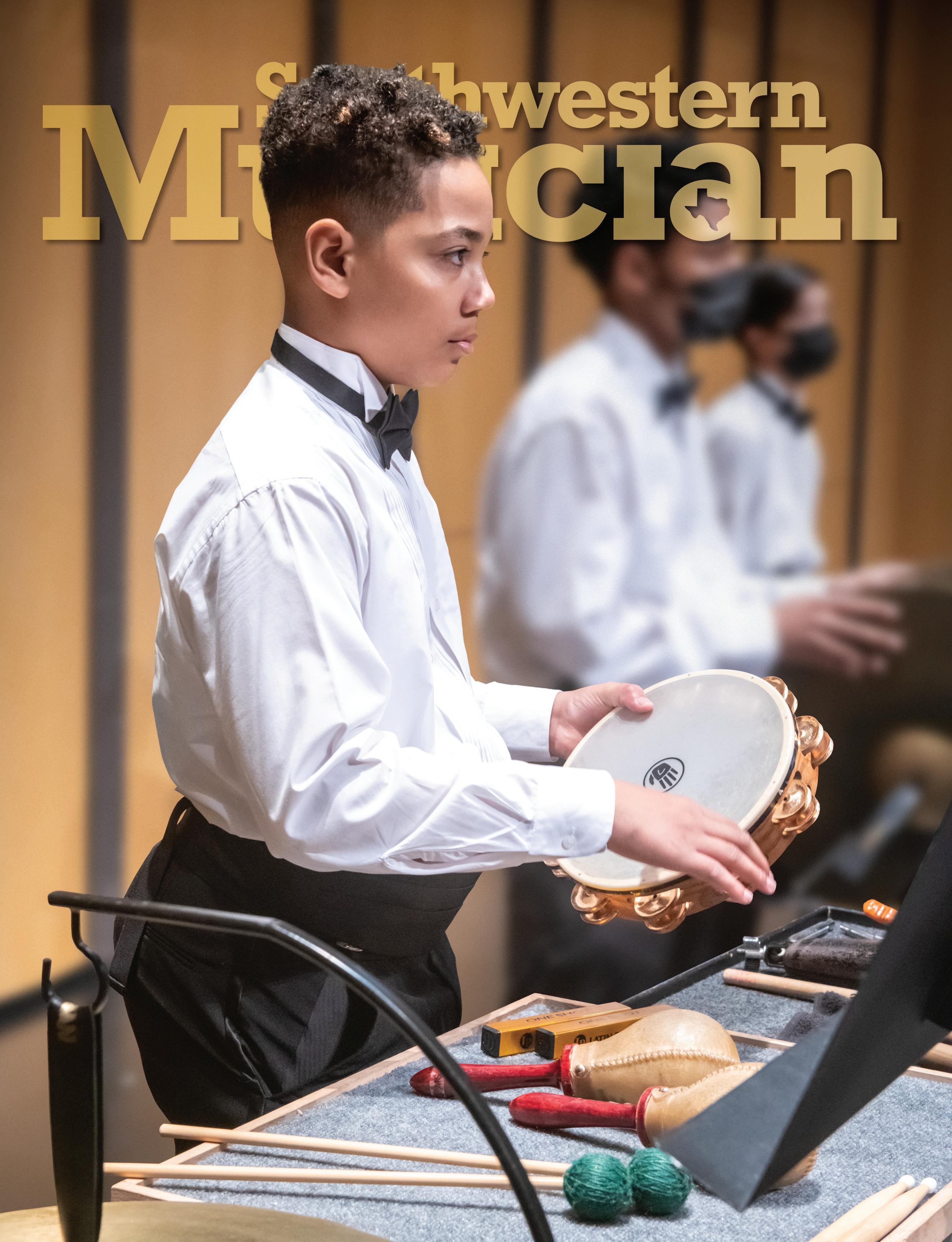
FEBRUARY 2023

many opportunities MUSIC COMMUNITY SCHOLARSHIPS ARE AVAILABLE TO ALL STUDENTS, REGARDLESS OF MAJOR! SCHOOL OF MUSIC The HSU School of Music is an accredited Institutional Member of the National Association of Schools of Music. MUSIC MAJORS EDUCATION WORSHIP LEADERSHIP PERFORMANCE BUSINESS COMPOSITION ENSEMBLES CHOIR & MUSICALS BAND & ORCHESTRA JAZZ ENSEMBLE TRAVEL RECENT TRIPS: ITALY, IRELAND, & NEW ORLEANS LEARN MORE / SCHEDULE AN AUDITION: www.hsutx.edu/music 2022-23 MUSIC SCHOLARSHIP AUDITIONS Feb. 17-18 | Mar.31-Apr.1
by eric allen
eimandoust
A mariachi program can help your students build cultural connections and musical independence. Learn the basics for starting a program and begin advocating with your administration to incorporate this instruction in your curriculum.
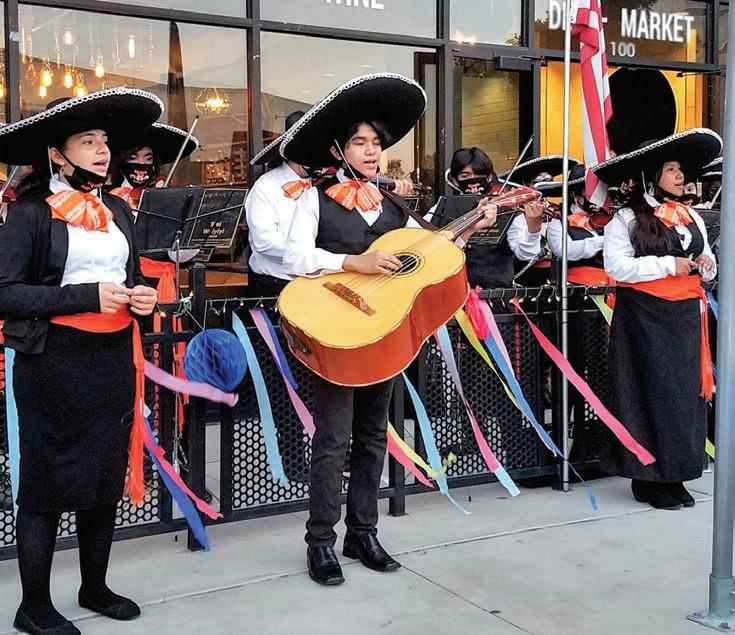 by michelle christner and
griswold
by emily lucas , elaine waier , and lisa trewin
by michelle christner and
griswold
by emily lucas , elaine waier , and lisa trewin
1 Southwestern Musician February 2023 CONTENTS VOLUME 91 ■ ISSUE 7 FEBRUARY 2023 ON THE COVER: Austin Sinegal, now a ninth grader at Dulles HS (Fort Bend ISD), performs with the Dulles MS Full Orchestra during the 2022 TMEA Clinic/Convention. Photo by Karen Cross. 37
Approaches
to Artistic Ensembles . . . . . . . . . . . . . . . . . . . . . . . . . 24
Practical
that Lead
and musical
Starting a Mariachi Program from Scratch . . . . . . 37
nadia
Focusing on precision, sound,
interpretation can set us up well in our pursuit of leading ensembles toward artistry.
by
Three Rs of Small School Choir Success . . . . . . 46
will
if you don’t
Building Music Extensions with a T-TESS Mindset . . . . . . . . . . . . . . . . . . . . . . . 56
Even
teach at a small school, you may be in a similar situation where this focus on repertoire, rehearsals, and rapport can help your program’s long-term success.
Transform your ideas about T-TESS in a way that you can utilize its concepts to help improve student engagement and empowerment. Creating Your Convention CPE Record ..........................2 2023 TMEA President’s Concert ............................... 6 2023 Clinic/Convention: Know Before You Go .................... 15 President Michael Stringer . . . . . . . . . . . . . . . . . . . . . . . 4 Executive Director Robert Floyd ................. 10 Band Vice-President Shane Goforth ............. 17 Orchestra Vice-President Ann G. Smith.......... 30 Vocal Vice-President Jesse Cannon II ............ 42 Elementary Vice-President Katherine Johns ..... 52 College Vice-President Matthew McInturf ....... 62 FEATURES UPDATES COLUMNS
Editor-in-Chief: Robert Floyd rfloyd@tmea.org | 512-452-0710, ext. 101
Managing Editor: Karen Cross kcross @tmea.org | 512-452-0710, ext. 107
TMEA Executive Board
President: Michael Stringer, Mesquite ISD mstringer@mesquiteisd.org | 972-882-7300
3511 Lake Champlain Drive, Arlington, 76016
President-Elect: Dana Pradervand-Sedatole, University of Houston pradervandd@yahoo.com | 713-743-3627
3606 Glenwood Springs Drive, Kingwood, 77345
Past-President: John Carroll, Monahans HS johnwoodromecarroll@gmail.com | 432-553-2780
809 South Betty Avenue, Monahans, 79756
Band Vice-President: Shane Goforth, North Shore Senior HS sgoforth@galenaparkisd.com | 713-516-7158
14122 Wadebridge Way, Houston, 77015
Orchestra Vice-President: Ann G. Smith, Plano East Senior HS ann.smith@pisd.edu | 469-752-9237
3000 Los Rios Boulevard, Plano, 75074
Vocal Vice-President: Jesse Cannon II, Fort Worth ISD vocalvp@tmea.org | 817-814-2635
1407 I.M. Terrell Circle South, Suite 2203-Room 02, Fort Worth, 76102
Elementary Vice-President: Katherine Johns, Floresville South Elementary kjohns@fisd.us | 830-393-5325
116 Oaklawn Drive, Floresville, 78114
College Vice-President: Matthew McInturf, Sam Houston State University mcinturf@shsu.edu | 832-515-8724
17 Hornsilver Place, The Woodlands, 77381
TMEA Staff
Executive Director: Robert Floyd | rfloyd@tmea.org
Deputy Director: Frank Coachman | fcoachman@tmea.org
Administrative Director: Kay Vanlandingham | kvanlandingham@tmea.org
Advertising/Exhibits Manager: Zachary Gersch | zgersch@tmea.org
Membership Manager: Susan Daugherty | susand@tmea.org
Communications Manager: Karen Cross | kcross @tmea.org
Financial Manager: Cristin Gaffney | cgaffney@tmea.org
Information Technologist: Andrew Denman-Tidline | adenman@tmea.org
Administrative Assistant: Rita Ellinger | rellinger@tmea.org
TMEA Office
Mailing Address: P.O. Box 140465, Austin, 78714-0465
Physical Address: 7900 Centre Park Drive, Austin, 78754
www.tmea.org | Phone: 512-452-0710
Creating Your Convention CPE Record
Almost every clinic and concert qualify for continuing professional education credit (CPE). CPE credit is available only to TMEA Active members, Honorary Life members, and out-of-state attendees who register and attend the convention. College Student and Retired members will not have access to create CPE records.
TMEA provides an online method for creating your CPE record after the convention. Follow these steps so that you will be prepared to return from the convention and complete your record.

1. During the convention: Keep track of all sessions you attend in their entirety. Active membership, convention registration, and attendance is required for CPE credit to be granted.
2. When you return home: Go to tmea.org/cpe to access your record and claim the sessions you attended and print your CPE form. Submit one to your school district and keep a copy for your records.
www.tmea.org/convention
using
Hours:
8:30 a
m
–4:30 p. m
Southwestern Musician (ISSN 0162-380X) (USPS 508-340) is published monthly except March, June, and July by Texas Music Educators Association, 7900 Centre Park Drive, Austin, TX 78754. Subscription rates: One Year – $20; Single copies $3.00. Periodical postage paid at Austin, TX, and additional mailing offices. POSTMASTER: Send address changes to Southwestern Musician, P.O. Box 140465, Austin, TX 78714-0465. Southwestern Musician was founded in 1915 by A.L. Harper. Renamed in 1934 and published by Dr. Clyde Jay Garrett. Published 1941–47 by Dr. Stella Owsley. Incorporated in 1948 as National by Harlan-Bell Publishers, Inc. Published 1947–54 by Dr. H. Grady Harlan. Purchased in 1954 by D.O. Wiley. Texas Music Educator was founded in 1936 by Richard J. Dunn and given to the Texas Music Educators Association, whose official publication it has been since 1938. In 1954, the two magazines were merged
the name Southwestern Musician combined with the Texas Music Educator under the editorship of D.O. Wiley, who continued to serve as editor until his retirement in 1963. At that time ownership of both magazines was assumed by TMEA. In August 2004 the TMEA Executive Board changed the name of the publication to Southwestern Musician. OFFICIAL PUBLICATION OF
Website:
Office
Monday–Friday,
.
.
.
TEXAS MUSIC EDUCATORS ASSOCIATION
2 Southwestern Musician February 2023
EVEN TEACHERS NEED TEACHERS
As an educator, one of the most impactful ways to improve is by educating yourself. That’s why the Yamaha Educator Suite (YES) helps music teachers access professional development opportunities, music teacher resources, program health support, advocacy assistance and more. YES brings you a network of like-minded teachers, experts and professionals, who want to help you achieve your goals. Let us help you raise the bar. Go to Yamaha.io/educatorsSWM
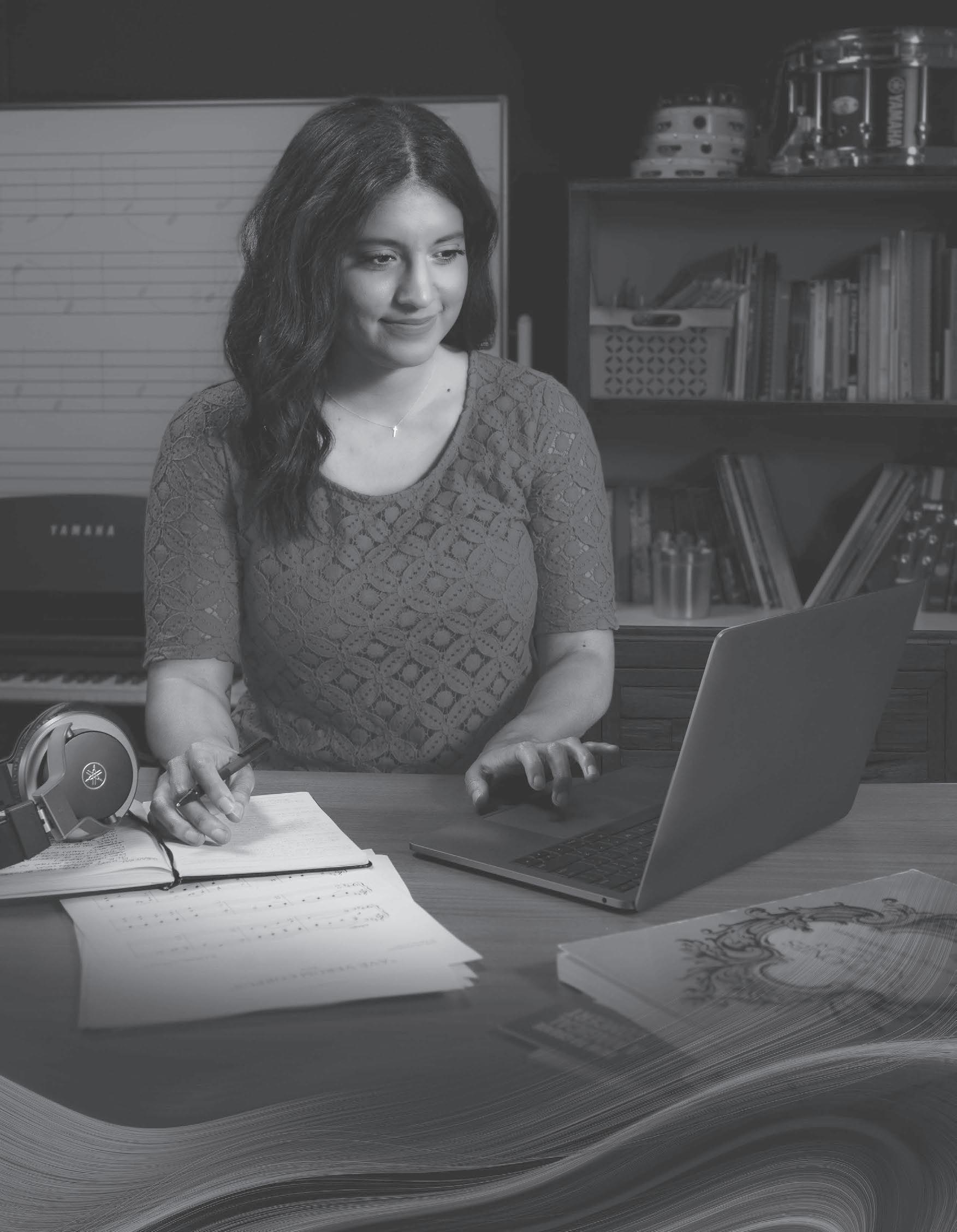
TMEA President
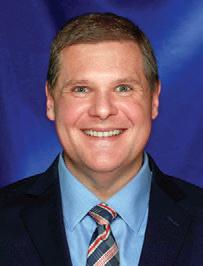 MICHAEL STRINGER
MICHAEL STRINGER
TMEA Today
As my time serving as TMEA President comes to an end, I thought it prudent to write about our amazing association. Early in my career, I viewed TMEA as an audition process to recognize outstanding students and a convention that offered the best professional development that I received all year. As I grew in the profession, I realized that TMEA was those things and so much more. Today, I can’t help but reflect on how TMEA has had an impact on my professional and personal lives in more ways than I could have ever imagined.
TMEA’s Impact
While serving on the Executive Board, the extent of TMEA’s influence on music education in our state has become so much clearer to me. TMEA leaders are constantly working behind the scenes to advance arts education for every student. Whether advocating for fine arts requirements at every level, fighting for a better certification process for preservice teachers, or talking with legislators about how rigorous arts instruction is part of educating the entire student, our association leads the charge to ensure our students experience the most complete arts education possible. TMEA doesn’t just serve members well at the state level, the impact at the local level can also be recognized. Over the years,
MARK YOUR CALENDAR
February—Renew your membership and register for the convention.
February 8–11 —TMEA Clinic/Convention in San Antonio.
February 9, 8:15 a.m.—TMEA General Session in Lila Cockrell Theatre.
February 9, 5:15 p.m.—TMEA Division business meetings at the convention.
February 10, 5:15 p.m.—TMEA Region meetings at the convention.
March 1 —Texas Music Scholar online application opens.
TMEA is as strong today as it has ever been, and I encourage each of you to continue to serve and find new ways to help it grow even more so it can fulfill its mission.
check www.tmea .org for updates 4 Southwestern Musician February 2023
STUDY MUSIC at
Programs in

Church Music
Music Education
Music Business
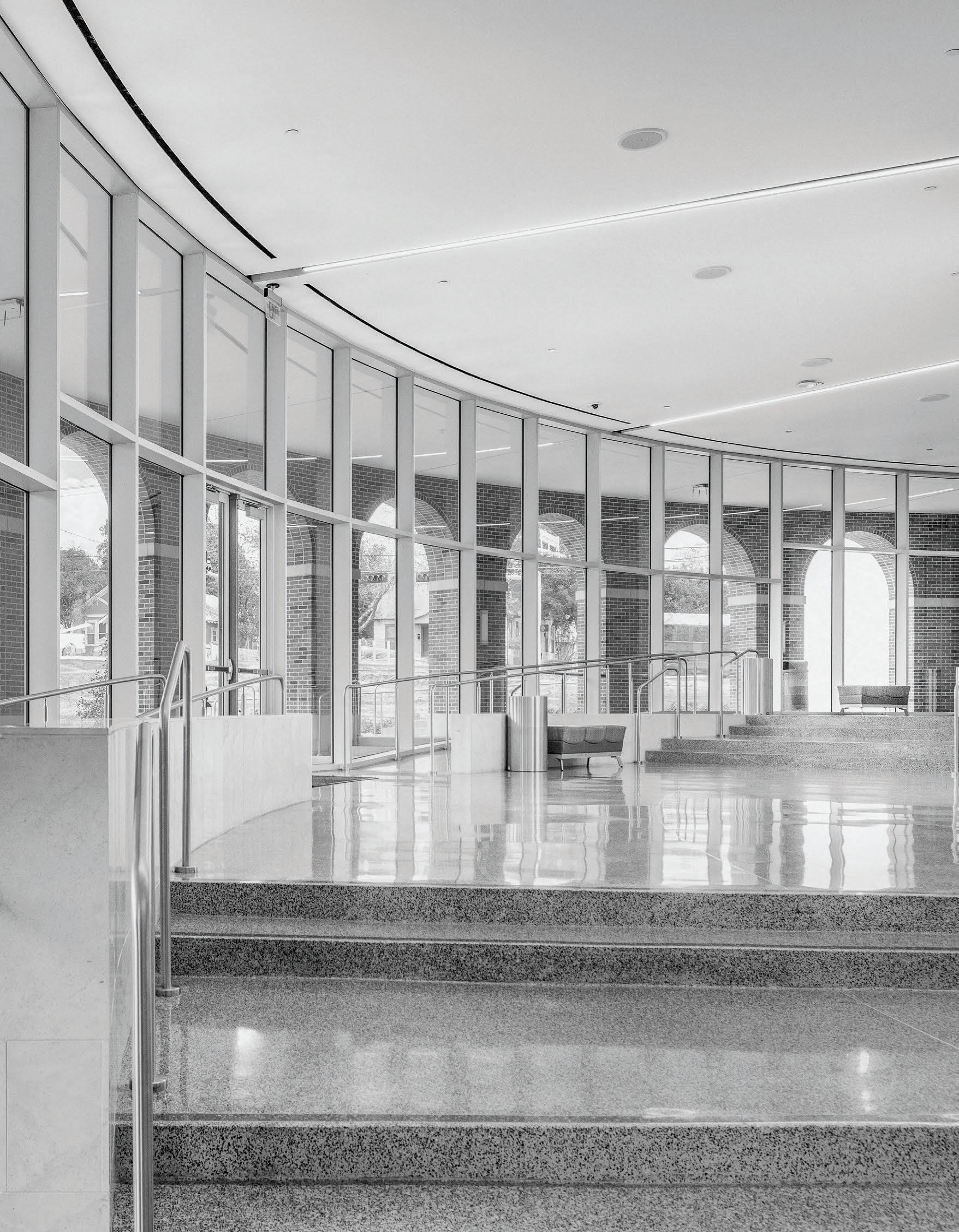
Worship Technology
Performance
Music Scholarships Available up to FULL TUITION
2023 auditions
January 28 | February 25
April 1 | April 22
For more information
music@umhb.edu | umhb.edu/music

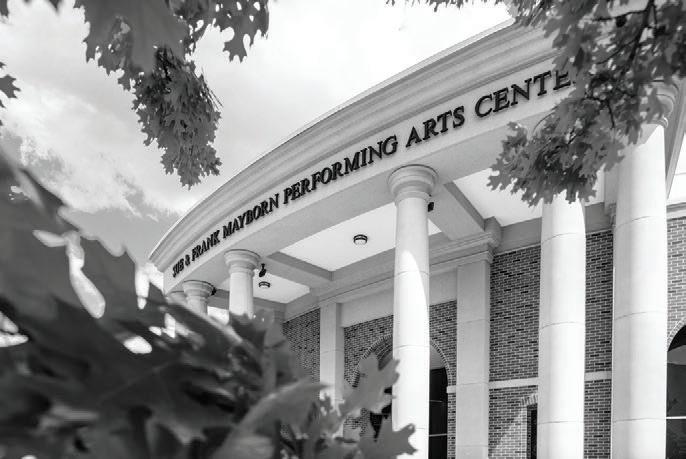
our outstanding staff has produced some incredibly compelling advocacy materials. From videos to peer-reviewed journal articles that show how music affects students in multiple facets of their education, the materials are truly one of a kind and are so easy to find on the TMEA website at www.tmea.org/advocacy.
A Staff Committed to Music Education
One only needs to pick up the phone and talk with an amazing staff member in the office to understand the complete dedication each of them has to music education. As I have served on the Executive Board and visited the TMEA office numerous times, I can say without hesitation that music education is at the forefront of every decision made by the staff. Even before serving on the Board, I found it necessary to call different staff members on many occasions, sometimes just asking for advice on how to handle certain situations. Every time I called, I found a compassionate person on the other end of the line willing to listen and offer advice on a variety of topics. I am humbled to say that I know the amazing people who work tire-
lessly to make our association function. I encourage each of you to seek out a staff member at our upcoming convention and thank them for all they do to make our association great!
Relationships
One of my columns I have received the greatest feedback on was titled “Relationships are Everything.” As I now look back at the end of my term as President, I can say that the title of that article resonates with me even more now than it did when I wrote it. I place great value in the relationships I have forged because of this amazing association. Had I never chosen to serve, I would have missed out on meeting some of the greatest people that I have ever known. From those who have served both in the roles of VicePresident and President, I know they are always there for me and willing to jump in to help in any possible way.
As I think about these lasting friendships, I also am led to remember that most of the lasting professional relationships I have can be traced back to TMEA in one way or another. I can never overstate how important the mentoring aspect of our

profession is and I challenge each of you who reads this column to become either a mentor or a protégé—you never know when you will find a relationship that will become one of your most cherished and deepest friendships.
Professional Development
Of course, one of TMEA’s biggest strengths is the amazing professional development offered to our membership. Each year, I am so thankful for the learning opportunities that are directly relevant to the work that I do each day. After serving on the Executive Board, I can attest to the immense effort dedicated to creating each convention program so every attendee leaves with new tools to try in their classrooms immediately. It is because of this work that I have never missed a TMEA convention in my 27 years as a member. Every year I have learned something new that has either made my job easier or less stressful or that gave me a new way to teach something so my students would finally have that aha moment. There is absolutely nothing that can replace the amazing education we receive from our association.
2023 President’s Concert
February 8 8:00 P.M. Lila Cockrell Theatre Free Admission/ No Tickets Featuring the U.S. Air Force Band Singing Sergeants from Washington D.C. 6 Southwestern Musician February 2023
Wednesday,
YOUR FUTURE




Scan the code for our Concert Calendar!
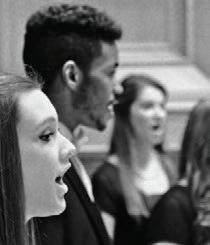
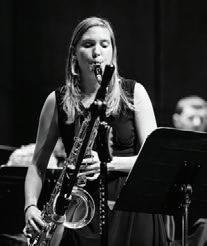
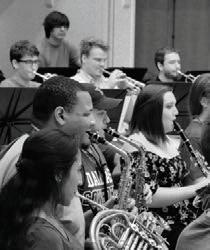
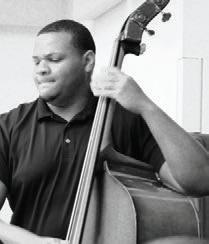
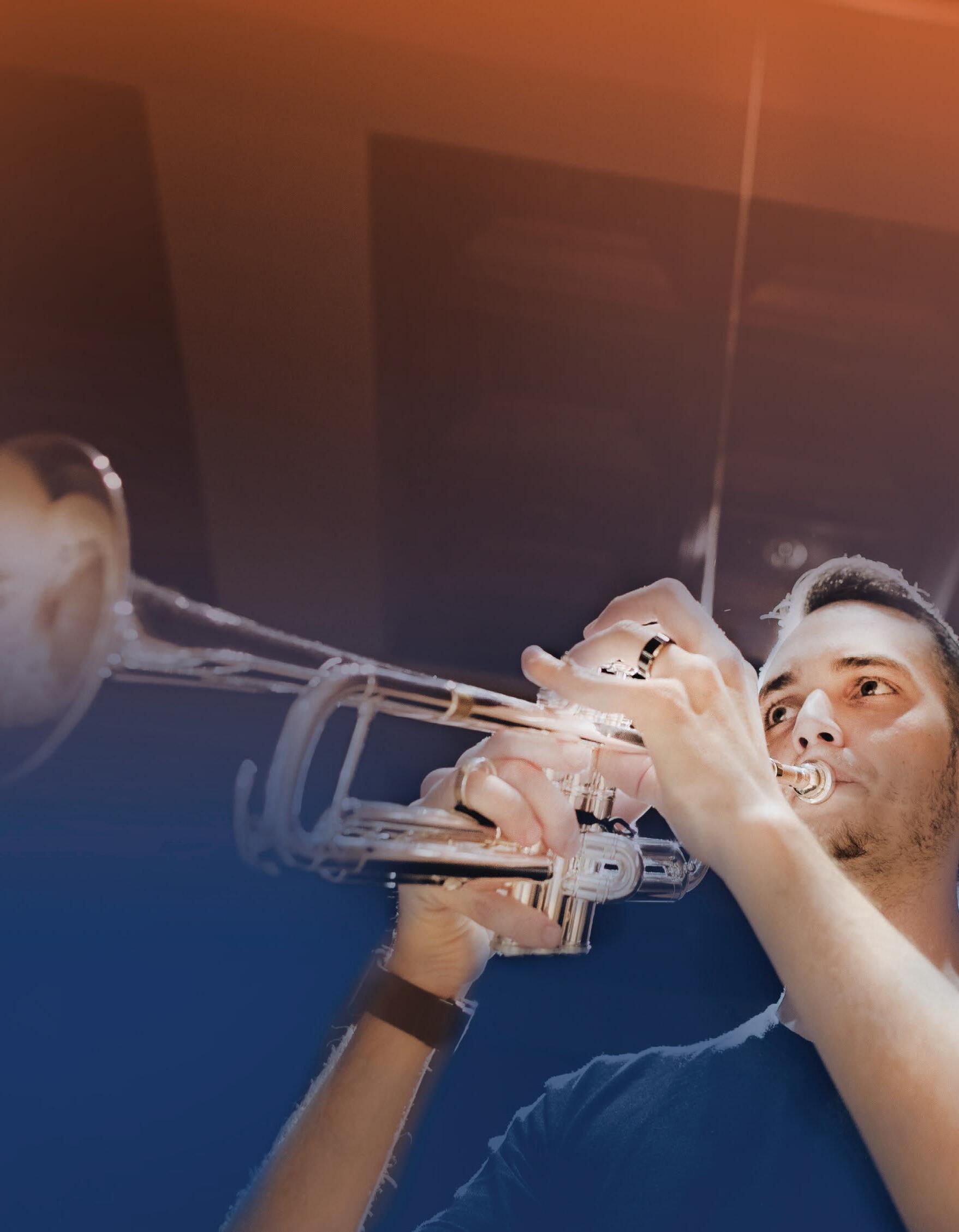
Dates uttyler.edu/music/admissions/auditions
SAY HELLO TO VANDERCOOK WHERE THE MOST INSPIRED MUSICIANS BECOME THE MOST INSPIRING MUSIC TEACHERS
UNDERGRADUATE PROGRAMS
• Bachelor of Music Education (BMEd)
• Bachelor of Music in Performance & Pedagogy (BMped)
• Bachelor of Music Pre-Certification (BMpc)
Scan this code to request information about our undergraduate programs, scholarship opportunities and financial aid
UPCOMING DATES
• Visit & Audition Day
February 7, 2023
• VanderCook Scholars Program*
Final Deadline February 15, 2023
• VanderCook Scholars Announced
March 1, 2023
vandercook.edu
• Visit & Audition Day
March 7, 2023
• Junior Visit Day
April 14, 2023
• Decision Day
May 1, 2023
*High school seniors accepted into the Scholars Program receive a four-year FREE tuition scholarship
Recognition
TMEA also promotes outstanding music education through recognition. In just a couple of weeks, some of the recognition we offer will be on full display in San Antonio. We will be joined by All-State musicians, invited ensembles, Honor Bands and Orchestras, demonstration groups, and music showcase performers. Each of these students will perform their hearts out because of the avenues of recognition TMEA affords our states’ musicians. However, convention recognition is not the only avenue we pursue to advance music education. Go to our website under the Programs menu to learn more about our Texas Music Scholar program, which seeks to recognize outstanding high school students, and the Distinguished Administrator Award, which recognizes outstanding administrators who actively advance music in their schools or districts.
The Membership
I believe TMEA’s absolute biggest strength is the membership itself. Our members make this organization everything it is today and everything it will be tomorrow. Without members who volunteer in leadership roles as Region Chairs, Area Chairs, State Board members, and Executive Board members, our organization would crumble.

Additionally, the hundreds who volunteer to run Region events and our annual convention are central to our success. These wonderful, selfless people keep our association strong and can never be thanked enough for their tireless service to our profession.
Our members volunteer without expectation of payment so they can give back to the organization that has given all of us so much during our careers. I am constantly awed by the number of members who are willing to help in every task that needs to be accomplished.
As I finish my term as President, I remain humbled by our association. TMEA is as strong today as it has ever been. I encourage each of you to continue to serve and find new ways to help it grow even more so it can fulfill its mission to provide every child with a complete and outstanding music education in every school in Texas. 0
9 Southwestern Musician February 2023
TMEA Executive Director
ROBERT FLOYD
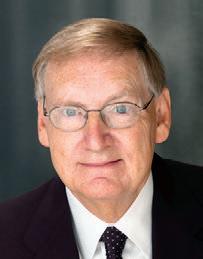
Where Passion Meets Purpose
Through the years we have been fortunate to have amazing keynote speakers present at our general sessions during the convention. Names such as New York Times best-selling author Dan Pink, David Pogue from CBS Sunday Morning fame, The Piano Guys, James Galway, Carl St.Clair, and Eric Whitacre come to mind. But none has made a more profound impact on us than the brilliant Sir Ken Robinson, British author, speaker, and international advisor on education in the arts to government, nonprofit, educational, and arts bodies around the world. In addition to his numerous books on the role of creativity in education, he is known for delivering the TED Talk entitled “Do Schools Kill Creativity?” which has become the most watched video since the inception of the TED Talk program. I highly encourage you to watch it. It will remind you to make creativity a priority in your teaching strategy as you enter your classroom each day—his delivery and wit are unmatched!
We were fortunate to have Sir Ken present at our convention on two occasions, each time speaking on the role of creativity in the educational process, and how that experience is anchored in the arts. In Sir Ken’s TED Talk he stated that creativity is as important as literacy in educating our children. Sadly, we lost him to cancer at a much too early age, but through his writings we have wonderful resources to continue to guide us.
This time of the school year can lead to much soul-searching for some educators as thoughts creep in about whether teaching is really the pathway they want to continue as a career. Ten years ago, I downloaded
MARK YOUR CALENDAR
February—Renew your membership and register for the convention.
February 8–11 —TMEA Clinic/Convention in San Antonio.
February 9, 8:15 a.m.—TMEA General Session in Lila Cockrell Theatre.
February 9, 5:15 p.m.—TMEA Division business meetings at the convention.
February 10, 5:15 p.m.—TMEA Region meetings at the convention.
March 1 —Texas Music Scholar online application opens.
Your element is enhanced when it nurtures within you a greater sense of purpose. Having a purpose in life is the wellspring of sustained happiness.
—Sir Ken Robinson
10 Southwestern Musician February 2023
check www.tmea .org for updates
TXST Summer 2023 Camps
June 3-10 Texas State International Piano Festival (TSIPF)
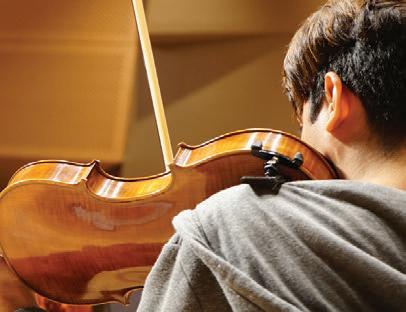
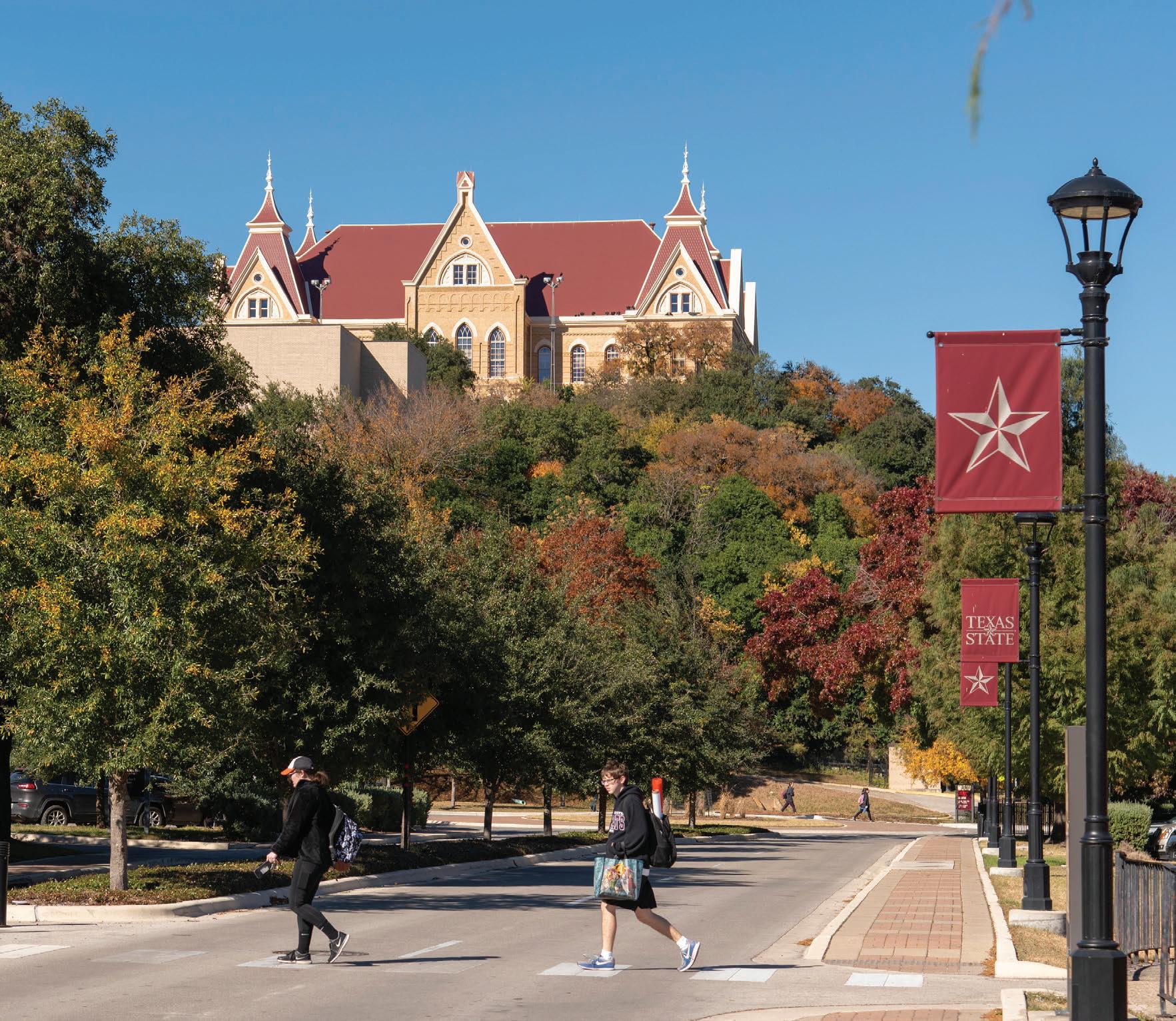
June 11-16 Band Camp
June 18-24 String Camp
June 19-24 Choral Symposium
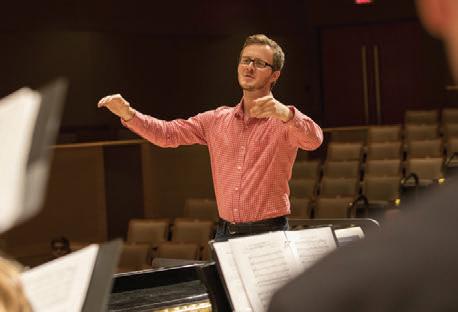
June 25 Alumni Choir
June 25-30 Marching Percussion Camp
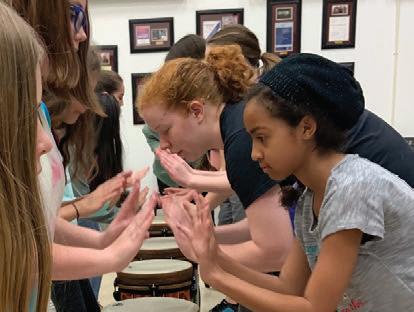
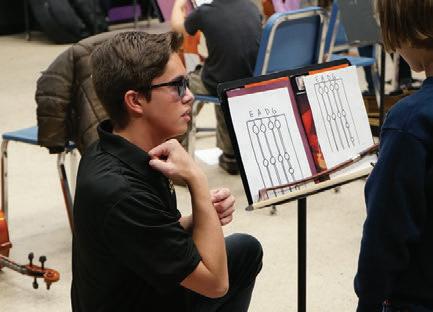
July 3-6 Choir Camp
July 9-14 Opera Camp
music.txstate.edu Texas State University, to the extent not in conflict with federal or state law, prohibits discrimination or harassment on the basis of race, color, national origin, age, sex, religion, disability, veterans’ status, sexual orientation,gender identity or expression. Texas State University is a tobacco-free campus.

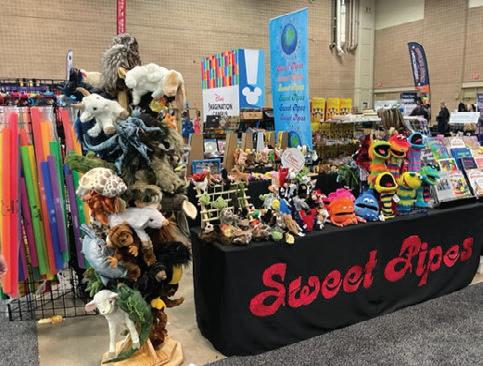
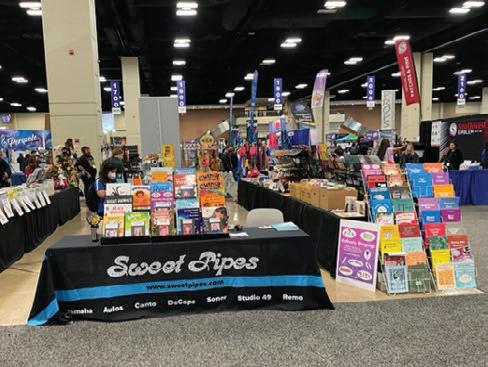
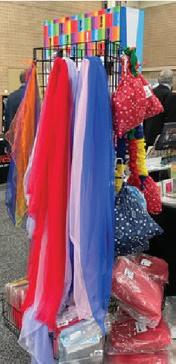
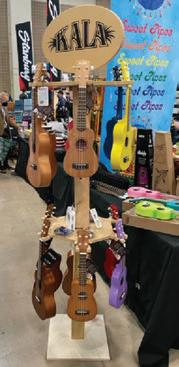
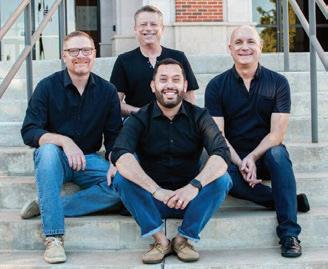

Come visit us at TMEA and register to win fabulous giveaways including Sweet Pipes gi� cards! Booth 1332 www.sweetpipes.com 817-277-9922 sales@sweetpipes.com 12 Southwestern Musician February 2023
Sir Ken’s book Finding Your Element, and recently, as the percentage of teachers dropping out of the profession has become so critical, I began rereading it. This book speaks to where natural aptitude meets personal passion and helps us understand how to be happy in our work, especially if we find ourselves having lost our initial passion for it. One chapter is dedicated to the topic of happiness, while another focuses on our attitude and whether it is holding us back or moving us forward. Robinson is clear that this book is not meant to be a practical guide for chang-
Martin Seligman’s Authentic Happiness, he states, “Feeling you are doing something meaningful does not guarantee happiness, but it tends to be difficult to find happiness unless you feel that what you are doing is significant in some way.” All educators have that opportunity, especially those who teach music.
Robinson describes at length in another chapter how one’s attitude impacts their element and that finding their element is not only about aptitude and passion. Similarly, in an earlier book he quoted a line from Shakespeare’s Hamlet : “There
is nothing either good or bad but thinking makes it so.” Of all the areas Robinson looks at—aptitudes, learning styles, and passion—none is more complex than disposition and attitude. Nothing has more impact on our element than how we react to barriers thrown at us; in our case that might be an unsupportive administration, a budget shortage, scheduling dilemmas, etc. Temperament, disposition, and character can change as well and reframe how one sees different situations. In short, how happy we are in our job is influenced by how we respond to challenges we face.
FORT WORTH ISD VISUAL & PERFORMING ARTS
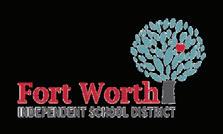

@fwisdvpa 13 Southwestern Musician February 2023
TMEA for many years has offered a mentoring program to help teachers experience success by pairing a less experienced teacher with a more experienced one, hopefully contributing to longevity in the profession for the mentee. Robinson suggests a key to similar success is identifying our tribe of people who share our interests and passions. While mentors tend to provide support more pedagogical in nature, tribal benefits include support through affirmation, guidance, collaboration, and inspiration from those more like us. The genesis of such a group can begin in your district, your TMEA Region, or through social media. The Young Band Directors of Texas has been a trailblazer for such connections, and I

encourage you to follow their lead. You may recall reading in last April’s Southwestern Musician quotes from our members who shared that they were thinking about leaving the profession, but after attending the convention, they returned to the classroom with a new burst of enthusiasm and motivation, inspired to continue. If you are not planning to attend this year’s convention, I hope you will reconsider. Secondly, if you are considering leaving the profession, I hope you will remember that teacher who influenced you to pursue teaching music and reflect on that student in your classroom today whose life you have changed in a positive way, and you may not even know it. That student may even be considering following
2023 TMEA Clinic/Convention

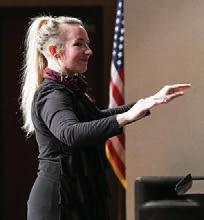
February
8–11

See you in San Antonio!
Find your song.
Located in Kerrville, TX, Schreiner University helps students Achieve More with a Bachelor of Arts in Music. Lessons are offered to both majors and non-majors in guitar, voice, band/orchestra instruments, and piano. Scholarships are available for majors and non-majors for performing in:
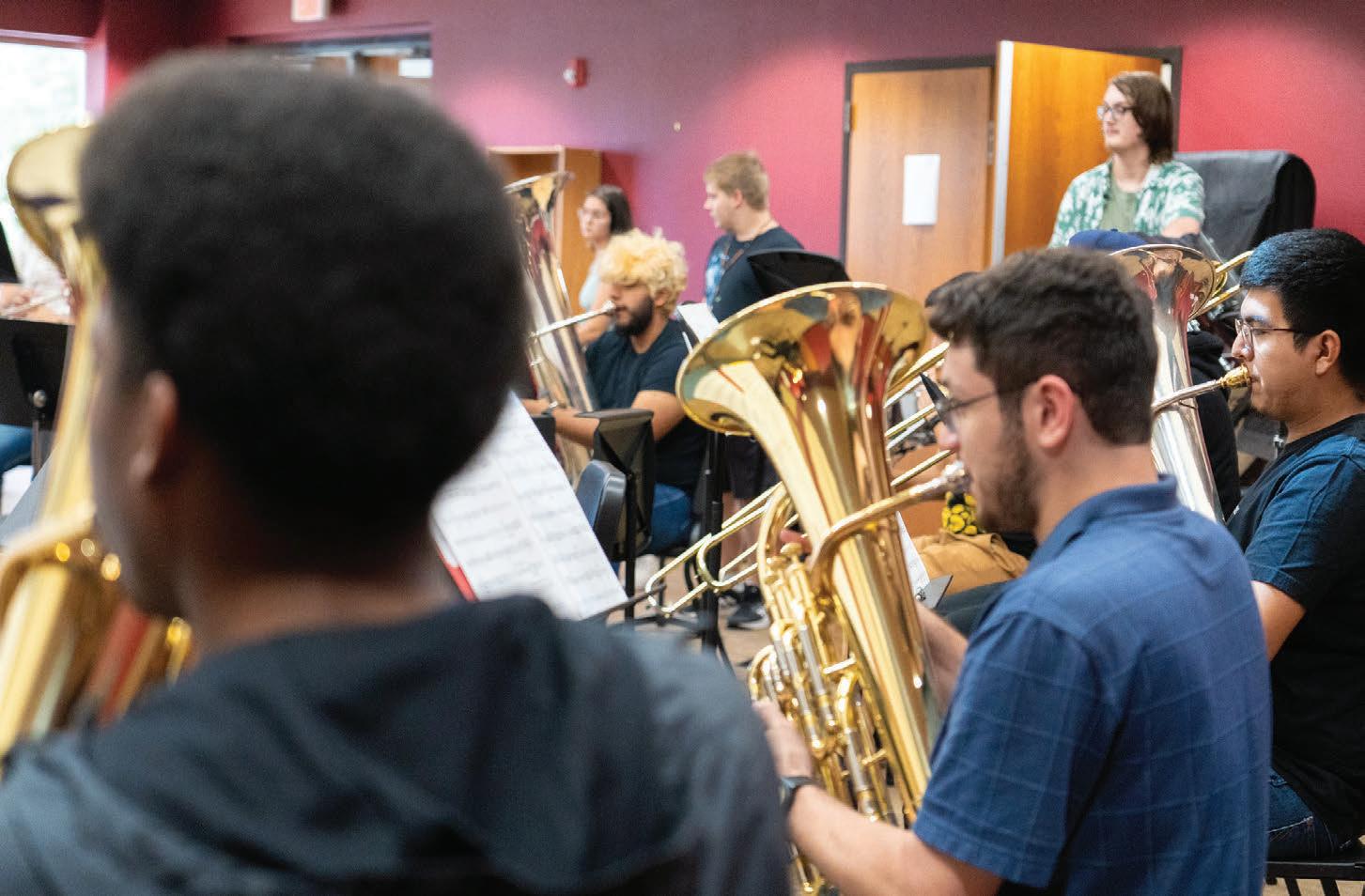
• Concert Band
• Athletic Band
• Concert Choir
• String Orchestra
• Symphony of the Hills
For more information on programs, auditions, and scholarships, visit us at schreiner.edu/music
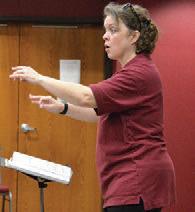

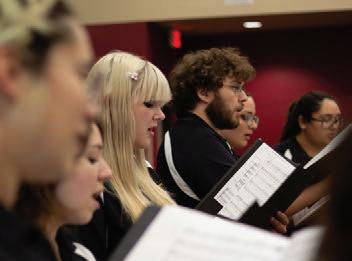
in your footsteps as a music educator. No teacher should be condemned or shamed for considering a profession change during the aftermath of the pandemic and the ongoing attacks on public education. In many ways it has been devastating, but I have also talked with teachers who decided to abandon teaching too hastily. Sir Ken Robinson ends his book with a final chapter entitled “Living a Life of Passion and Purpose.” In this chapter he quoted an unknown source that said whenever you see the dates of someone’s life, the most important part is the dash in the middle.
Quoting Joseph Campbell’s writings in The Hero’s Journey, “A good life is one hero journey after another. There is always the possibility of a fiasco. But there is also the possibility of bliss.” In changing children’s lives through music, the odds are in our favor it is the latter.
I look forward to seeing you soon in San Antonio in a spirit of rejuvenation to continue in our element in music at an even higher level for each of us. 0
14 Southwestern Musician February 2023
February 8–11
• Henry B. González Convention Center • San Antonio
Know Before You Go
REGISTRATION HOURS
Wednesday: 1:00 p.m.–9:00 p.m.
Thursday: 7:30 a.m.–5:00 p.m.
Friday: 7:30 a.m.–6:00 p.m.
Saturday: 7:30 a.m.–1:00 p.m.
REGISTRATION FEES
• Active music educators: $95
• Retired music educators: $20
• College student members: $0 (included in $25 membership)
• Out-of-state attendees: $150
• Badge replacements: $10 each
Badge Pickup Location
Enter from the North Lobby of the convention center into Hall 1, near the main entrance that faces Market Street.
• PREPAID BADGE PICKUP: You can still register online. If you registered in advance, go to the Prepaid line (as you enter the hall, directly in front). Scan your registration barcode (emailed the week before) or look up your record by name. Your badge will print at the kiosk. Continue forward to pick up a program, prepaid family badges, and more.
• ONSITE REGISTRATION: If you haven’t registered when you arrive, go to the Registration line (to the left of the Prepaid line). Complete registration and payment (cash, check, or credit card) to obtain your badge, program, and more.
• TECHNOLOGY PRECONFERENCE: Go directly to the second floor of the convention center (south side) to the foyer of CC 214 to get your badge. This is a separate $50 registration (no POs). Checks must be made to TI:ME (do not combine with a TMEA registration check).
Onsite Payment
Visa, MasterCard, Amex, Discover, cash, or personal or school check (checks run same day) are accepted for onsite registration. Split payments cannot include a credit card.
Family Badges
Registered attendee family member badges are $15 each; children under 12 are free (family badges cannot be used by a music educator, music minister, musician, or college music student). Badges purchased online are provided when you pick up your convention badge. You can also purchase family badges when you complete onsite registration or later at the visitors booth.
Free President’s Concert!
This concert on Wednesday at 8 p.m. features the Singing Sergeants of the U.S. Air Force Band. To attend this free concert, go directly to Lila Cockrell Theatre (no tickets will be issued and seating is open).
$10 Daily Parking + Free Shuttle
Thursday–Saturday, park for $10 daily at the Alamodome Lot B (entry before 5 p.m.). TMEA provides free shuttle service from Lot B. You can also use the walkway from the north side of the Alamodome under I-37 to the convention center.
Get the 2023 Convention App
Go to your app store and search for TMEA to download our official app. To ensure you can access your schedule later or on another device, set up Multi-Device Sync in settings after opening the 2023 TMEA Clinic/Convention event in the app.
2023 TMEA Clinic/Convention
15 Southwestern Musician February 2023
EAST TEXAS BAPTIST UNIVERSITY
DEPARTMENT OF MUSIC AND THEATRE ARTS
PERFORMANCE OPPORTUNITIES
Concert Choir
Guitar Ensemble
Worship Ensembles
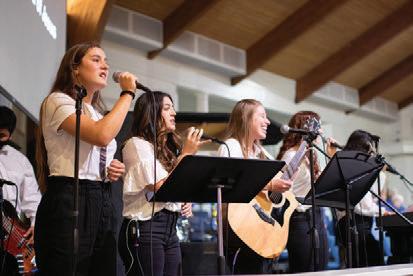
Musical Theatre

Percussion Ensemble

Vocal Ensembles

Symphonic Band
Brass & Woodwind Opera Workshop
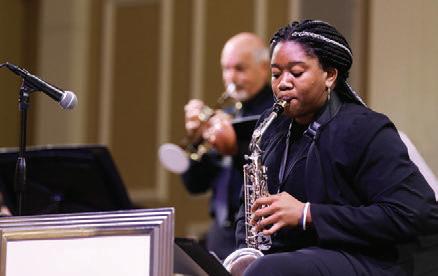
Marching Band
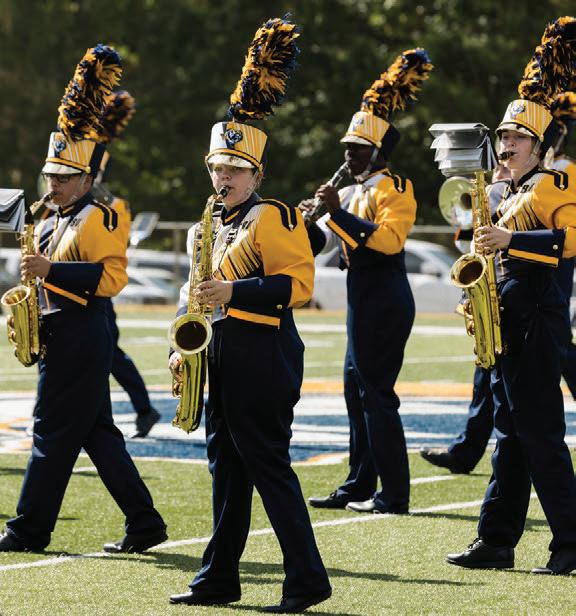
Jazz Band
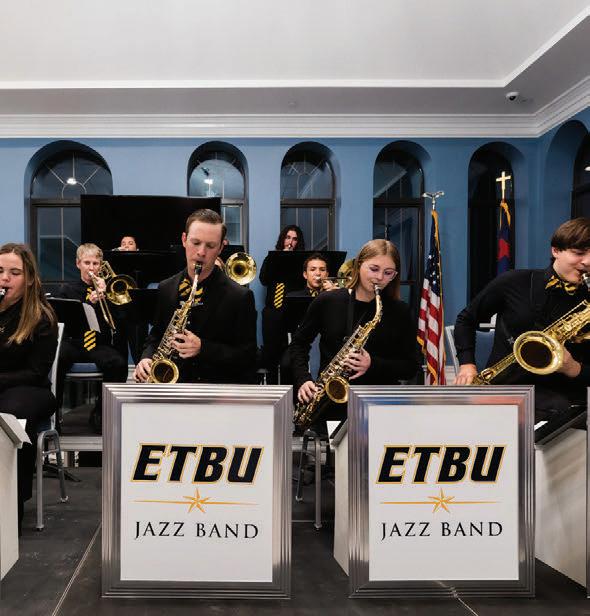
Women’s Choir
MUSIC DEGREES OFFERED
Music (B.A.)
All Level Music Education (B.M.)
Worship Studies (B.M.)
Musical Theatre (B.M.)
A CHRIST-CENTERED EXPERIENCE
East Texas Baptist University offers a life-changing experience in a Christ-centered community. Through the integration of biblical faith and academic learning, you will be transformed by the renewing of your mind. You will be challenged by our committed Christian faculty and staff to pursue God in all aspects of your life. As a graduate of ETBU, you will be prepared to stand as a pillar of influence in your calling for God’s glory.
www.ETBU.edu/Music | 903.923.2158 | music@ETBU.edu
TMEA Band Vice-President SHANE GOFORTH
Making Dreams Come True
We are artists making art and the sonic world is our creative palette. We dream of making, combining, and shaping sounds in such a way that hearts can be touched, minds can be stimulated, and souls moved.
In Memoriam
Carlos Luna 1958–2023
MARK YOUR CALENDAR
check www.tmea .org for updates
February—Renew your membership and register for the convention before arriving.
February 8–11 —TMEA Clinic/Convention in San Antonio.
February 9, 8:15 a.m.—TMEA General Session in Lila Cockrell Theatre.
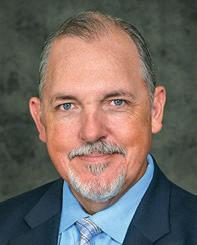
February 9, 5:15 p.m.—Band Division business meeting at the convention.
February 10, 5:15 p.m.—TMEA Region meetings at the convention.
March 1 —Texas Music Scholar online application opens.
Iremember the 2016 TMEA Clinic/Convention being an incredibly busy time for me. Committee meetings, volunteer responsibilities, marching band planning sessions, and more all fought for time in a convention schedule that featured multiple “no way I’m missing that” sessions occurring concurrently every hour.
As I navigated my way through the hectic schedule, I was determined to attend the Baylor University Wind Ensemble concert. Of course, the meeting I was in before the concert ran long, and on my walk to Lila Cockrell, I encountered several friends whom I dearly love and had not seen in far too long. With an overly congested schedule and my affinity for awesome people, I found myself egregiously tardy to Baylor’s performance.
I knew the theater would be packed, so I scampered up the stairs to the top balcony hoping to find a seat. While taking the stairs two at a time, I tried to convince myself it was okay to be late because the sound was always good up in the rafters. As I approached the doors, thunderous applause erupted and I simultaneously felt remorse for missing the performance that had precipitated such adulation, and joy. At least I could enter without further delay and experience the remainder of the music. If you’ve attended our convention before, you might have already guessed that there were no seats to be had and people were lined up along the railing just inside the door. At 6'5" tall, I could at least stand behind other concert goers slightly less tardy than I and enjoy the concert.
As Dr. Wilson began the next piece, his preparatory gesture was so deliberate I began to wonder if time had suspended, but then a glorious euphonium sound began to fill the hall, accompanied by a choir of reeds, and the opening phrase of Colonial Song began to capture every
17 Southwestern Musician February 2023
heart and soul in the room. I was mesmerized by the sonority of the individual tone qualities, melded together with such artistry and musicality. As the phrases began to swell, I felt like I was being elevated off the balcony and suspended above the audience, swimming in a sea of tonal resonance. As my artistic senses were enveloped by the sonic tapestry, my analytical mind turned to pedagogy.
When I walked into that balcony in February of 2016, I had been teaching 20 years, but I knew my ears were being educated in an entirely new way. The resonance of the tone qualities, the elegance of the balance, the sensitive prioritization of the individual line, the harmonic intonation and overtones all worked together to synthesize in novel ways my pedagogical thoughts about air, tone production, and ensemble skills. All the information I had gained from the awesome clinics I had attended and the sage counsel I had received gained new purpose and clarity through the live sonic experience.
On my return to our band hall, I taught with a new focus, concentrated on giving and getting more out of every moment I had with my students. I strove to give bet-
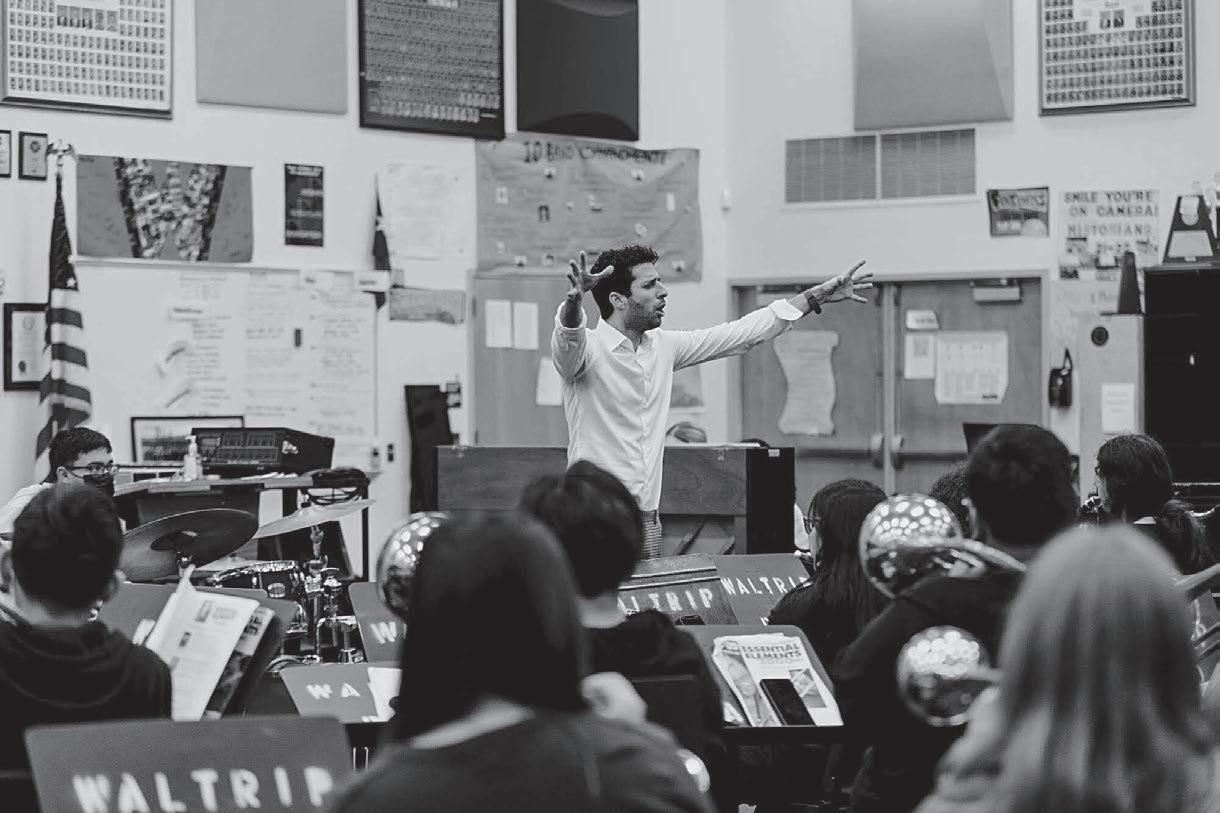
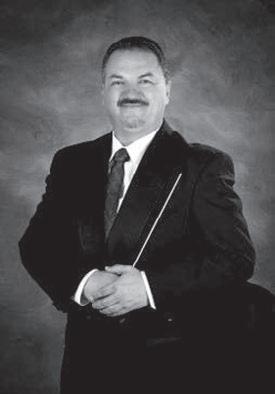
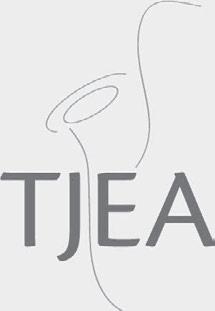

ter instruction to get more tone quality. I listened with more specificity so students could perform with better balance and intonation. I worked to understand more about my students, myself, and our repertoire—searching for the tools to sculpt musical phrases that would move hearts and minds as mine had been so moved.

brief moment, I began to wonder whether it really was as good as I recalled. But I know that regardless of their quality, no speaker sound can replace the experience of listening live. I do enjoy the recording, but nothing will ever compare with what I heard that day.
The impact of the experience and education I received from attending that Baylor concert had a profound effect on my ensembles’ music-making. Not only did we find more joy and connection in our pursuits, but our peers also began to recognize and award our performances in ways they never had before and at levels that had previously existed only in our dreams.
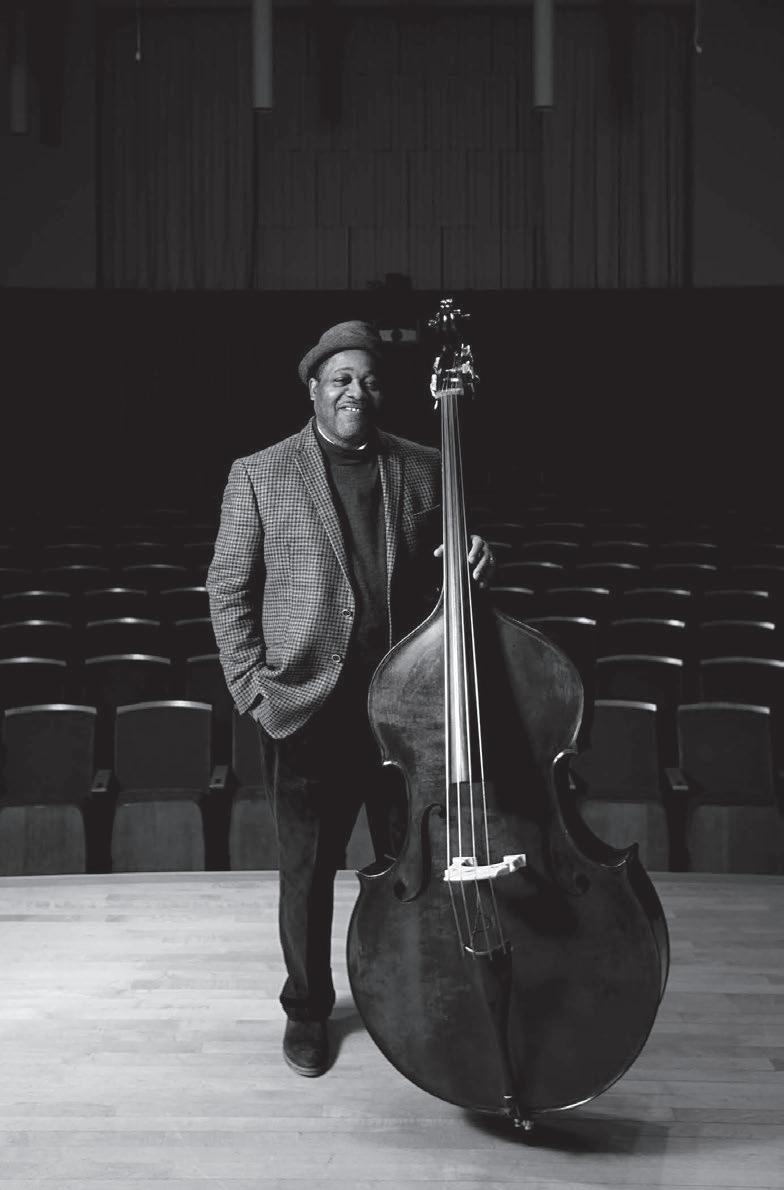
As I thought about writing this column, I realized that I had never listened to the recording of that performance. Ten seconds later I began listening to the recording on my laptop. I quickly realized those speakers were wholly inadequate and found my way to my office to listen on my studio monitors. While the sound quality improved, it was still a tragic disappointment compared to the version that resonates so clearly in my memory. For a
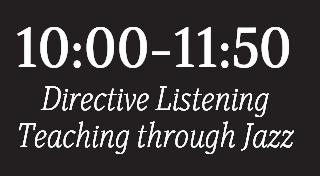

We are artists making art and the sonic world is our creative palette. We dream of making, combining, and shaping sounds in such a way that hearts can be touched, minds can be stimulated, and souls moved. In my humble opinion, there is no better place to experience that art than in the incredible atmosphere of inspired musicians playing in beautiful spaces for an audience of passionate music educators that is the TMEA Clinic/Convention. I urge you to join me and thousands of your colleagues in experiencing what I know will be the many beautiful, powerful, inspirational, and possibly life-altering performances shared at our convention that’s now just days away. These performances may very well be the impetus for your next dream, and what are great performances if not the realization of dreams? They are the dreams of the musicians, conductors, composers, publishers, 2 0 2 3
Symposium Symposium

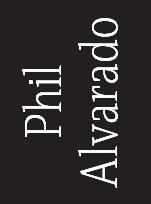


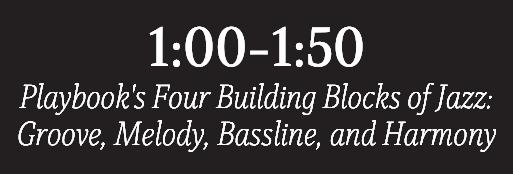

Register at TJEA.org Register at TJEA.org
Phil Alvarado
Retired Educator
Rodney Whitaker Director of Jazz Studies Michigan State University
Sammy Miller
18 Southwestern Musician February 2023
Sammy Miller and the Congregation Grammy-nominated Drummer & Educator
School of Music
2023 SUMMER MUSIC TCU School of Music
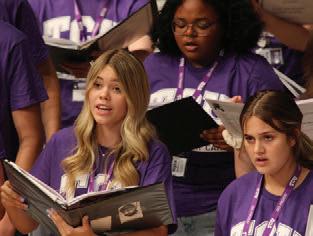

Camps & Workshops*
TCU STRINGS FESTIVAL • MAY 30 - JUNE 4 JULIETTE HERLIN, LIZ LEE
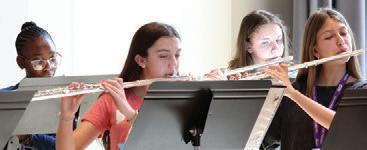
PERCUSSION CAMP • JUNE 6&7 BRIAN WEST, JEFF HODGE
TCU BAND CAMPS • JUNE 11-17 BOBBY FRANCIS, BRIAN YOUNGBLOOD
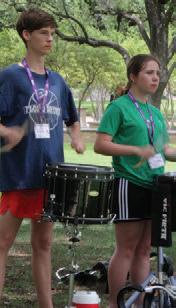
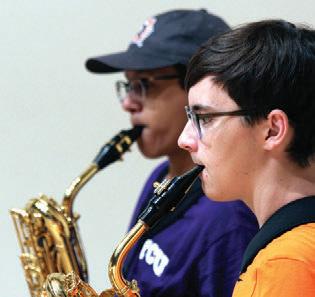
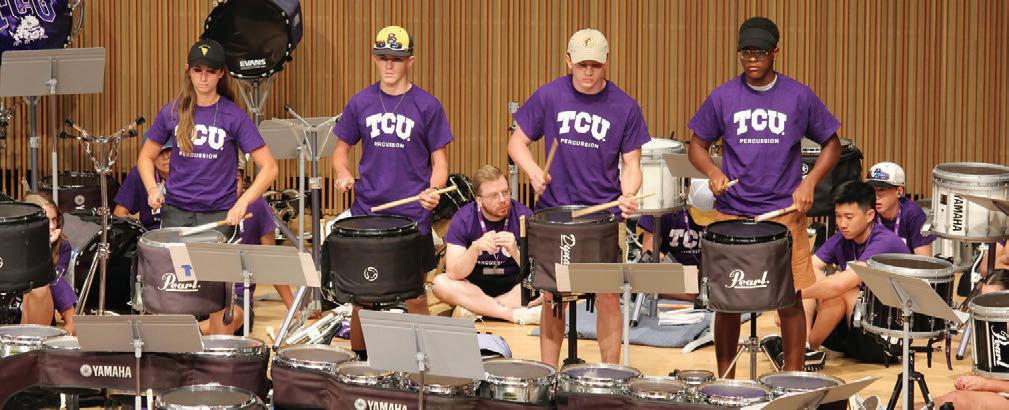

FLUTE WORKSHOP • JUNE 21&22 SHAUNA THOMPSON
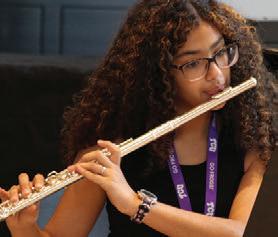
SAXOPHONE WORKSHOP • JUNE 21&22 TBA
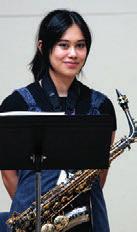
HARP WORKSHOP • JULY 5-7 KELA WALTON
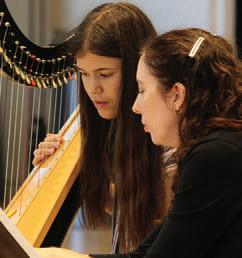
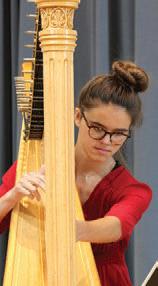
ALL-STATE CHOIR CAMP • JULY 9-15 CHRISTOPHER ASPAAS, MARLA RINGEL

CLARINET WORKSHOP • JULY 18&19 COREY MACKEY
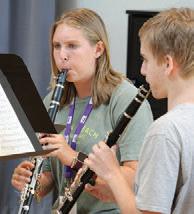
STAR WARS AND THE MUSIC OF JOHN WILLIAMS • JULY 17-20 PAUL CORTESE
FOR REGISTRATION INFO*, PLEASE VISIT OUR WEBSITE AT WWW.MUSIC.TCU.EDU/SMI.ASP
*ALL EVENTS SUBJECT TO CHANGE IN RESPONSE TO COVID-19
TEXAS LUTHERAN UNIVERSITY’S
JUNE 25 -JUNE 30, 2023
BAND, CHOIR, & ORCHESTRA
MIDDLE & HIGH SCHO O L BANDS
ACHIEVEMENT- BASED SCHOLARSHIPS AVAILABLE
FOR MORE DETAILS, EVENT UPDATES, AND TO REGISTER, VISIT TLU.EDU/SMA
concert hall designers, instrument manufacturers, and more, all coming together in one incredible moment of sonic harmony where we join together in a unique experience that can be recorded, but never replicated.
Honor Bands
Last month, we featured three of our four Honor Bands. Regrettably, we did not include our amazing 4A Honor Band Argyle HS Wind Ensemble in that issue, and I apologize for that omission.
Please extend your congratulations to Argyle HS Wind Ensemble and their director for this achievement, and be sure to include their performance (and all other Honor and Invited Band concerts) in your convention schedule!
This month, I’m also pleased to introduce our Invited Middle and High School Jazz Ensembles and our High School Percussion Ensemble.
Class 4A Honor Band Argyle HS Wind Ensemble
The Argyle HS Wind Ensemble, under the direction of Jason Bird, is humbled to perform at this year’s TMEA Clinic/ Convention. The Wind Ensemble is the premier instrumental ensemble at Argyle HS (Argyle ISD). Members of the program participate in the marching band, All-Region auditions, and solo/ensemble contests. Many students in the ensemble also participate in other activities, including cross country, football, choir, theater, debate, and UIL academics.
The ensemble has been awarded superior ratings at every UIL contest since its inception in 2000. Under the direction of Cindy Mikel, the ensemble was named the 2A TMEA Honor Band in 2006. In 2009, the ensemble was named the 3A TMEA Honor Band, under the direction of Kathy Johnson.
At Argyle, we work tirelessly to provide a safe, rigorous learning environment for all students. We are dedicated to our mission of empowering them to become ambitious, proficient, socially responsible citizens and leaders of tomorrow.
Hornedo MS Jazz Ensemble
Hornedo MS is in El Paso, located just below the Franklin Mountains. Under the direction of Elijah Ontiveros, the Hornedo Jazz Ensemble consists of individuals from all backgrounds and is focused on creating
independent learners and allowing students to express themselves and grow their love of music with a simple goal in mind: to sound good. Like many programs across the state, the Hornedo Jazz Ensemble came from humble beginnings. They started their program during the pandemic with 13 students learning online. The ensemble has grown and received superior ratings at the EPISD Jazz Festival and Hanks Jazz Festival. This is their first invitation to perform at a TMEA convention.
Taft HS Jazz Ensemble
In addition to marching, concert, and percussion programs, the William H. Taft Jazz Band Program is proud to house one of the most active jazz education ensembles in Central Texas. With consistent student placement in the TMEA Region and All-State jazz ensembles, the Taft Jazz Ensemble focuses on historical performance, theory knowledge, improvisation, and professional performance readiness, with several students going on to major in jazz/music at major universities. This will be their first time performing at a TMEA convention, and the students and their director Gregory Mills are thrilled to represent Northside ISD.
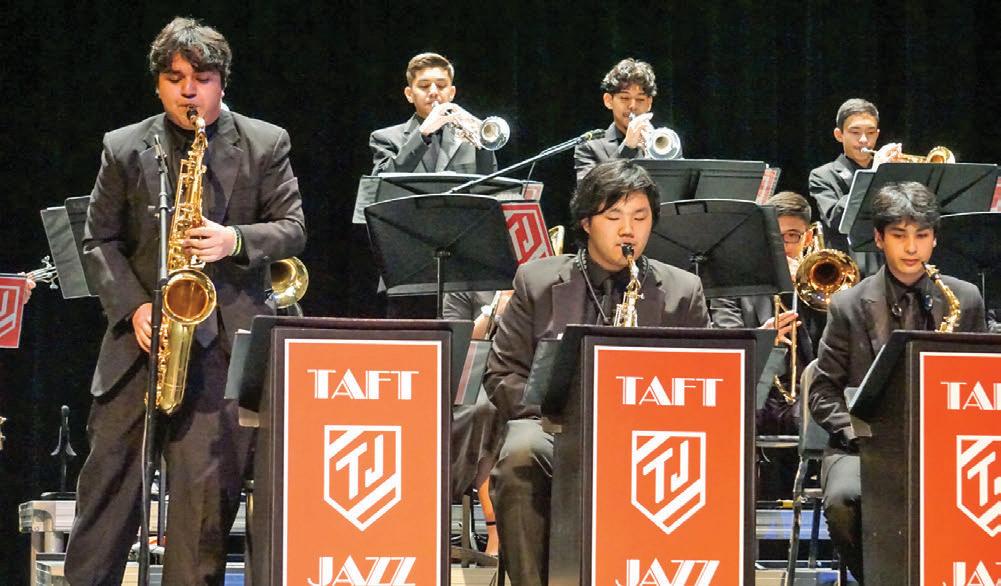
Vista Ridge HS Percussion Ensemble
The Vista Ridge HS Band in Leander ISD has approximately 270 members, 41 of whom are percussionists. The Percussion Ensemble has been under the direction of Hector Gil since 2008, and they have achieved national honors that include the 2017 and 2022 Black Swamp Percussion BSP Ensemble Showcase, 2018 Percussive Arts Society IPEC, and the 2018 Mark
of Excellence–Foundation of Music
Education National Percussion Honors Award. The Ranger Band was the 2018 UIL 6A State Marching Band Champion and a 2021 BOA Grand National finalist. Vista Ridge received the John Phillip Sousa Foundation Sudler Shield in 2017 and the Sudler Flag in 2021. In January, the Ranger Band represented Texas at the 134th Tournament of Roses Parade in Pasadena, California.
TMEA Clinic/Convention Update
Even if you haven’t registered yet, I encourage you to do so at www.tmea.org/ register before you arrive at the convention center. This will help you have a smoother badge pickup process (you’ll go straight to the kiosks where you can print your badge rather than through onsite registration).
In addition to the amazing pedagogical and inspirational opportunities at our convention, there are three meetings that I strongly encourage you to attend:
TMEA General Session: On Thursday at 8:15 a.m., start your convention off right by attending our General Session in Lila Cockrell Theatre. As part of this gathering of the membership, we’ll enjoy an incredible performance by hundreds of All-State musicians in the combined ensemble of our Mixed Choir, Symphonic Band, and Symphony Orchestra. This General Session includes the closing of our President-Elect elections as well as other important association-wide updates.
Band Division Business Meeting: On Thursday, February 9, at 5:15–6 p.m., go to Hemisfair Ballroom 3 (south side of the center on the third floor) for the annual meeting of our division. The meeting is
21 Southwestern Musician February 2023
Taft HS Jazz Ensemble

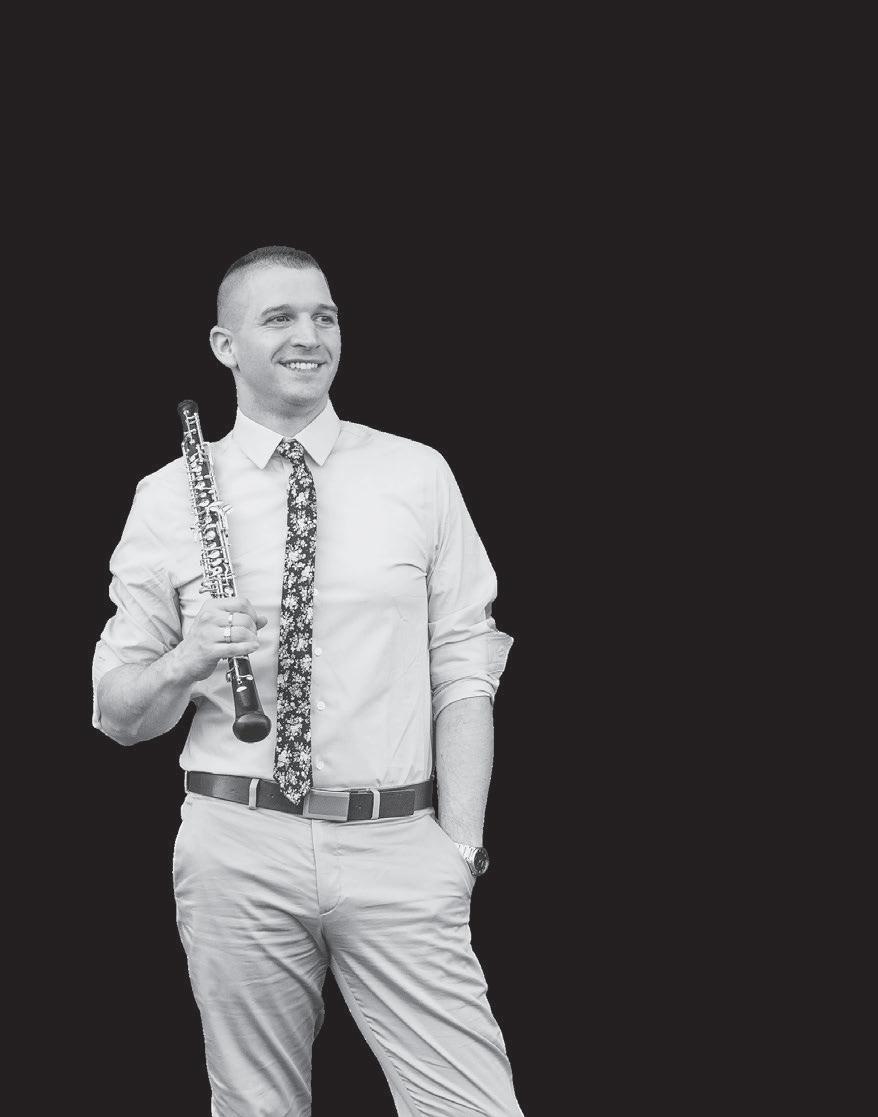
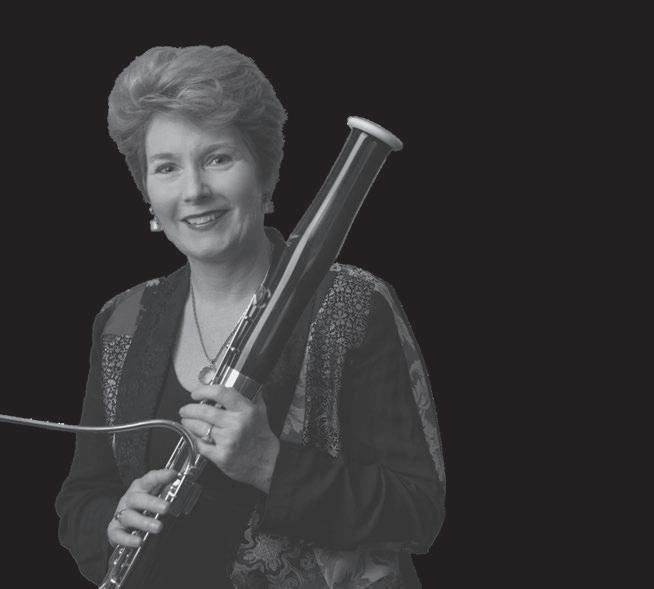

crucial to the continued success of our Band Division, so please make sure to save it to your schedule and attend. Wayne Oquin, Chair of Musicianship at The Juilliard School and our featured clinician, will give a brief keynote address and Brad Kent, UIL Director of Music, will provide
an update on current UIL issues. Region Meeting: On Friday, also at 5:15 p.m., be sure to attend your Region meeting. Check the convention program and the app for the location of your meeting, and add this event to your schedule. We have so few opportunities to meet as a
Region, and since you’ll already be there, this is a perfect opportunity to get updated on TMEA business and be an active part in your Region’s future.
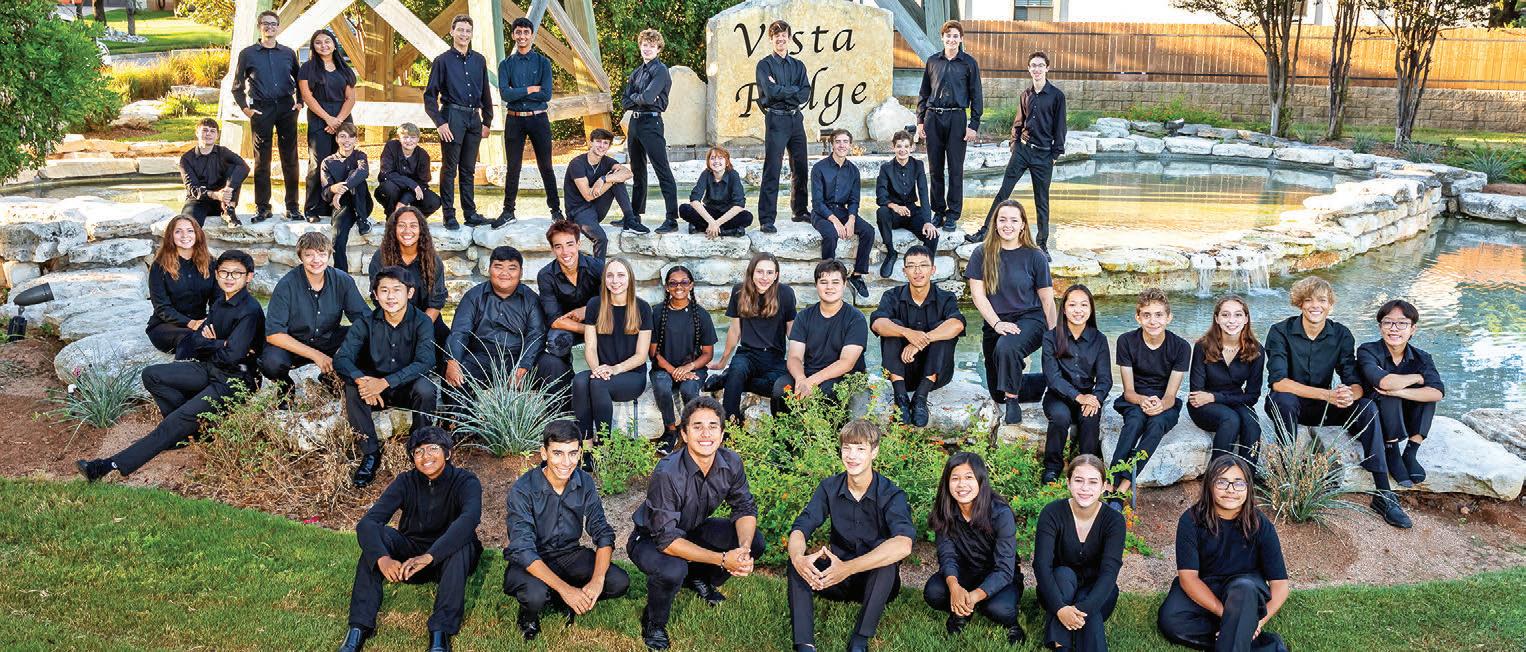

I look forward to seeing you in San Antonio! 0
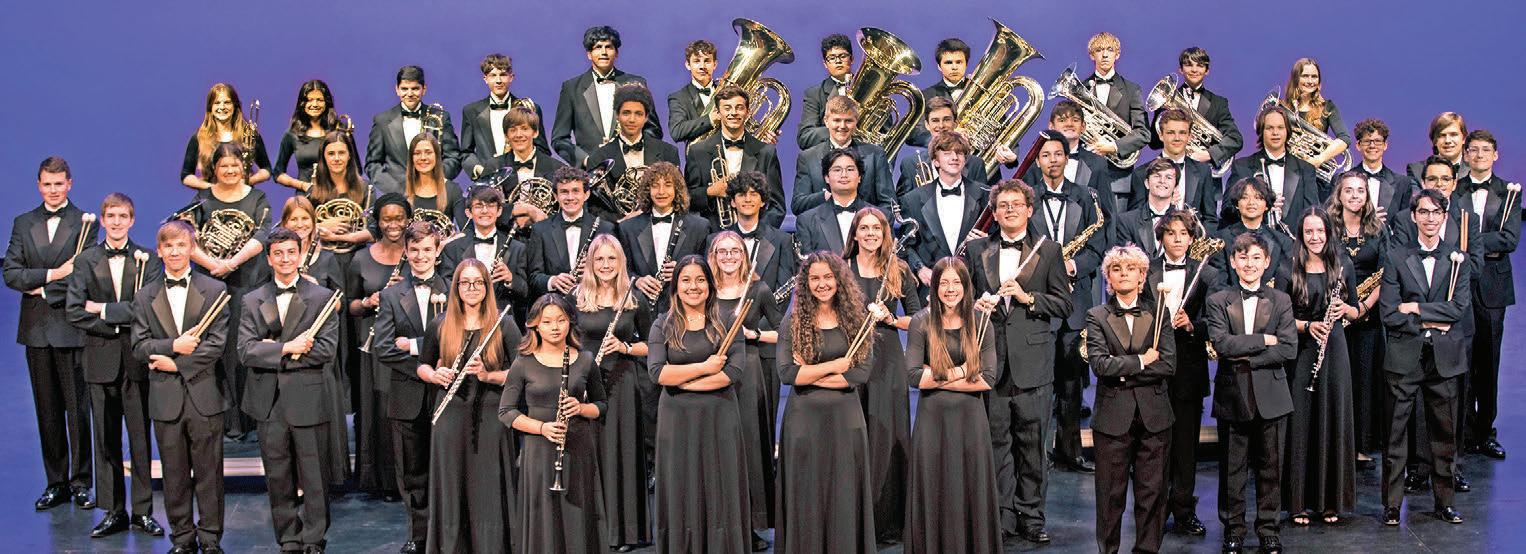 Argyle HS Wind Ensemble
Hornedo MS Jazz Ensemble
Argyle HS Wind Ensemble
Hornedo MS Jazz Ensemble
23 Southwestern Musician February 2023
Vista Ridge HS Percussion Ensemble
Practical Approaches that Lead to Artistic Ensembles
By Eric Allen
When I was a high school band director, I constantly searched for ways to make my ensembles sound better. I learned to diagnose problems and prescribe solutions that led ensembles toward perceived success. Contest ratings and performance invitations affirmed my confidence, and for a while I felt like I had it figured out. Then one day one of my mentors told me, “Your band sounds good, but you aren’t making music.” This baffled me. How could we sound good but not be making music? After I recovered from my injured ego, I decided I was ready to better understand what he was saying.
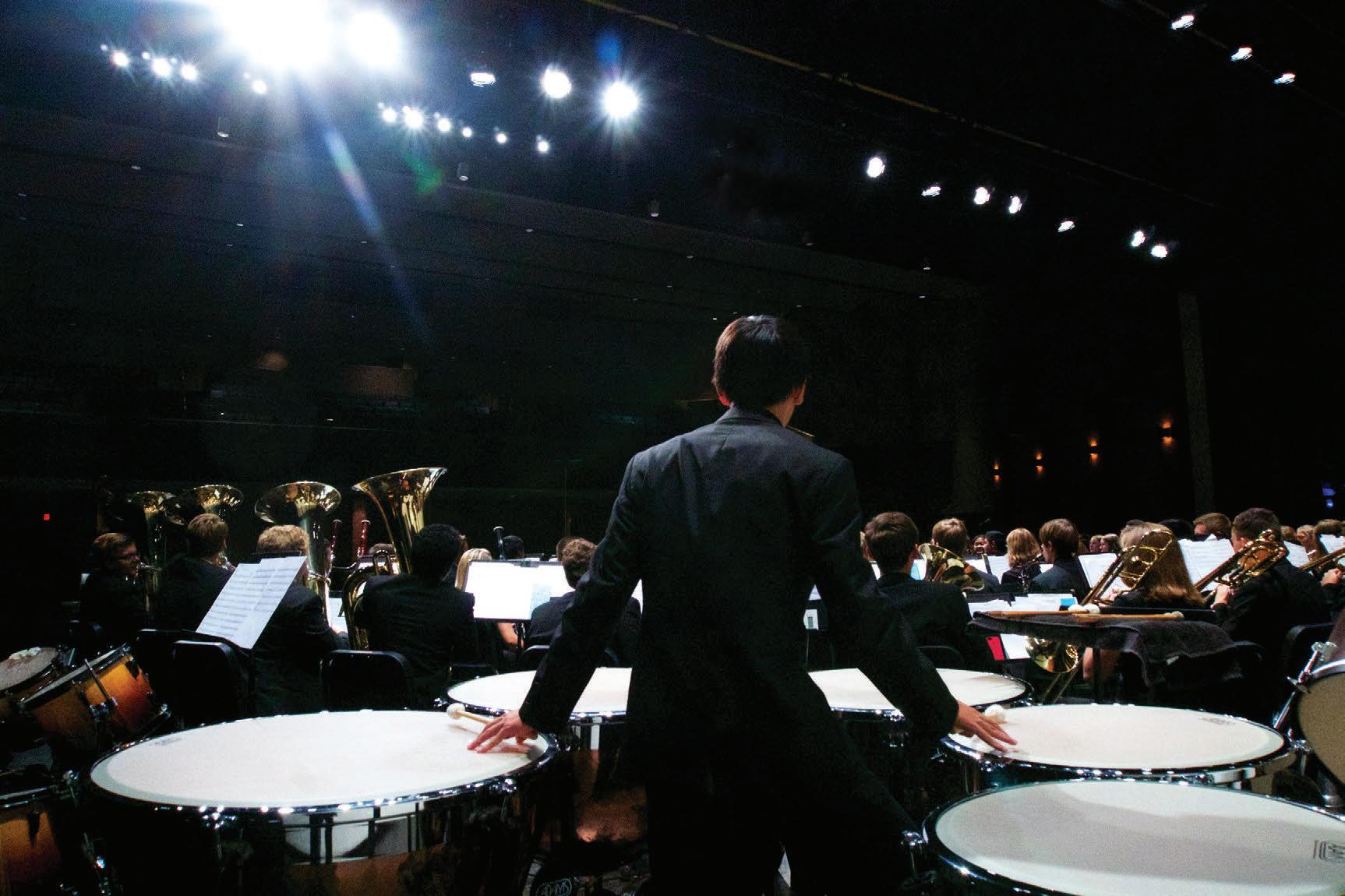
This mentor is Joe Kreines, a legendary clinician in Florida. I invited him to work with my ensembles, and they completely changed in his first rehearsal with them. I sat in amazement as they responded to him and each other in a deeper and more musical way. He used no metronome or amplified tuner, and sometimes no score, yet the ensemble naturally rose to his musical expectation. Music oozed out of him, from his analogies and prompts to his gestures. Even the most disconnected students were engaged. I was a believer, but I left wondering how I could teach them in a way that would inspire this type of artistry and still accomplish the technical objectives I felt pressured to achieve.
Many of us have had this experience: we observe others lead in a way that inspires ensemble musicians to reach further, then ponder how to achieve this magic in our own rehearsals. I have spent over 20 years pursuing such an approach and through that exploration have discovered a few ideas that have helped me move the needle in the right direction. While concepts of music do not
function in isolation, I will share specific suggestions for addressing precision, sound, and musical interpretation
Precision
Ensemble precision issues occur when musicians interpret pulse differently or when rhythmic interpretation is inconsistent. Effective ensemble pulse and tempi are products of listening, interacting, and a little flexibility. When pulse and tempi are of concern, it may be tempting to utilize an amplified metronome as a corrective measure. While a metronome is a great tool for developing consistent pulse during individual practice, overuse for this purpose in rehearsals can be counterproductive to communication. Instead, consider inviting the ensemble to maintain pulse by collectively sizzling a subdivision, allowing them time to adjust to each other. Once the ensemble is sizzling precisely together, assign pulse leaders within the ensemble. These leaders can be identified as those having the most rhythmically active parts in the music. Prompting everyone to listen and react to the pulse leader draws the ensemble toward constant interaction, even more so when the leaders change within the scoring. Prompting them to constantly react to different pulse leaders can also promote more accurate rhythm.
When rhythm is inconsistent, resist the urge to explain it verbally. Just like the old saying “A picture is worth a thousand words,” an aural example is too! Instead of explaining, use the score to determine which players should serve as the rhythmic leaders, and then prompt everyone to listen to and match them.
Technique, wonderful sound . . . all of this is sometimes astonishing, but it is not enough.1 —Pablo Casals
24 Southwestern Musician February 2023
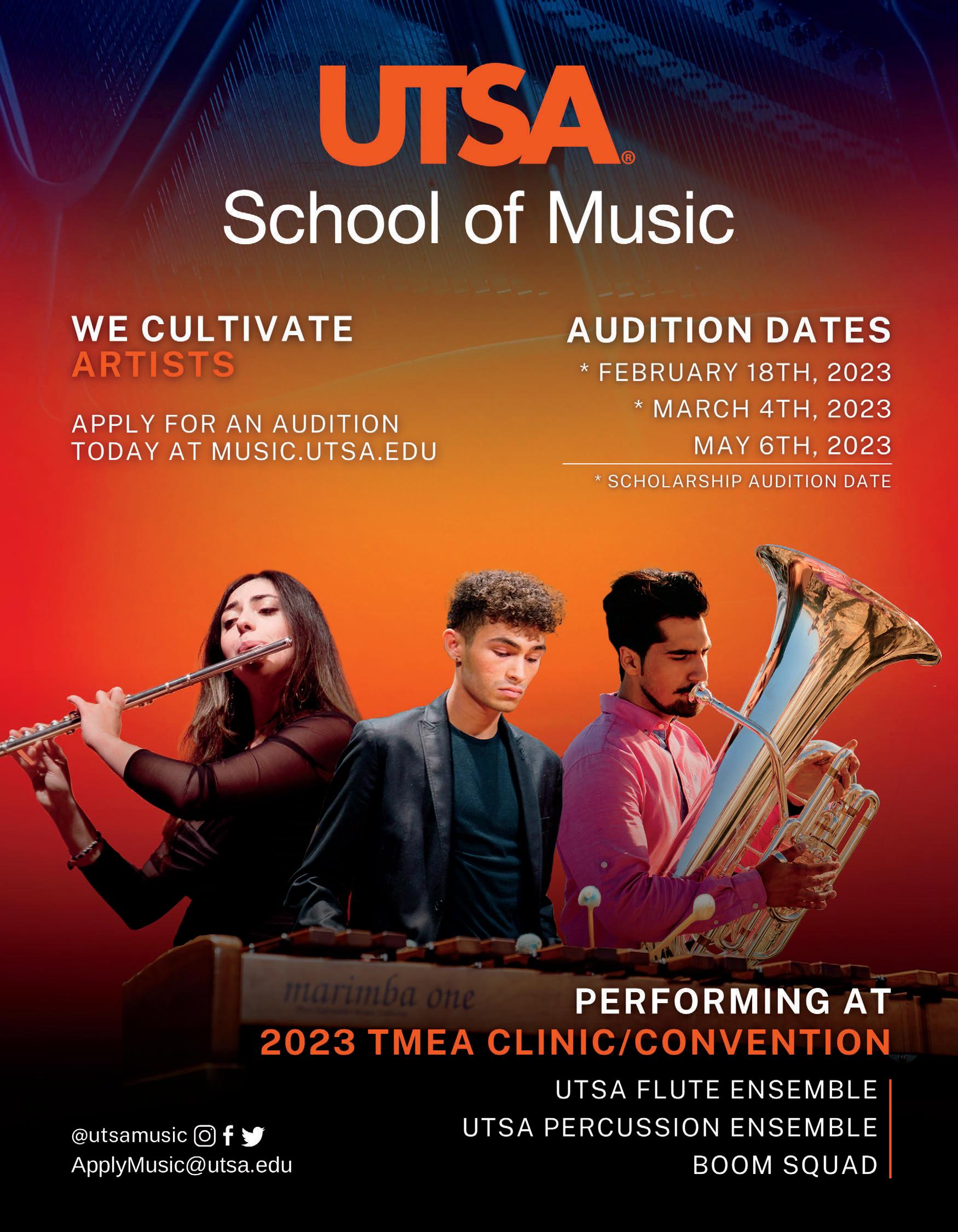
You will likely notice that imitation such as this also repairs timing, articulation, and so much more!
Sound Sound is the vehicle for expressing our art form—frankly, no one wants to listen to an ensemble that does not sound good. Perhaps the first consideration regarding ensemble sound should be balance. Creating appropriate ensemble balance to best deliver the music requires study and designation of hierarchy. Modern composers typically indicate very clearly what they want dynamically, and while we should adhere to the relative dynamics as indicated, the art is in determining which sonority should be prominent and then prompting others to listen to and protect those voices. Designating priority of importance based on scoring can lead to natural development of beautiful balance.
Intonation is perhaps the most frequently addressed issue in rehearsals related to sound. To improve ensemble intonation, we must first acknowledge that it is a part of a bigger picture. While A440 is a great starting point, artistic ensembles make subtle pitch adjustments all the
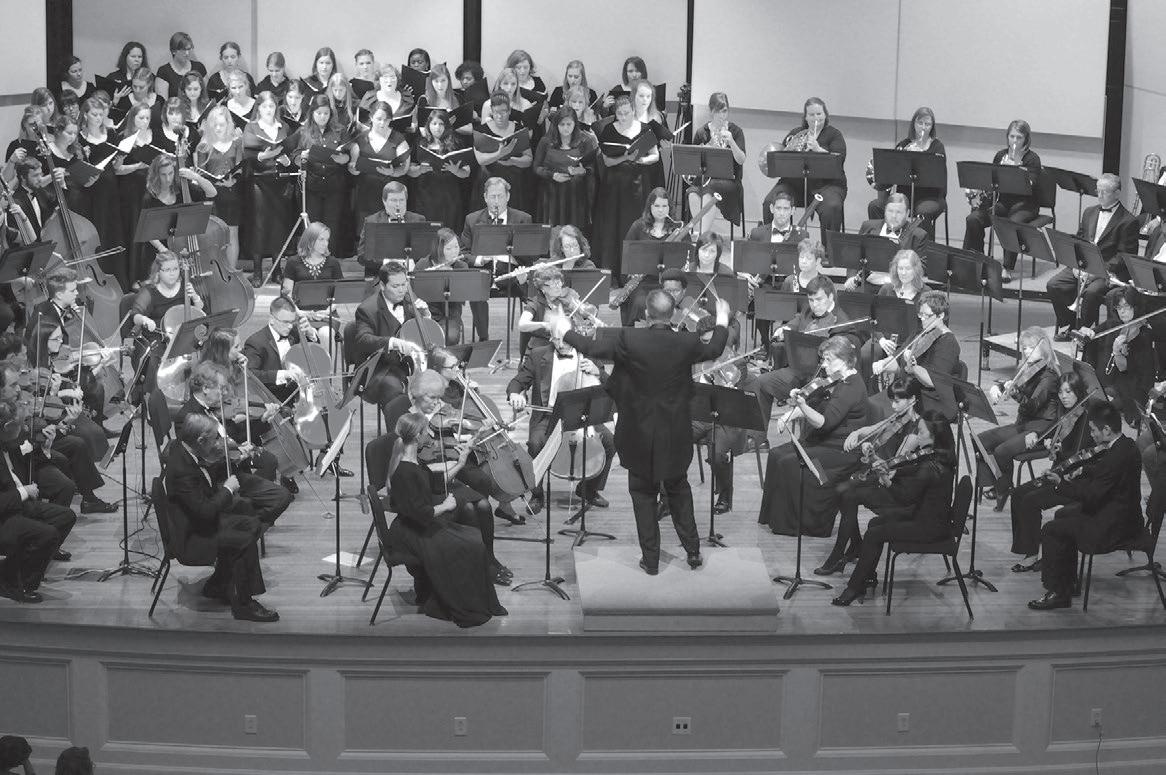
time—together! While it is valuable to utilize a reference pitch at the beginning of rehearsal, ensemble tuning is not an isolated event. It is the responsibility of every ensemble member to constantly match ensemble pitch and timbre. Modern technology has made electronic tuners easily accessible to everyone. Much like how metronomes assist with pulse, tuners can be useful in training our ears. However, overutilizing these tools in ensemble rehearsals can hinder the development of listening skills and prove counter to the artistic process. Remember that the objective is for our ensembles to detect and correct intonation, or any other inconsistencies on their own.
To repair intonation issues and develop proactive listening and adapting, it’s very beneficial to isolate individual pitches and allow time for the players to adjust on their own. If this proves challenging, consider isolating a musical phrase, perhaps slower than indicated. It is often easier to identify inconsistencies in moving lines and it promotes real-time adapting. Slower tempo allows time for the musicians’ ears to assess and adjust. Much like when working on rhythmic precision, identifying a pitch
leader creates a target for the ears to match. Rather than just asking them to match intonation, consider prompting them to match every part of the sound. When balance, blend, and timbre agree, it’s difficult to play out of tune! Younger players may initially require guidance in this process, but every effort should be made to guide them toward assessing and correcting on their own.
Musical Interpretation
Like the Pablo Casals quote featured at the beginning of this article conveys, we must go beyond precision and sound, and consider musical interpretation.2 But what makes an interpretation musical or artistic? Is it the tempo, dynamic impact, balance of sound, flow? Yes, it’s all of these, but they should all support the music as it lives, breathes, and moves in real time. To put it simply, music is doing one of two things nearly all the time. Like everything in life, it is either moving toward or away from a destination. The artistry comes in determining when and how and how much to move. Finding what feels natural is key. We have all heard performances that sound very good but feel contrived or
26 Southwestern Musician February 2023
Texas Lutheran University School of Music
Announces The Appointment of Dr. Brett A. Richardson as Director of Bands

Known for his versatility and energy as a music educator, Dr. Brett A. Richardson will begin his appointment as Director of Bands at Texas Lutheran University in the 2023-2024 school year.
BACHELOR OF MUSIC IN ALL-LEVEL MUSIC EDUCATION
BACHELOR OF MUSIC IN PERFORMANCE
BACHELOR OF ARTS IN MUSIC www.tlu.edu/music
stagnant. The tempo is correct, the hairpin dynamics are in the right place, and everything is accurate, but something about these performances leaves us unsatisfied. A lack of musical interpretation that moves in a natural and organic way is often the issue.
How do we progress from precise technique and great sounds to making music that compels the musicians and the audience to engage and commit? The answer may be different for each person or each piece, and may not be immediately evident, and that’s okay! It may require
persistent probing to allow the music to reveal itself.

To probe music is to explore it deeply to find the most meaningful interpretation. Bobby Adams discussed this concept in his book Music: from Skill to Art, where he said, “Working on technique is not fun, probing is!”3 Discovering music through probing in rehearsals could include altering dynamics or tempo, exploring variants in articulation, prolonging dissonance, or any number of ideas that allow the music to come alive.⁴ This process does not excuse ample score study prior to rehearsals, but
it does allow for flexibility and exploration in rehearsals that invites the players to be active participants in the interpretive process, not to simply recreate what is dictated to them.

For example, consider exploring interpretation for a warmup chorale. First, invite your ensemble to play it, focusing only on notes and rhythms. Then select at least two places you consider important destinations/arrival points. (These arrival points could be significant cadences or even transitional moments.) Invite the ensemble to approach these moments with dramatic crescendo and ritardando, even if it feels awkward. Then, approach the same destinations in different ways until you discover an interpretation that feels natural to you and the ensemble. Probing the music for meaningful phrasing and interpretation such as this is a fun way to engage the ensemble in the interpretive process. In addition, putting the focus on musical ideas tends to yield better sound and precision at the same time!
Designed for ease of control with a rich, broad sound that’s pleasing to the ear. One of the world’s finest and best-known mouthpieces and the number one choice of advancing students, college-level players, aspiring amateurs and professional saxophonists.

The pursuit of leading ensembles toward artistry does not stop here, but considering our approach to teaching fundamental concepts such as precision, sound, and musical interpretation will set us in the right direction. Providing prompts for active ensemble communication and allowing space for music to occur in an organic way places more responsibility on the players and prepares them to react to each other in real time, even when things do not go as planned.
The long-term effects of this approach can yield powerful experiences that ultimately compel musicians to better communicate with each other and their audience and inspire a sustained pursuit of musical meaning and interpretation. 0
References
1, 2. David Blum, Casals and the Art of Interpretation . London, England: University of California Press, 1980. 1.
3, 4. Bobby L. Adams, Music: From Skill to Art. Chicago, IL: GIA Publications, 2015. 51.
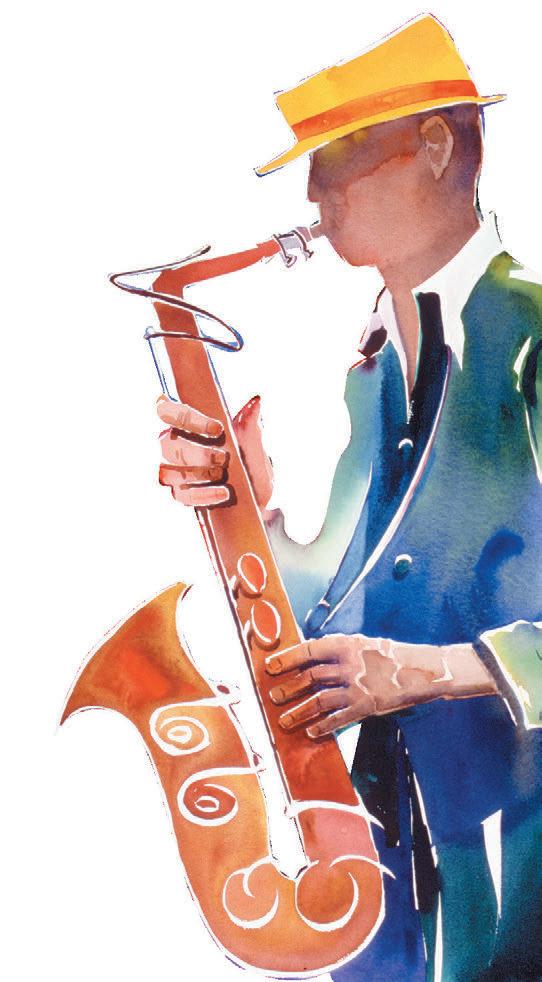
Easy & Fun to Play • Versatile • Rich Classic Sound • Flexible
Eric Allen serves as Associate Professor of Music and Associate Director of Bands at Texas Tech University.
28 Southwestern Musician February 2023
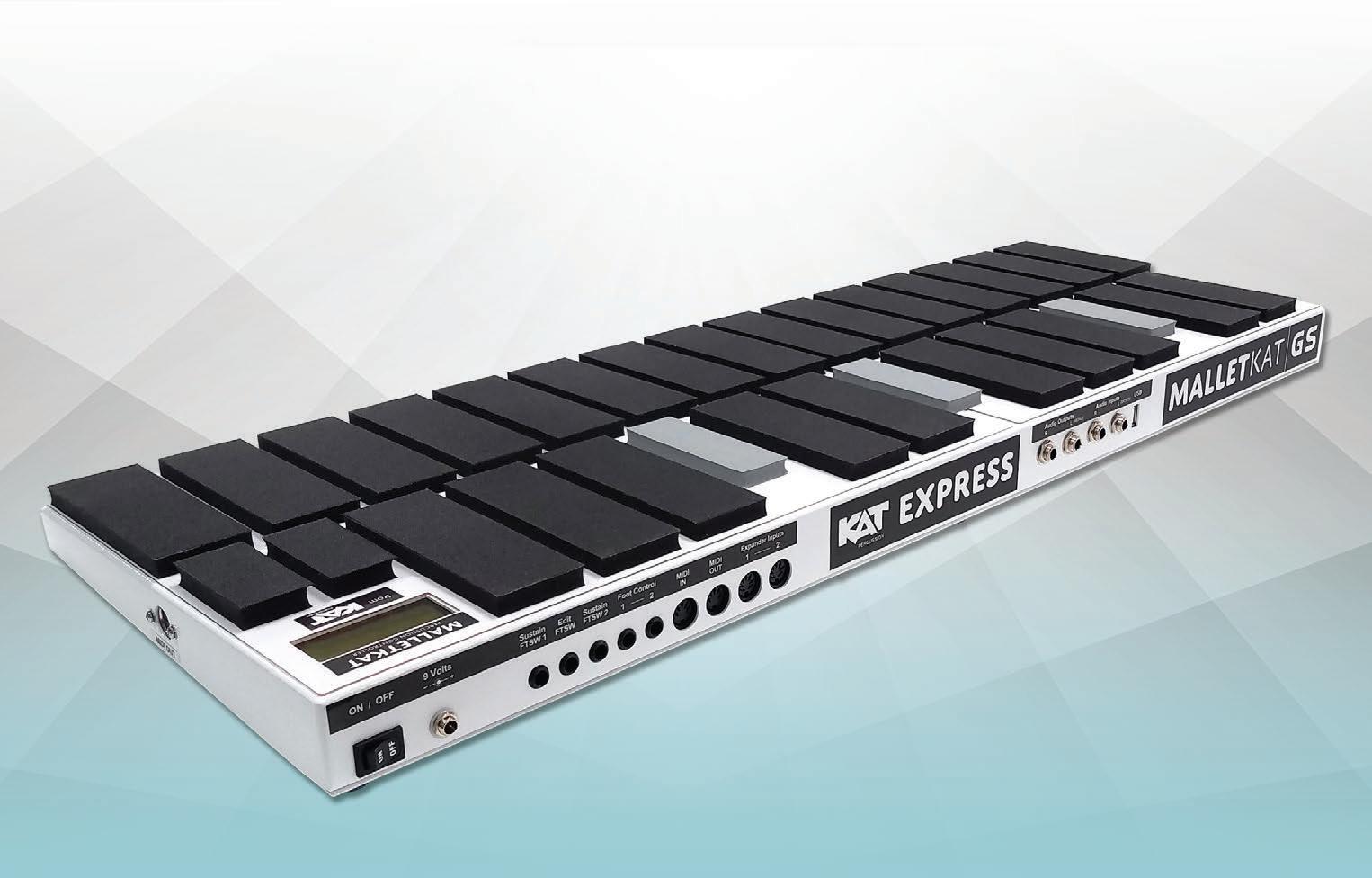
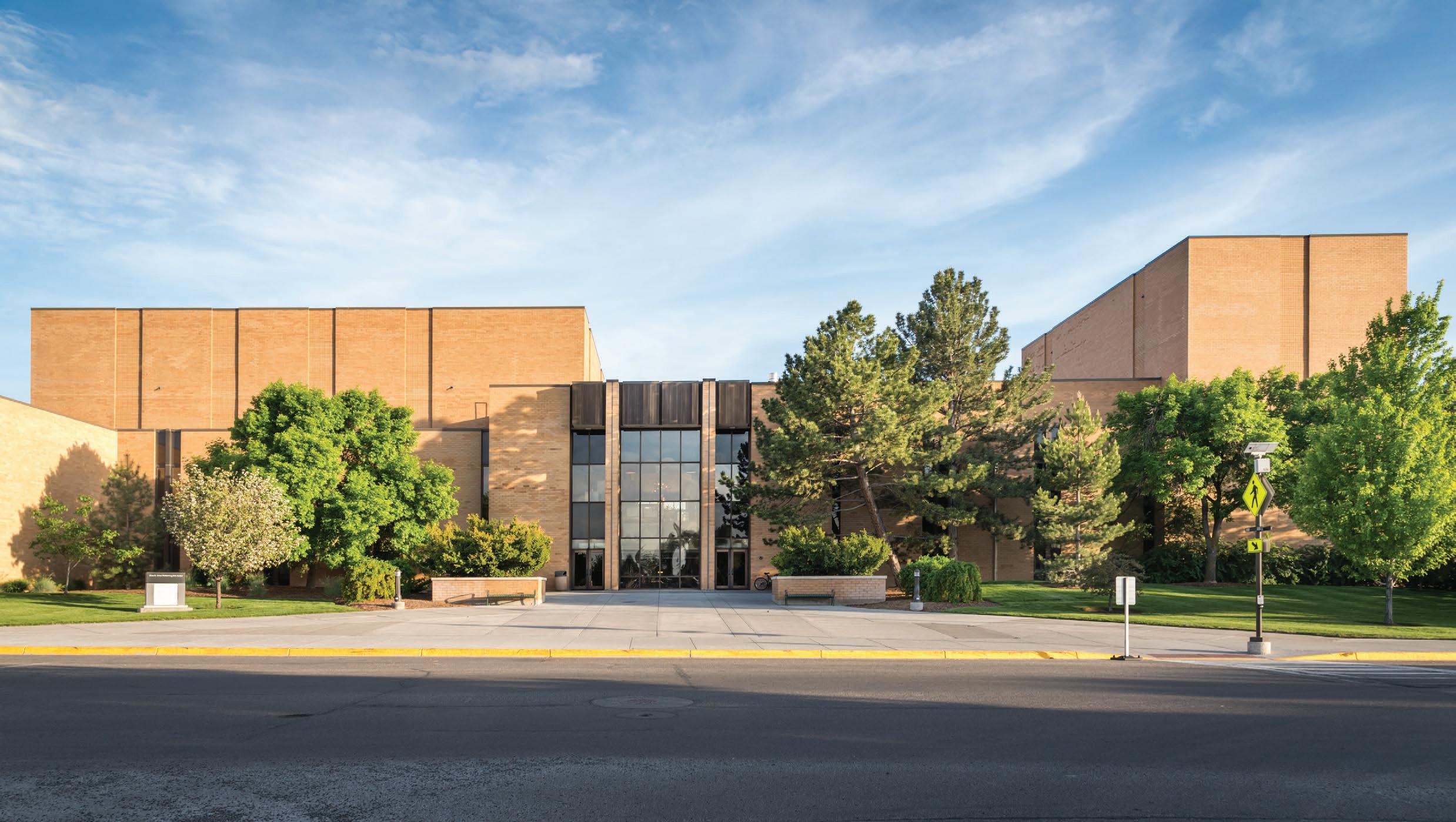

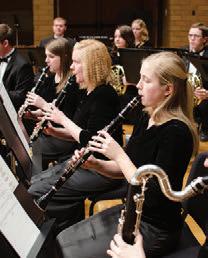
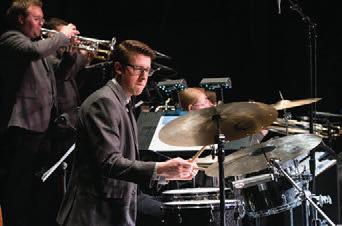
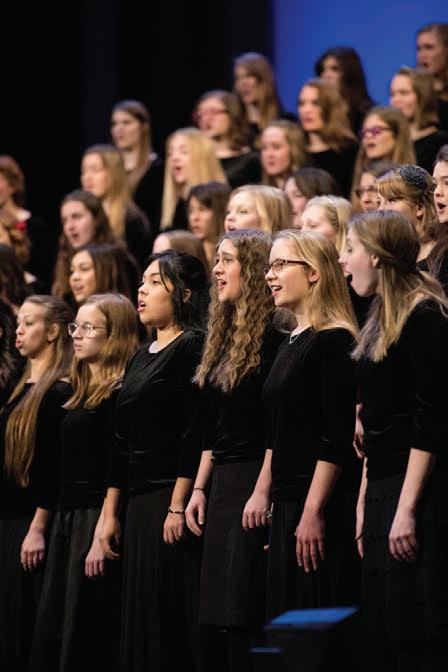


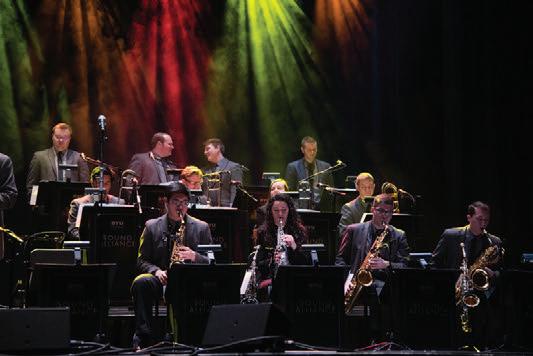



DEADLINE FOR ALL MATERIALS February 1, 2023 (208)496-4950 • music@byui.edu • http://www.byui.edu/music See website for in-person audition dates Scholarships Available OPPORTUNITIES Choir & Opera Band Orchestra Jazz Chamber Percussion Piano DEGREES BM Education BM Performance BMA BA Music PURSUE YOUR PASSION Department of Music Department of Music 29 Southwestern Musician February 2023
TMEA Orchestra Vice-President
ANN G. SMITH
Healing and Resilience
Just as the potter repairs the broken bowl or the luthier repairs the broken instrument, we need to examine our connection with our students and repair or strengthen any connection that is weak.
The violin I played while I was working on my undergraduate degree was special to me. It wasn’t a high-quality instrument, yet it held an important place in my heart. It was an instrument found in the depths of an antique store, and the quality is what you would expect to find with an instrument from such a place. Newly married and with little funds we purchased it, and I was proud. My undergraduate violin teacher tried in every way he could to get me to buy a new, higher-quality instrument. If I could have afforded it, this violin would have been cast aside and forgotten.
This instrument, despite its issues, meant the world to me. A little over 15 years ago my son was using the violin. He was your typical awkward freshman boy in this clumsy phase of his life. One day, he broke my violin in a manner that appeared irreparable. Because of the sentimental value, I took it to a shop to see if it could be addressed. They didn’t offer me a promising outlook. Even if it could be repaired, the quality would be further diminished. Despite that I was committed to trying. Then life moved on. I forgot about this violin—it was lost to life’s distractions. That was until about four months ago when I received a text message from the shop that they found a violin with my name on it in the back of their storage area. Fifteen years of dust graced this case with the broken violin still inside. Imagine my surprise when this long-lost instrument surfaced. Of course, I wanted it repaired. The sentimental value of my instrument was more important to me than the sound it
MARK YOUR CALENDAR
February—Renew your membership and register for the convention before arriving.
February 8–11 —TMEA Clinic/Convention in San Antonio.
February 9, 8:15 a.m.—TMEA General Session in Lila Cockrell Theatre.
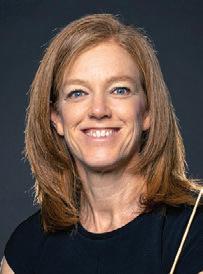
February 9, 5:15 p.m.—Orchestra Division business meeting at the convention.
February 10, 5:15 p.m.—TMEA Region meetings at the convention.
March 1 —Texas Music Scholar online application opens.
check www.tmea .org for updates 30 Southwestern Musician February 2023
Study
ADMISSION & SCHOLARSHIP AUDITIONS

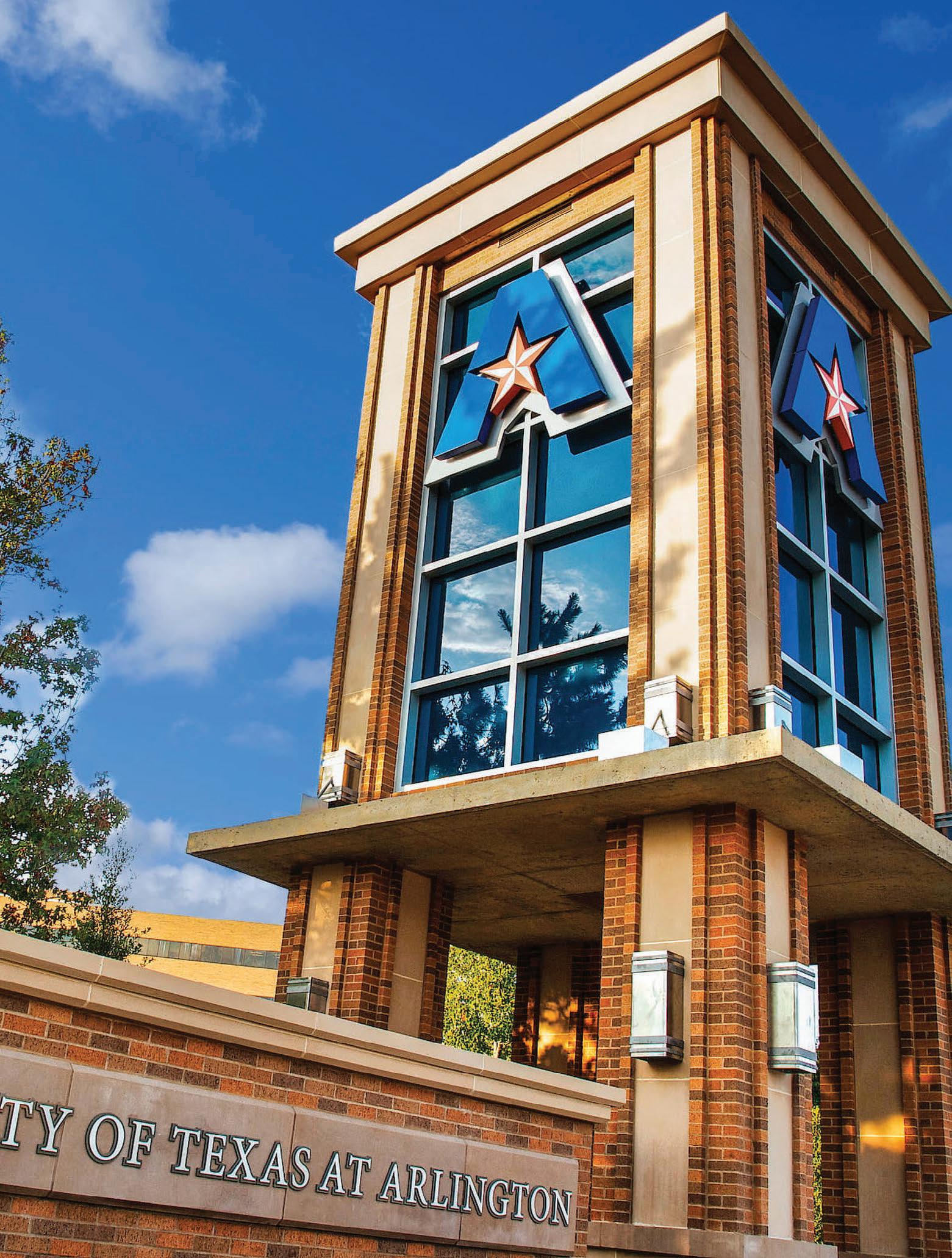
February 18 and March 4
February 18
Strings
March 4 and March 25
Voice
Woodwinds, Brass, Percussion, Piano, Jazz *Alternate
Music Education, Performance, Jazz, Theory, Composition
Music Business, Audio Production

and Perform in the heart of Dallas-Fort Worth
DEGREES OFFERED
For more information visit our website (uta.edu/music)
dates by appointment
UT Arlington Music
could produce. The value is in its journey to this point.
age, the gold enhances them. This is an art form of healing and resilience.
As I thought about my violin and the effort put into repairing it, I began to think about Kintsugi—the Japanese art form of putting broken pottery back together. There is a legend behind this art form dating back to the fifteenth century when Shogun Ashikaga Yoshimasa was dissatisfied with a repair to his favorite teacup. After experiencing this disappointment, he instructed a craftsman to develop a way to repair it, and thus evolved the art of Kintsugi. The cracks are filled with gold.
This repair process includes many steps and takes a long time to complete— sometimes several months. This art of repair takes a broken object and fills its scars with gold powder. Instead of hiding imperfections brought about by some dam-
So what do my violin and the art of Kintsugi have to do with music education? I believe they have a lot to do with us as teachers and our relationships with our students. First, it’s important to know that what seems to be lost doesn’t have to be gone forever. In my 28 years of experience, I have sometimes labeled students as lost to my program and often think about what I could have done differently to keep them in the program.
We have all taught students who cause serious disruptions to rehearsals. Some have failed to engage in rehearsal. There are students who have dropped our class for a wide variety of reasons. How have we approached these students? Have we tried to find a way to make a connection with them? Do we try to determine the reason for the disruptions or the lack of engagement? When we see them, do we take time to see how they are doing?
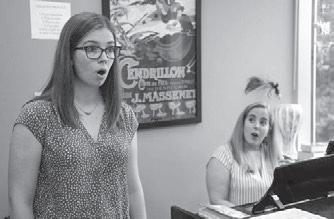
I can remember several experiences when I have focused on the student and their needs, and they returned to orchestra. Last school year I taught a student who caused significant disruptions during
rehearsal, didn’t add to the group musically, and often skipped class. I was concerned about what contribution he would make this year. As the year started, he expressed interest in learning to play viola and I took advantage of his interest. I gave him a viola, briefly showed him how to read alto clef, and gave him music. Turns out he loves to play the viola and is now contributing to the group more than before. Our student–teacher relationship has moved in a promising direction, and he will graduate with a positive experience in orchestra.
The final product is worth the effort. As with the Japanese art of Kintsugi and the effort that went into restoring my violin, it is all worth it. The restoration of a piece of pottery or the restoration of the violin brings the cherished item back to its
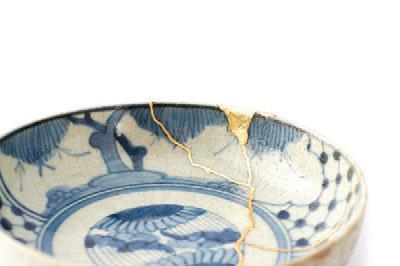

think. perform. explore.
Music scholarships available to non-music majors
■ Faculty who focus on undergraduates
■ 16 ensembles, with national and international ensemble touring opportunities
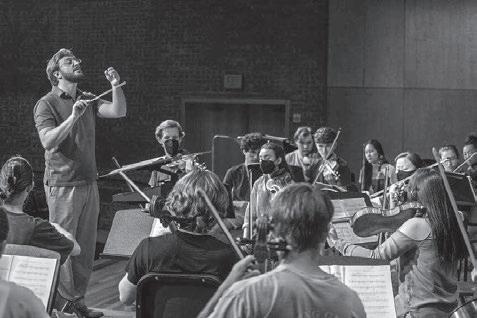
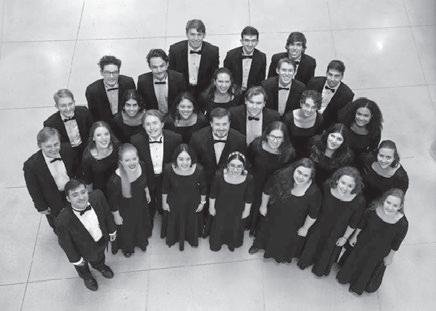
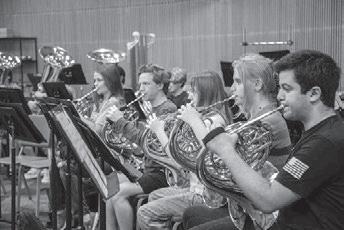
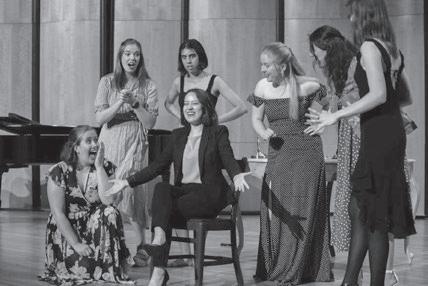
■ Degrees in music education, performance, and composition
■ Master of Arts in Teaching, a 5th year program with a full year of student teaching and 100% job placement (25 consecutive years)
■ Located in culturally vibrant San Antonio
■ Study Abroad opportunities
trinity.edu/music
The Trinity University Music Department is recognized as an ALL-STEINWAY SCHOOL by Steinway and Sons, for its commitment to excellence
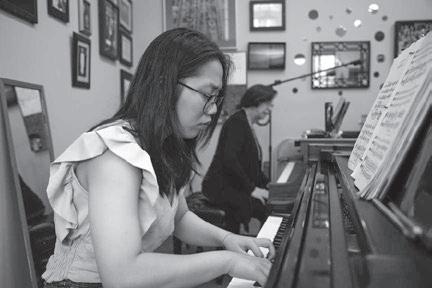
32 Southwestern Musician February 2023
Kintsugi is an art form of healing and resilience.
Celebrating 52 Years!
APRIL 27, 28, & 29 | AMARILLO, TX
One of the largest and most recognized music festivals in the Southwest!
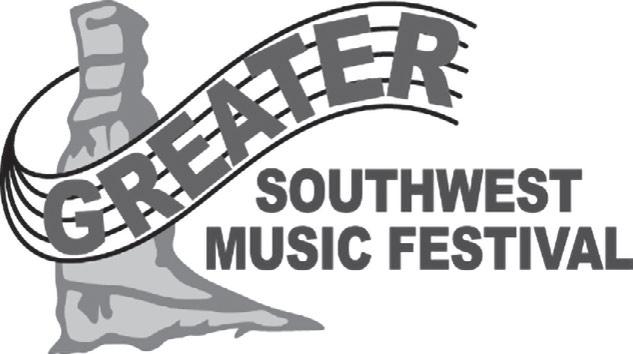
Over 7,000 students - elementary through high school programs.
Receive expert critique and adjudication from top music directors.
Trophies and recognition at every level.
Enjoy Wonderland Theme Park, Palo Duro Canyon, Cadillac Ranch, and more!

Festival Categories
Concert Bands
Concert Choirs
Concert Orchestras
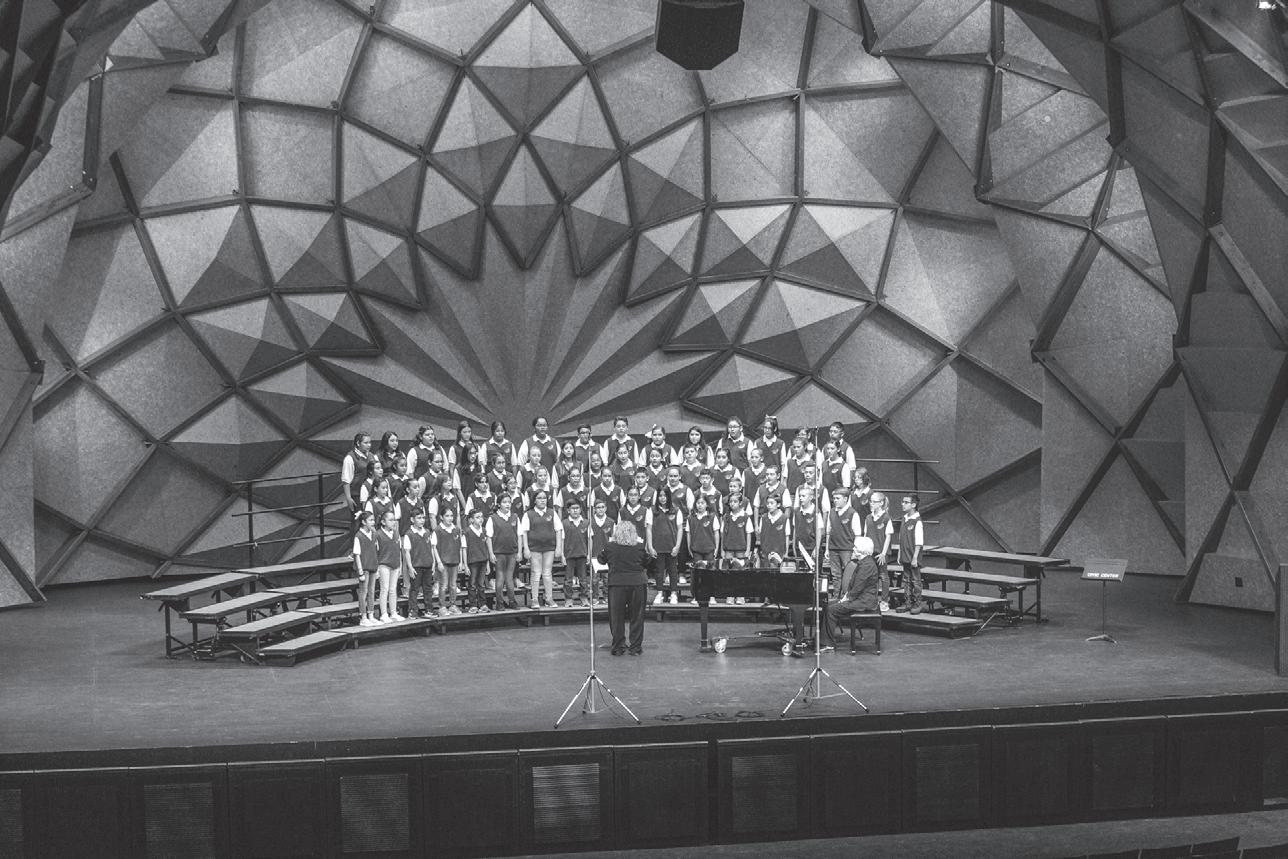
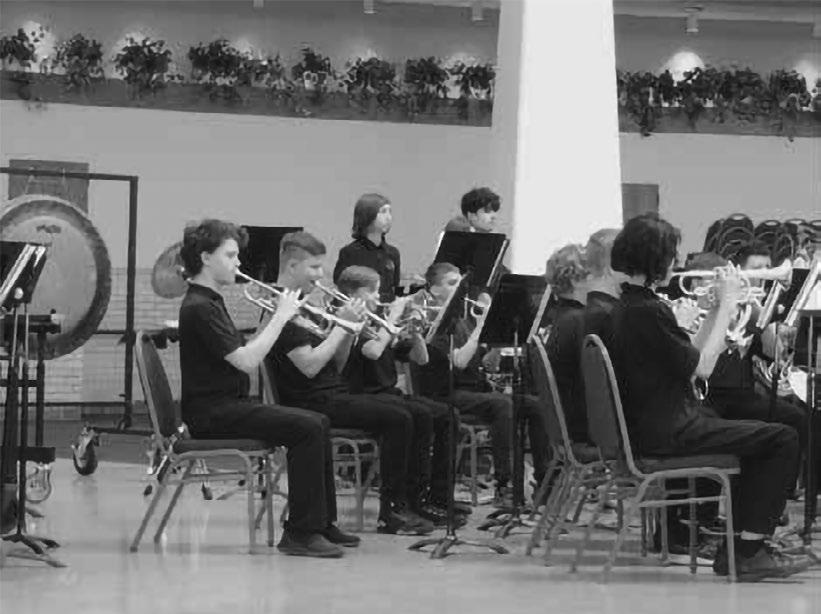
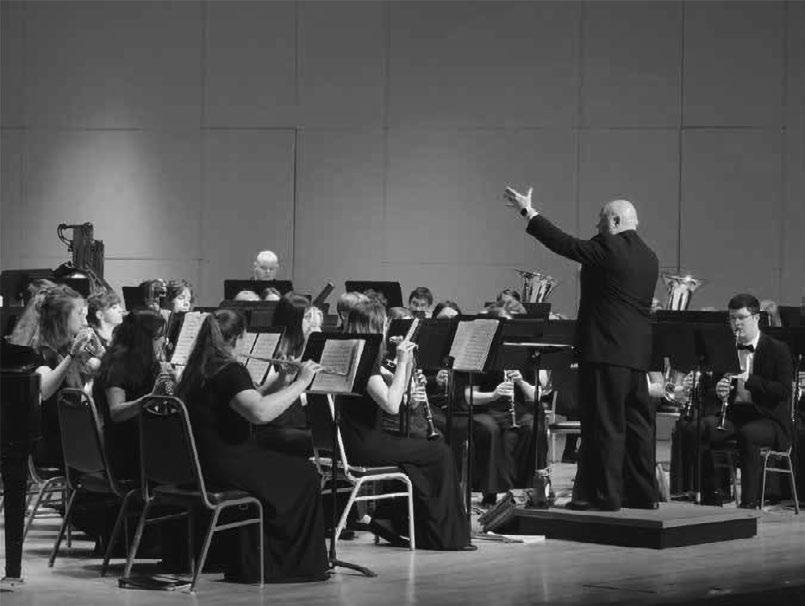
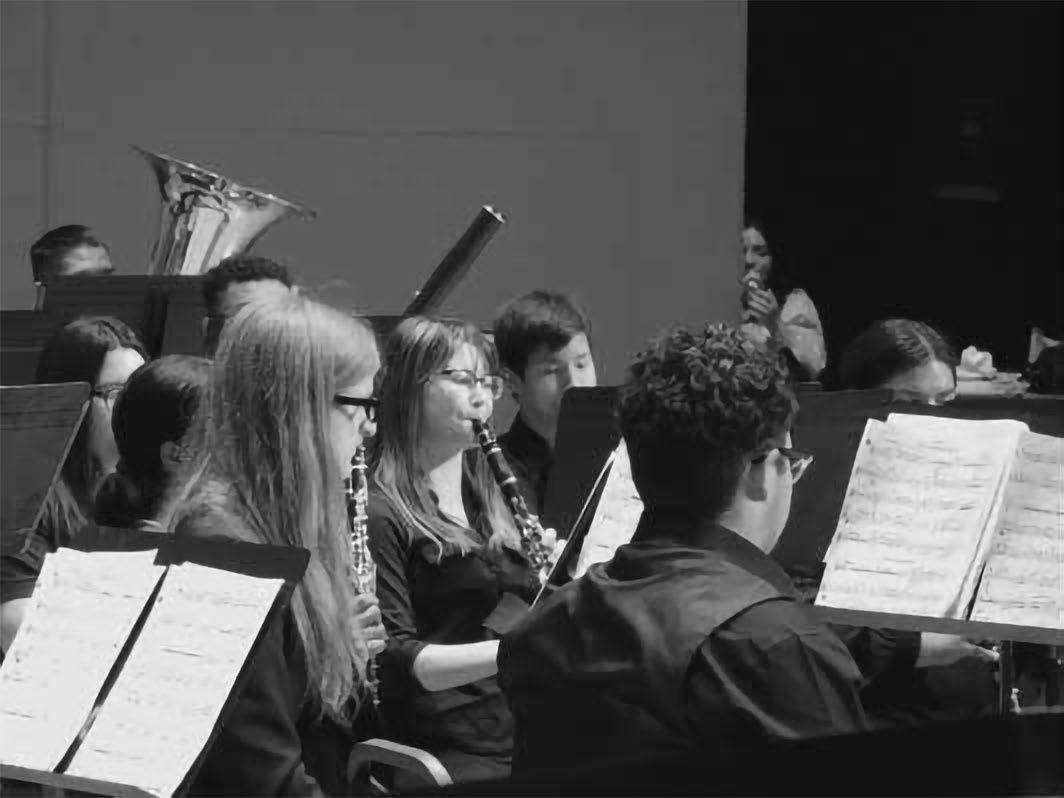
Jazz Bands
Show Choirs
Solo & Ensemble
Hosted by:
REGISTER TODAY!
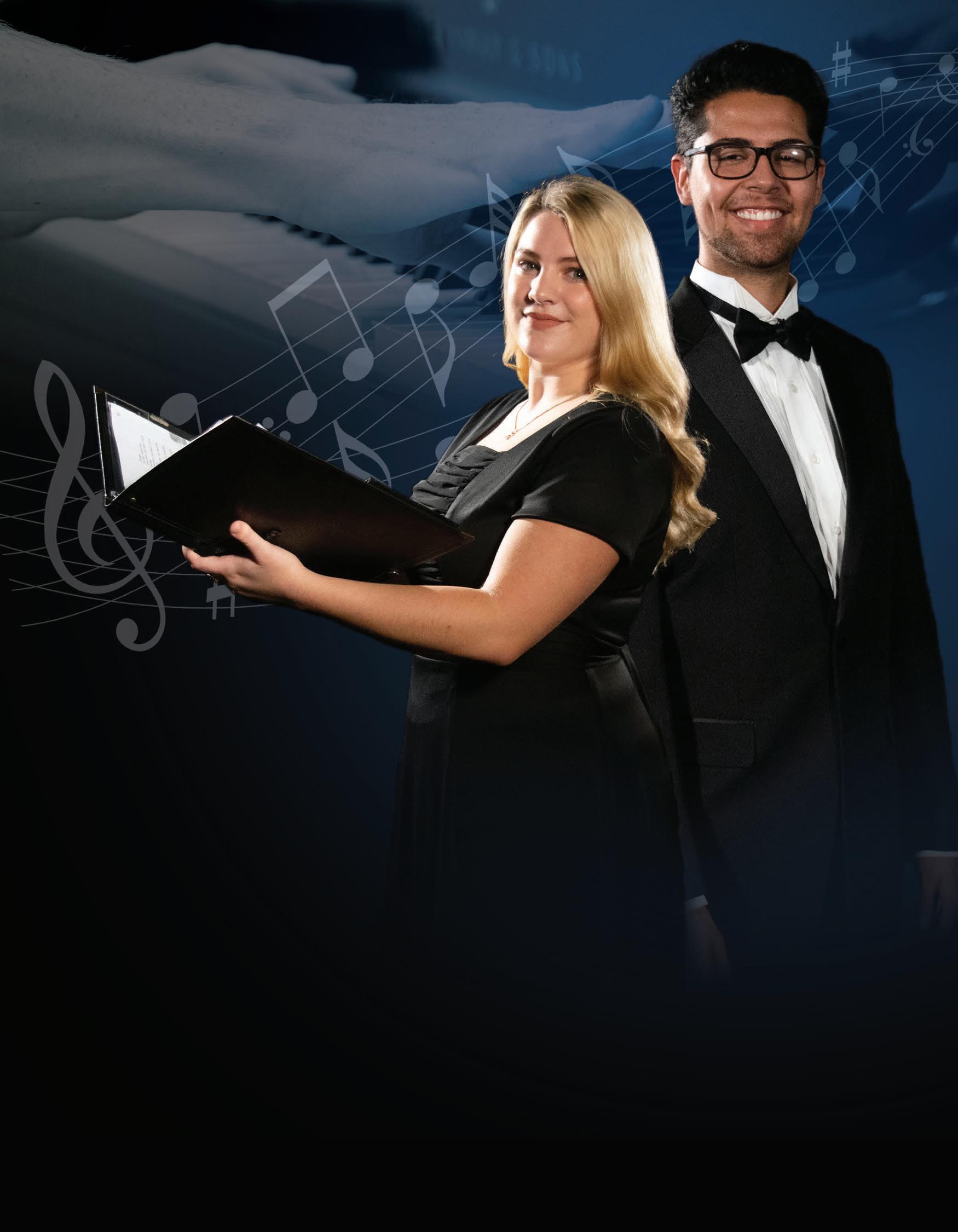
wbu.edu 1.800.588.1928 Creative School of Arts Choral Education • Worship Studies • Vocal Studies Music Production • Piano Pedagogy General Music • Theory and Composition • American Music Studies Fields oF study three-year Bachelor oF applied science degree Sound Production • Piano Studies • Worship Studies one-year certiFicate in piano pedagogy new online programs
usefulness. This is reflected in an experience I had this year with a student who went to a different school last year and returned to our campus. He stopped by my office every day asking about a schedule change back into orchestra. I didn’t need another cellist in the top group. Despite adding to unbalanced instrumentation, I contacted the counselor every day until his schedule was changed. Little did my associate and I know that this young man’s level of commitment exceeded the everyday orchestra class. He practiced daily and went on to earn a position in an AllState Orchestra. This extra effort to get his schedule changed ultimately resulted in a once-in-a-lifetime experience for this young man and moved him in a direction to pursue music beyond high school.
In today’s world, the student–teacher relationship is critical to our helping students develop into strong and confident young adults. As a teacher who will work with a student for two to four years, this relationship is even more important. The impact of a broken or negative relationship will also have an impact on a person for many years. Just as the potter repairs the broken bowl or the luthier repairs the bro-
ken instrument, we need to examine our connection with our students and repair or strengthen any connection that is weak.
As I’ve offered in a previous column, it breaks my heart and forces me to reexamine my actions when I learn that a former student thought I didn’t like them. It has become my goal that every student understands the love and care I have for them. Making this stronger connection will make an impact far beyond the orchestra rehearsal. Not only will the relationship be stronger, but you and the student will emerge better people. Those connections will be felt by the rest of the program, and your program will become stronger because of it. When students understand the love and care we have for them, there is no better recruiting and retention tool.
I hope that as we move forward, we can keep in mind the principles of Kintsugi. Let’s remember these three things: something that is lost is not gone, the final product is worth the effort, and most importantly, repairing something that is broken will make it stronger and more resilient.
TMEA Clinic/Convention Update
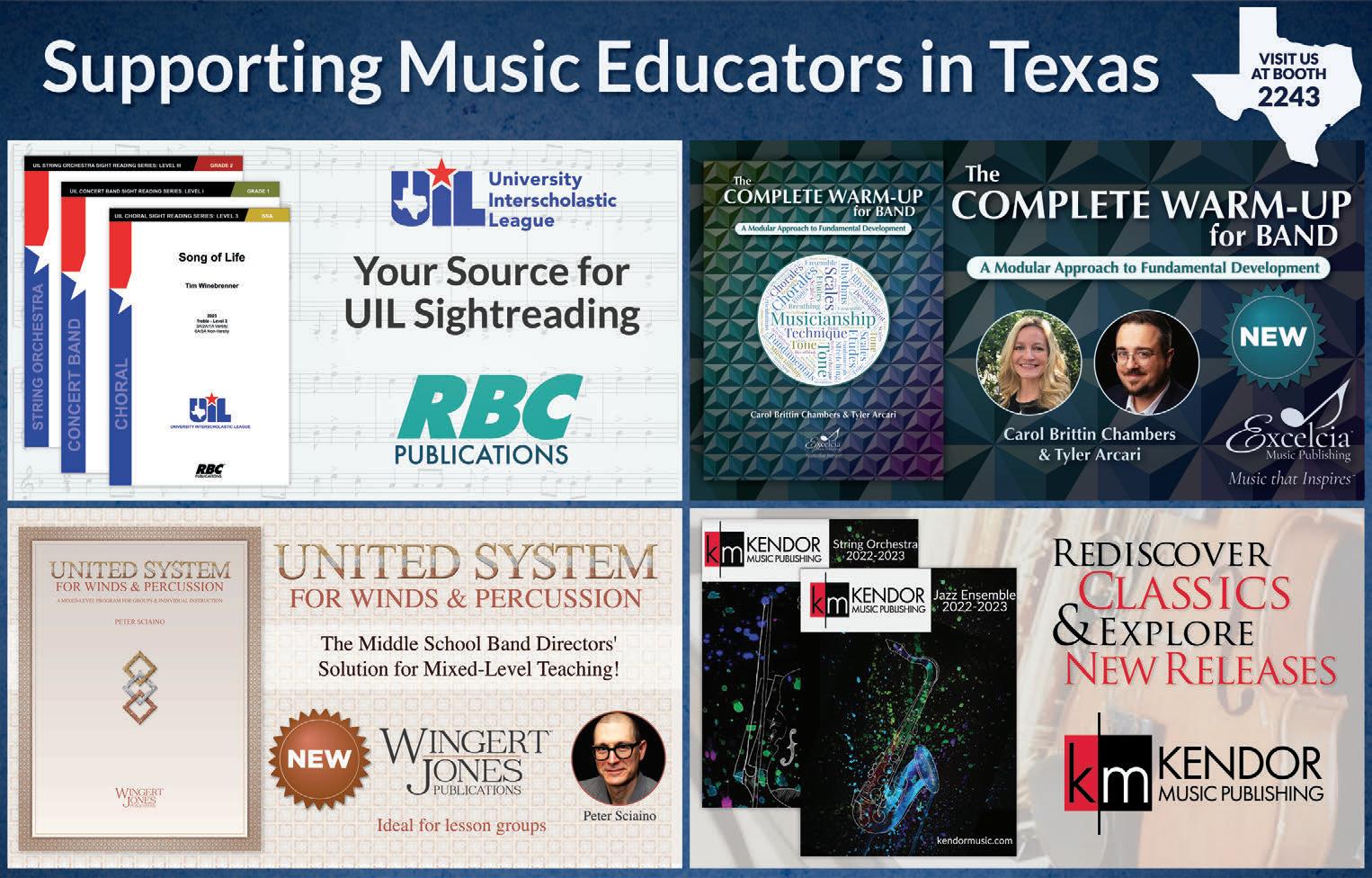
While our early registration deadline
has passed, it’s not too late to register at www.tmea.org/register (making badge pickup easier). This year’s event will feature amazing clinics and the return of the Honor Orchestra performances. So much preparation has gone into these performances, so don’t miss out on them or the excitement and energy they will bring to your convention experience.
There are a wide variety of workshops and clinics scheduled for the convention. Featured Clinician Robert Gillespie will present four very worthwhile and inspirational clinics. All-State ensemble rehearsals and performances are mustattend events as well. The conductors are amazing, and the programs are incredible. There will be myriad learning and growth opportunities for everyone, from the clinics and rehearsals to performances and more.
Be sure to attend the Orchestra Division business meeting on Thursday at 5:15 p.m., as we take the opportunity to vote for the next TMEA Orchestra Division VicePresident and receive updates for programs and policies. Then on Friday at 5:15 p.m., go to your Region meeting. I look forward to seeing you very soon in San Antonio! 0
35 Southwestern Musician February 2023
BAYLOR UNIVERSITY SCHOOL OF MUSIC
APPLY
1. Complete the Baylor University application at baylor.edu/gobaylor
2. Complete the School of Music application at app.getacceptd.com/baylormusic
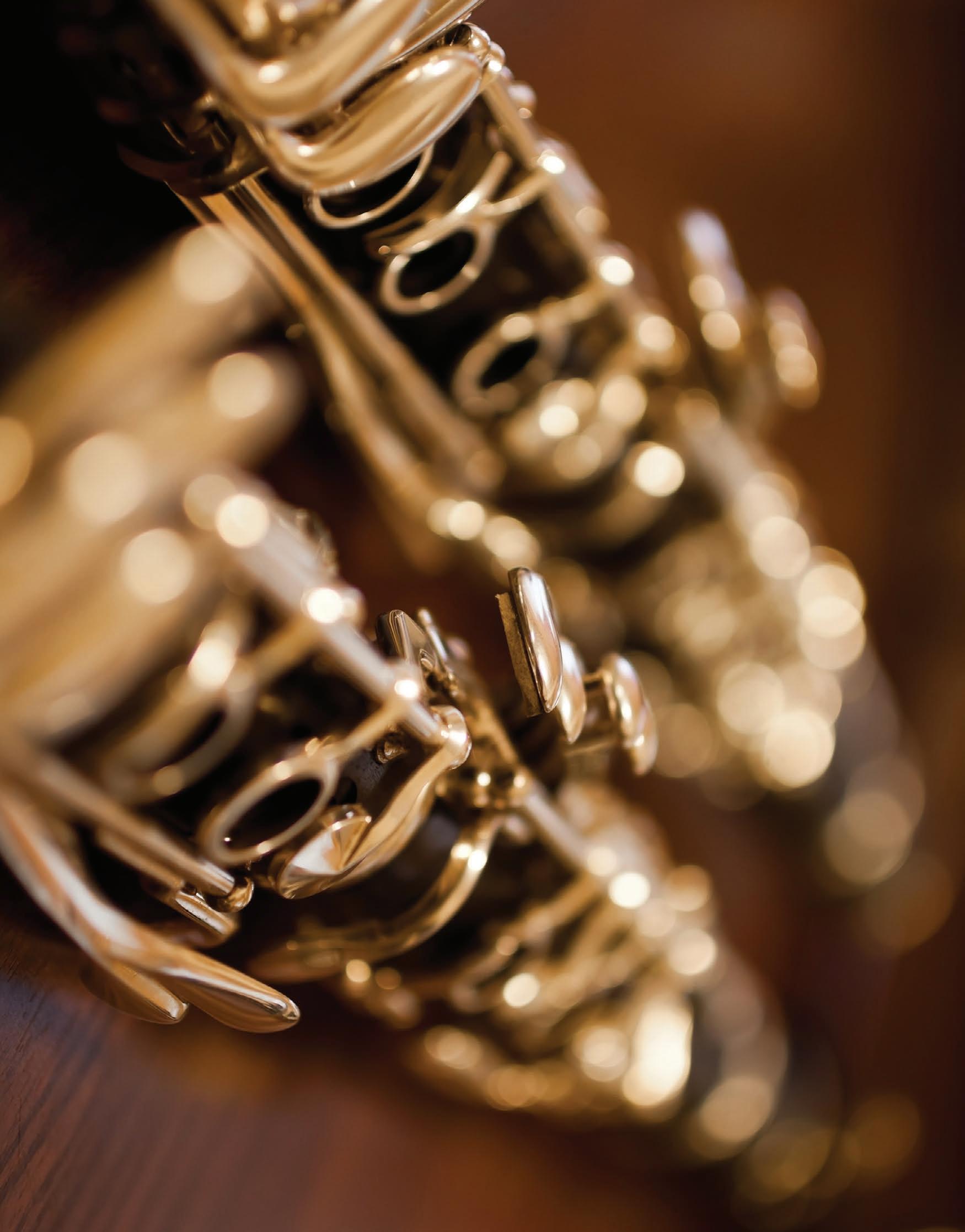
3. Audition
Please scan for more information about our audition process.
Subscribe to our newsletter at baylor.edu/music/subscribe
AUDITION DATES
FRIDAY January 13, 2023
(VOICE, EUPHONIUM/TUBA, PERCUSSION)
SATURDAY January 14, 2023
(VOICE, HIGH BRASS)
FRIDAY & SATURDAY January 27 & 28, 2023
(WOODWINDS, ALL BRASS, STRINGS, VOICE, PERCUSSION, KEYBOARD)
FRIDAY February 3, 2023
(WOODWINDS, STRINGS, VOICE, PERCUSSION)
Auditions are required of all entering and transferring music majors. Please scan to access video archives of our performances.
For more information, visit baylor.edu/music or email Callan Monroe at Callan_Monroe@baylor.edu FACEBOOK baylormusic twitter
SATURDAY February 18, 2023
(LIVE AND VIRTUAL, STRINGS)
SATURDAY February 18, 2023 (KEYBOARD)
@baylor_music INSTAGRAM @baylormusic
Where heart, mind and soul coalesce.
Starting a Mariachi Program from Scratch
By Nadia Eimandoust
There are many reasons to consider starting a mariachi program at your school. Mariachi instruction is becoming increasingly popular throughout the nation, especially in Texas. Many families are connected to Hispanic culture through mariachi and parents are likely to support programs connected to their culture. Students who are involved in a healthy mariachi program can develop better relationships with their family through this shared musical tradition. There is a high demand today for live professional mariachis, and this provides job opportunities for musicians with this knowledge and experience.
Mariachi is widely being taught at the university level, and many mariachi groups experience a variety of performance opportunities. While established mariachi ensembles can take years to develop, young mariachi programs often start off as afterschool clubs and can be fostered by any music director willing to take the first steps. Having performed in professional mariachi groups and taught it at Travis MS for five years, what I offer here are some high-level ideas to help you consider how you could offer this opportunity to your students.
Why Include Mariachi in Schools?
This genre incorporates music theory through basic chord progressions and improvisation, as well as instrumental and vocal technique. A high level of musicianship and musical independence is developed through studying this genre. Ideally, every person sings and plays an instrument, and experienced mariachi students are challenged by advanced rhythmic patterns. Professional
mariachis must be able to transpose music at any given time and perform all music from memory. Academically speaking, students who study mariachi also learn much of the Spanish language.
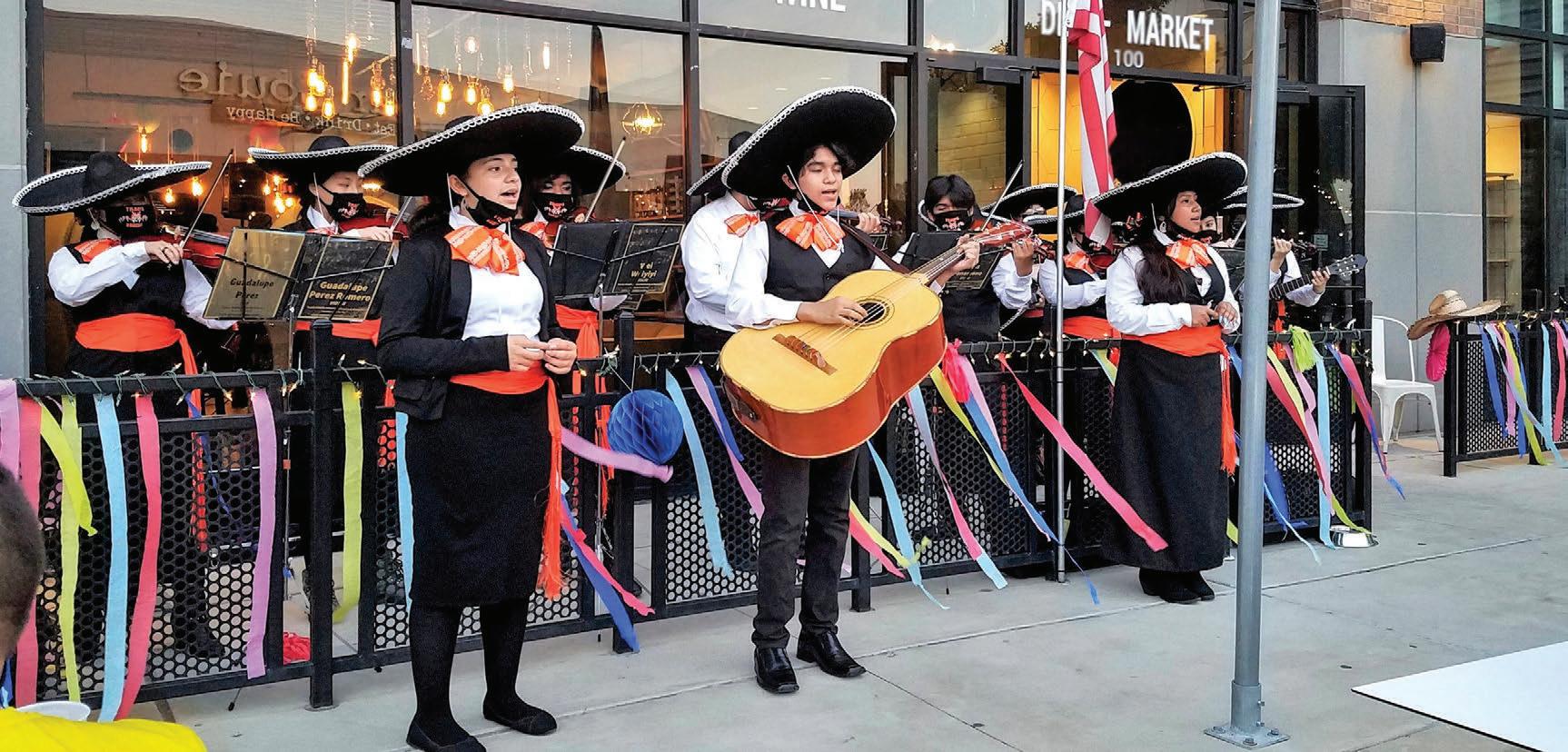
What Instruments Make Up a Mariachi?
One benefit of a mariachi ensemble is that the instrumentation isn’t extensive:
• Violin: melodies, harmonies, and ornaments
• Trumpet: melodies, harmonies, and ornaments
• Armonía: the rhythm section (guitar and vihuela)
• Guitarrón: the bass line (also included as part of the armonía)
• Vocals: solos, harmonies, or choruses
While not all do, some mariachi ensembles include the harp.
Selecting Students for a Starter Group
Violin (and sometimes viola) players are primarily orchestra students, while trumpet players are primarily band students (a budding mariachi program can start with just violins if no trumpet players are available). Anyone can sing—and at some point, everyone will sing!
The guitar, vihuela, and guitarrón are the only instruments typically not already taught in school, so I recommend that the first afterschool practices of a starter program focus on students learning the fundamentals of these instruments. Students who read rhythms well and have good finger dexterity are best suited
37 Southwestern Musician February 2023
for learning guitar and vihuela, while students who already know bass clef are best positioned for learning guitarrón (which can be substituted with plucking the cello or bass if a guitarrón is not available).
Simply stated, all that is required to start a mariachi group is the melody, the rhythm section, and the bass line!
Obtaining Instruments
The most readily available mariachi instrument is the guitar. Some students may already own one and may have some playing experience. Family members,
friends, or coworkers may have instruments no longer in use that they would be willing to donate. Don’t hesitate to publish a request to your community.
Mariachi-specific instruments, such as the vihuela and guitarrón, can be a little trickier to find. Check local online selling platforms, like Facebook Marketplace or Craigslist, for musicians selling these instruments at a bargain price. These days, such instruments are also sold by major music companies.
Ask your administrators and your school board for help—especially in tan-
Clark W Fobes
Clarinet and Saxophone mouthpieces
Responsive, Reed friendly, Reasonably priced!
I am very pleased to return to the TMEA conference after a 2-year hiatus due to COVID. BOOTH #753
As usual, I will have a limited amount FREE Debut mouthpieces to give away to any TMEA member teachers.
We will also have our 10K clarinet and bass clarinet mouthpieces and a variety of clarinet barrels for sale at 10% off!
www.clarkwfobes.com
We will be running some online specials as well during the week of the TMEA convention!
Use code TMEA2023 for 10% discount on any item over $175 with FREE shipping!
Debut NOVA San Francisco 10K
LEUTHNER ISHIMORI PILGERSTORFER
dem with making a solid case for starting a mariachi program from scratch. Demonstrate to them how it can become a vital part of your district’s fine arts offerings. From there, you may need to invest time in fundraising.
Teaching Materials for Mariachi
There are quite a few resources available for teaching the fundamentals of mariachi, such as Mariachi Mastery by Jeff Nevin. This method book includes fundamental setup and technique for each instrument as well as exercises, full songs, a chord chart for guitar and vihuela, and a fingering chart for guitarrón.
Beginner repertoire is commonly in D major or G major, and armonía instruments will need to learn only 2–4 chords to play a full song. Many mariachi teachers also write arrangements of traditional songs suitable for beginning and intermediate students. Ask around as there are many teachers willing to share their arrangements with others seeking repertoire advice.
The Ranchera Valseada , a style of the mariachi genre performed in 3/4 time, is ideal for beginners given the rhythm section’s simple characteristics. The guitarrón always plays the first downbeat of every measure, while the guitar and vihuela play on beats 2 and 3. (In the guitar/vihuela part, the rest at the beginning of each measure allows time for the student to switch chords.) The Ranchera Lenta, a mariachi style in 2/4 or 4/4 time, is also ideal for beginners, as the guitarrón always plays on beats 1 and 3 while the guitar/vihuela play on beats 2 and 4.
Setting Up Rehearsals
If held before or after school, I suggest you rehearse with the mariachi 2–3 times weekly, at least one month before the scheduled first performance. Mariachi practices may begin in the fall semester (after Region auditions) or in the late spring semester (after UIL evaluation and before the spring concert).
I recommend beginning with the armonía, or rhythm section. The most common instrument to start teaching is the guitar, while the easiest would be the vihuela (pronounced vi-WEH-la). The vihuela is smaller and has only five strings compared to the six on a guitar.
The guitarrón can be taught simultaneously with guitar/vihuela or after guitar
38 Southwestern Musician February 2023
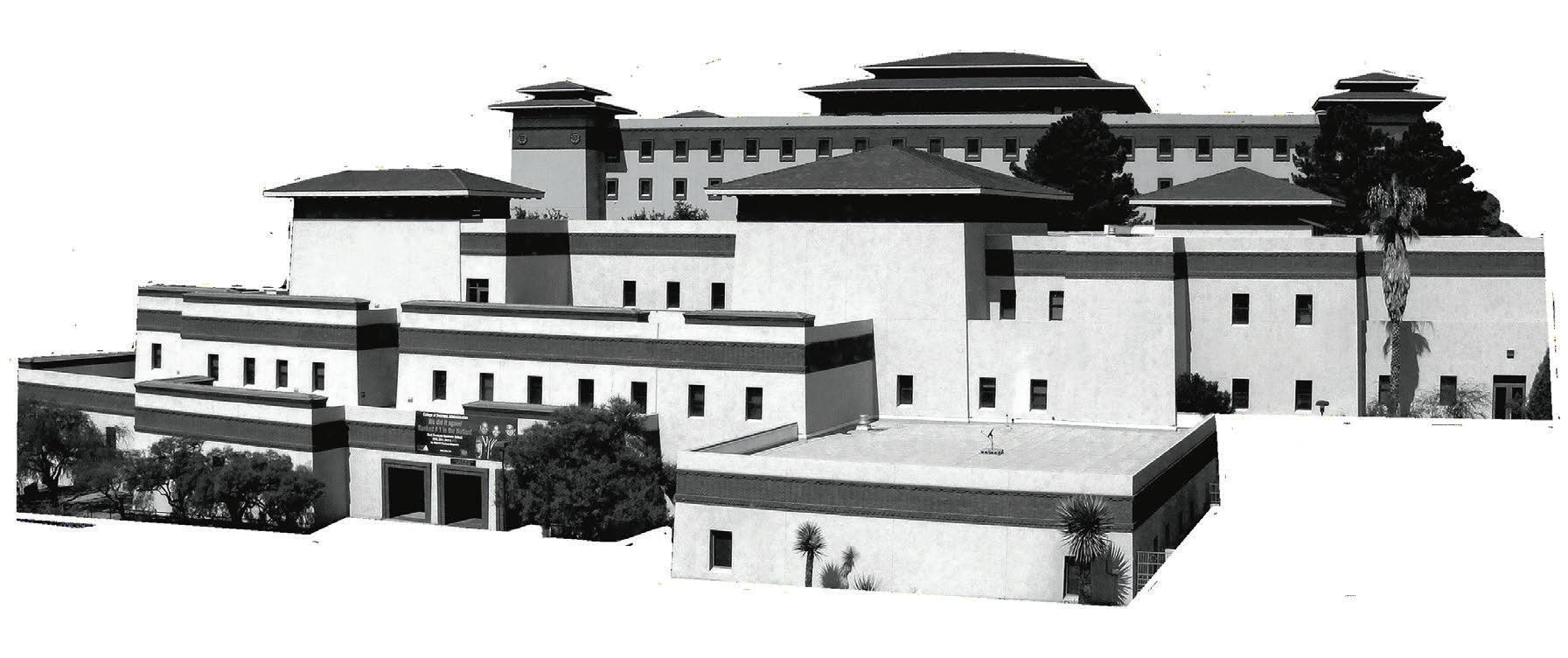
20
25 March 4 To schedule your audition, text AUDITION to 915-207-2481 or scan the QR code
February
February
and vihuela have been introduced. The guitarrón has 6 strings (one set of three lower octave strings, one set of three higher octave strings), and each note is played by plucking the higher octave string and lower octave string at the same time.
Once the armonía students have learned the fundamentals and are comfortable playing through their first song(s), the melody parts can be added. Depending on the ability level of trumpet and violin players, separate sectionals may be held for these parts or joint rehearsals with armonía section(s) may begin.
Adding the Vocal Lines
Plenty of beginning mariachi songs have vocal lines that are easy for most, if not all, students to learn. Traditionally, mariachi singers also play one or multiple mariachi instruments within the group (UIL mariachi contest rules require all singers also play an instrument).
There are typically one to three soloists in professional mariachi arrangements of songs; vocal lines can either be sung as a solo, duet, or trio. Some songs have chorus lines that everyone sings or have chorus parts of the solo that are sung with harmonies. Other songs may not have vocal solos but do have chorus lines that everyone sings.
In an emerging afterschool mariachi program, it is acceptable to start with many singers, versus one or two soloists— this helps instrumental students become more comfortable with singing in front of audiences. It is also okay to invite students who do not play an instrument to be a part of the mariachi group as vocalists. This provides opportunities for students who may not have been able to sign up for a music class at their school and can even be used as a recruitment tool.
A good tip for teaching vocal parts when time and resources are limited is
Mariachi at the TMEA Clinic/Convention
Check the convention schedule for multiple opportunities to learn more about teaching mariachi and to enjoy mariachi performances by our Invited Mariachi Ensemble and our 2023 All-State Mariachi Ensemble. You can also learn by attending a rehearsal of the All-State Mariachi Ensemble during the All-State rehearsal sessions listed in the schedule.
to have students listen to recordings of the song while studying the lyrics. These recordings can be videos from YouTube or prerecorded by the teacher.
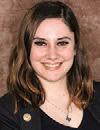
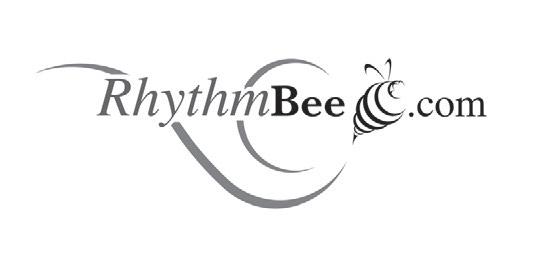
Mariachi Uniforms
The traditional mariachi suit is the traje de charro, which typically consists of pants or long skirt, jacket, vest, moño (bowtie), boots, and sombrero. The pants/skirt, jacket, and vest are adorned with either botonadura/gala (shiny buttons), greca (finely-stitched leather patterns), or bordado (embroidery).
Authentic mariachi trajes can cost hundreds to thousands of dollars each. That said, there are simpler, cost-effective ways to accessorize your mariachi while maintaining the customary mariachi image. For example, collared, long-sleeved button-up shirts can be worn with solid black pants/ skirts and shoes.
The moño is a distinctive and inexpensive mariachi accessory that all students can wear. The rebozo (sash worn by ladies around the waist) is another accessory that can add to your group’s appearance without breaking the bank. Simple black vests can be worn to complete the look, and school mariachi T-shirts or polo shirts can be designed for casual performances.
It’s Showtime!
When your students are ready to showcase their skills, they can perform one or two songs at the next fall, winter, or spring concert. After that, rehearsals can focus on learning new repertoire and building a set list. Reach out to the community and ask about local performance opportunities for your group. If your school allows you to open a club account or booster club for the mariachi, you can accept donations in exchange for performances. As the mariachi program continues to grow, peer-topeer tutoring and mentorship from students become the most effective ways to teach new recruits, establish positive relationships, and build skills for life. 0
Best Value Subscription extends to July 1, 2024 Includes an app for every student * * * * * * * * * * * * * * * * * * * * * * * * ** * * * * * * * * * * * * * * * * * * * * * * * * * * Sequential Animated Curricula for Band, Choir, Orchestra, Elementary Music Rhythm / Solfeggio / Curwen / Math Facts / PreK Music Reading Readiness 1 & 2 & / 1 te 2 te / Ta Ta Ti Ti Ti Ti * * * * * * * * * * * * * * * * * * * * * * * * * * * * * * * * * * * * * * * * * * ** * * * * * * * * * * Windows,Mac,Android orders@rhythmbee.com 903-725-3304
Nadia Eimandoust is the head orchestra and mariachi director at Travis MS in Irving ISD.
40 Southwestern Musician February 2023
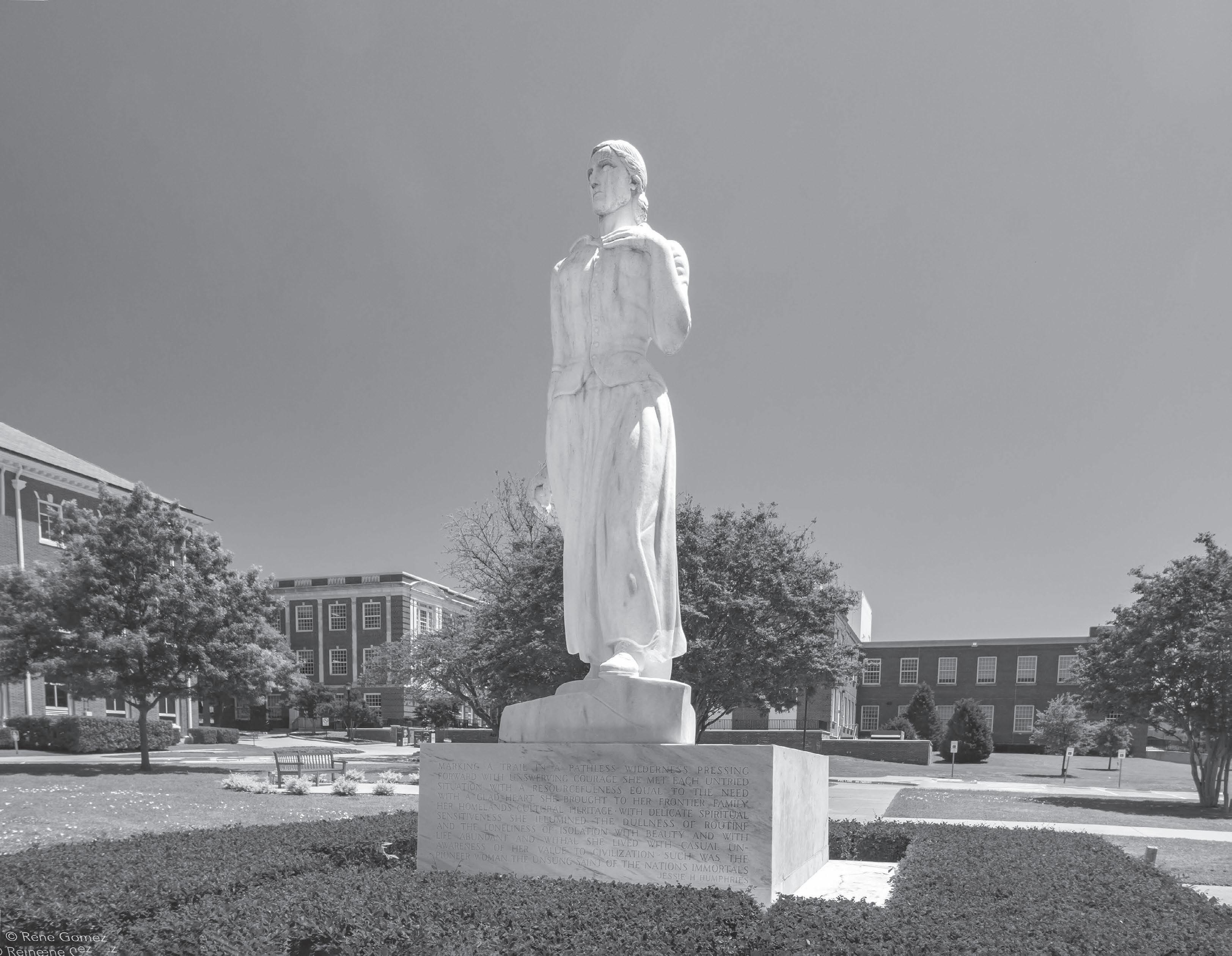
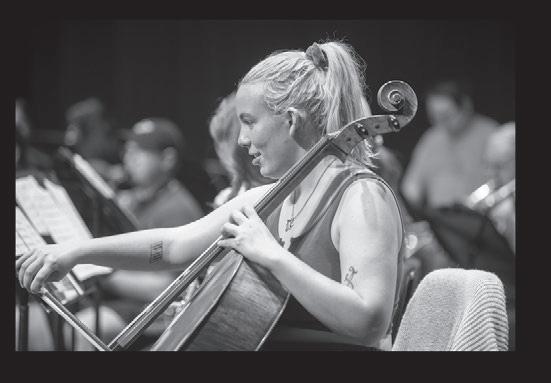

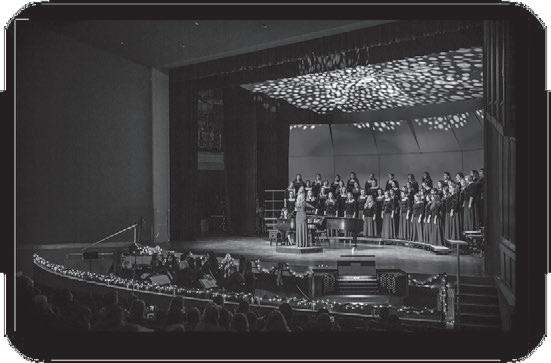


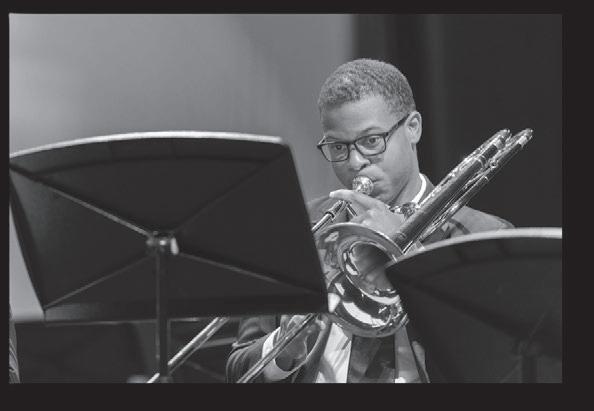

TWUDivisionofMusic TWUMusic TWUMusicDept Follow us: AUDITIONS January 21, 2023 February 18, 2023 March 11, 2023 April 22, 2023 Undergraduate Degrees Liberal Arts Music Music Education Music Performance Music Therapy Graduate Degrees Music Education Music Pedagogy Music Performance Music Therapy Scholarships and assistantships available For more information, visit twu.edu/music TWU is proud to announce our new Zero Tuition Guarantee. Visit twu.edu/zero for more information, and make sure to submit your FAFSA by March 1, 2023.
TMEA Vocal Vice-President JESSE CANNON II
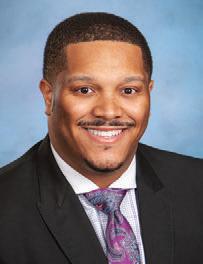
The Climb of Your Life
The best and most experienced climbers know to never climb alone. Even if you could climb the mountain by yourself, you shouldn’t. What a great lesson for us in this challenging profession!
In Memoriam
We have made it through the fall semester, enjoyed the holidays, and are beginning to tackle the new year. The journey to this point hasn’t been without its challenges and adjustments in our classrooms. As we proceed into this spring semester, we can look forward to attending the 2023 TMEA Clinic/Convention, where we can gain great ideas from amazing educators’ presentations and concerts that will help us on our journey. As it has offered countless teachers who have gone before, this event is sure to fuel us to finish the year strong. I hope you can attend and that we have an opportunity to connect in San Antonio.
While thinking about what I should write for my final column as Vocal Division Vice-President, I reflected on a question I was once asked during an interview. “Why do people climb mountains?” It was certainly a question that had never been discussed in any education methods course, and I found myself unprepared to answer it. However, once I left the interview, I vowed to have a much better answer in the event it came up again. Now, my answer would be that someone along their journey told them they couldn’t, and that fueled them to begin.
Along my journey I have found that each mountain has its own lesson and that submitting ourselves to the vulnerable space of learning, truthfinding, and the applications they bring can transform what was once an unconquerable chasm into a tamed terrain. Only upon later reflection do we realize the mountain never changed; the change was within us
Like music educators, every climber needs supplies required for a climb—boots, clothes, food, tools, ropes, and much more. But even the best supplies can’t solve every climbing hazard one might face. The best and most experienced climbers know to never climb alone. Even if you
Dennis Pitcock 1955–2022
Brian Stratton 1959–2022
MARK YOUR CALENDAR
check www.tmea .org for updates
February—Renew your membership and register for the convention.
February 8–11 —TMEA Clinic/Convention in San Antonio.
February 9, 8:15 a.m.—TMEA General Session in Lila Cockrell Theatre.
February 9, 5:15 p.m.—Vocal Division business meeting at the convention.
February 10, 5:15 p.m.—TMEA Region meetings at the convention.
March 1 —Texas Music Scholar online application opens.
42 Southwestern Musician February 2023
PERFORMANCE PASSION PRIDE
OFFERING BACHELOR’S AND MASTER’S DEGREES IN MUSIC
EMPHASIZING MUSIC EDUCATION OR PERFORMANCE
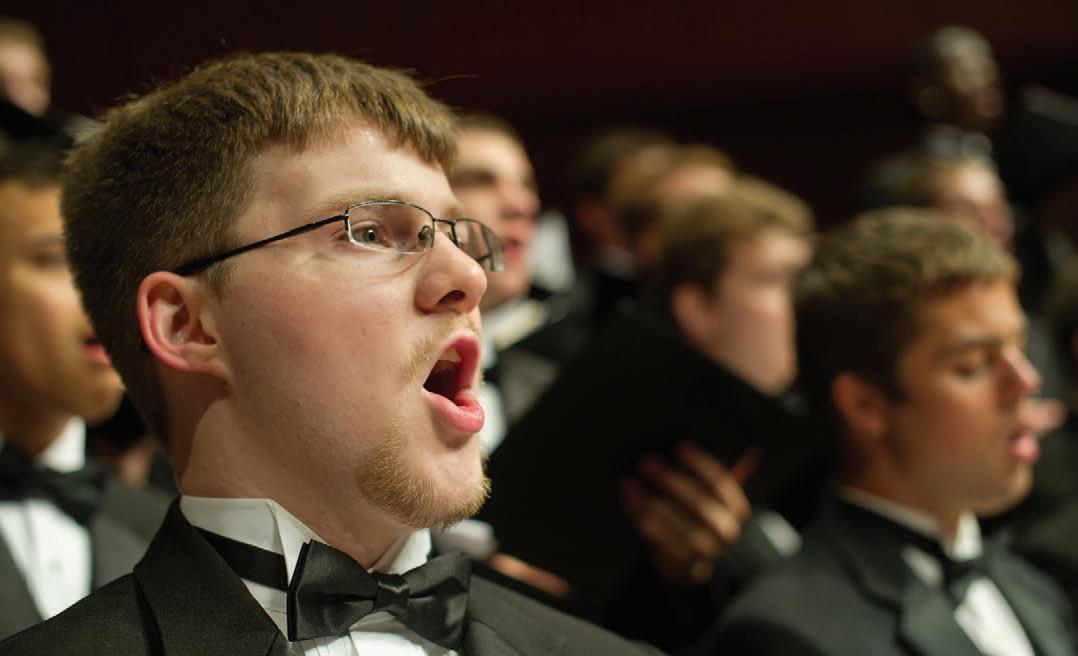
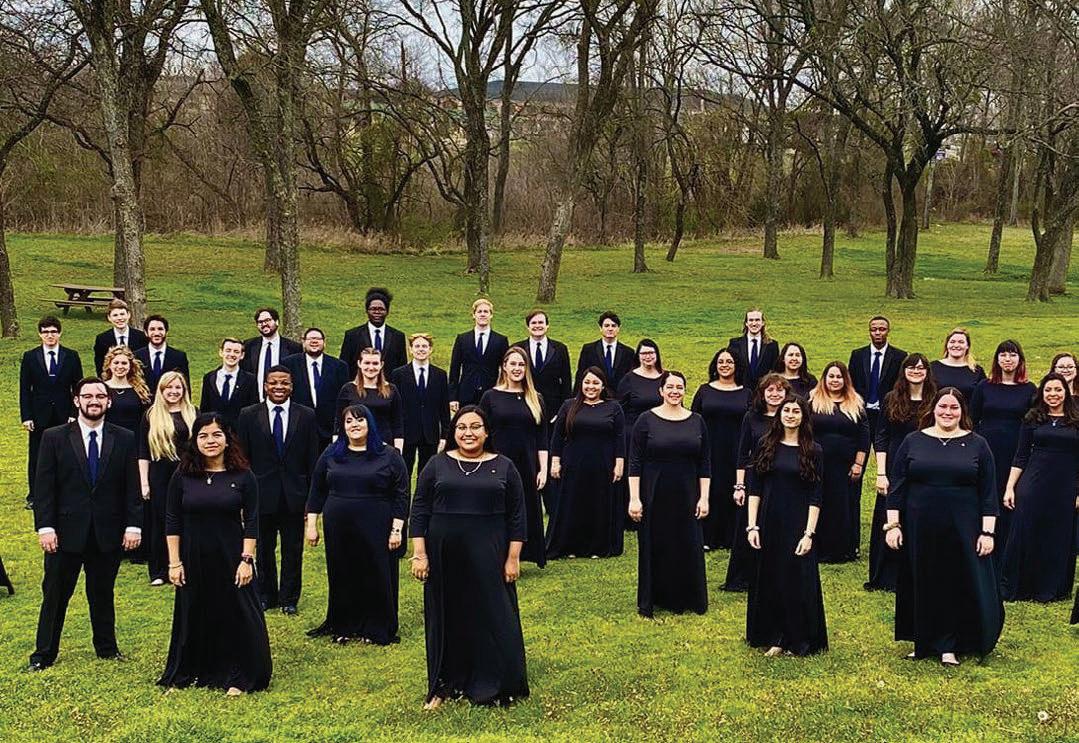

2023 Admission & Scholarship Audition Dates:

February 18
February 25 (Instrumental Majors only)
March 4 (Vocal Majors only)
March 11
April 1 (Instrumental Non-music Majors only)
@TAMUCMusic • @TAMUCBands • @TAMUCChoirs tamuc.edu/music • 903-886-5303
OF
All-Steinway School with Spirio
A Member of the Texas A&M University System DEPARTMENT
MUSIC An
Designation
BLINN COLLEGE MUSIC DEPARTMENT
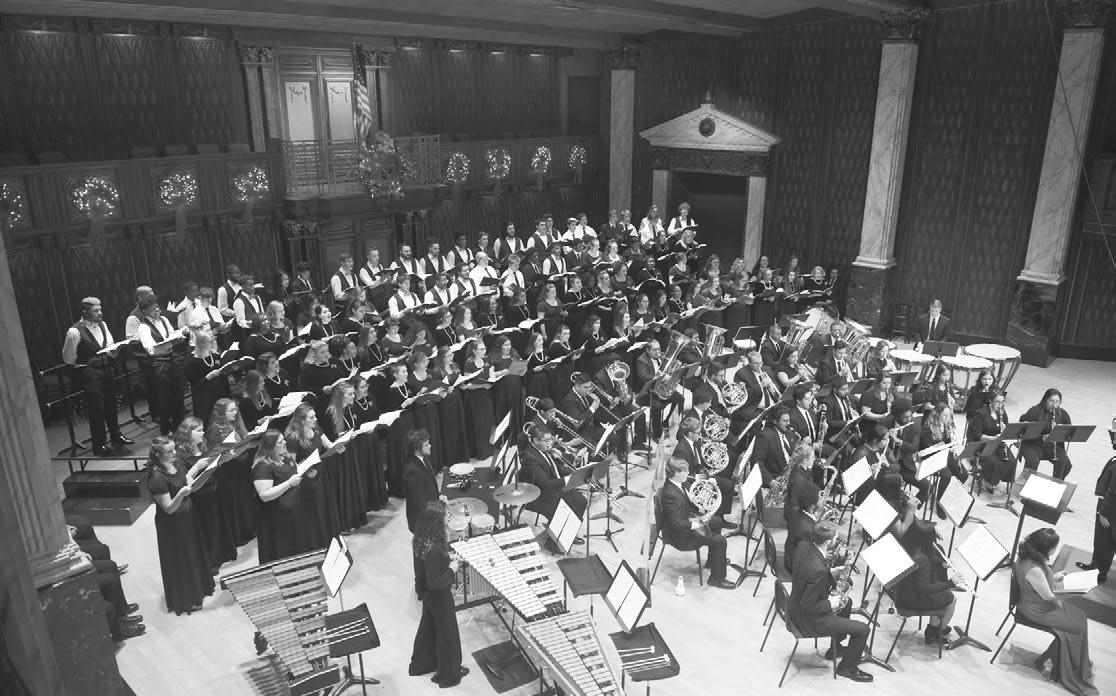
Blinn’s band and choir are open to music majors and non-majors alike. Schedule an audition and you could perform at world-class venues while living alongside your fellow band members in our Brenham Campus residence halls!
Scholarships are available!
www.blinn.edu/music
Fall 2023 auditions are available on:
February 4, 2023 (band only)
February 25, 2023 (band and choir)
March 18, 2023 (band and choir)
April 1, 2023 (band only)
April 15, 2023 (band and choir)
May 13, 2023 (band and choir)
To schedule an audition, scan the QR code below.

could climb the mountain by yourself, you shouldn’t. What a great lesson for us in this challenging profession! It can be easy to believe we have it all figured out after many years in a job, but that’s no reason to do it alone. And for those who are sole choir directors on their campus, this climbing reference offers a serious reminder to seek out a mentor, someone you can trust to support you on your ascent in the profession.
I have been fortunate to climb alongside some of Texas’s finest music educators. Each of you strives to ensure high-quality music education is offered to every student at every level. My hope is that many more TMEA members will consider adding to their professional journey in terms of service to our organization. TMEA offers many volunteer roles within the framework of the association, from an ensemble organizer in your Region to running for a Region or state office. Spending time doing this and being knowledgeable about other divisions will help you recognize that we are all in this together.
• Climbing mountains teaches you patience, persistence, and gratitude.
• Climbing mountains teaches you how to be positive.
• Climbing mountains teaches you about change and being prepared for change.
Sound familiar?
Sincere Thanks
It has been a joy and tremendous honor to serve as the Vocal Division VicePresident and State Chair. Thanks go to each of you for your trust in me as a leader and for this opportunity. I hope you will join me for the Vocal Division business meeting on Thursday, February 9, at 5:15 p.m. In addition to our General Session, this meeting offers you the opportunity to stay informed and play an active role in the future of our association. In this meeting, you will vote to our elect our next Vocal Division Vice-President.
TMEA Clinic/Convention Update
While our early registration deadline has passed, it’s still not too late to register to attend the convention (which will make your badge pickup easier). Go to www.tmea.org/register. This year’s event will feature amazing clinics, performances, and a packed exhibit hall with the
best prices on music industry resources and more! When you make your schedule in the convention app (which you can download directly from your app store by searching on TMEA), consider observing one or more of our All-State rehearsals. These open rehearsal sessions are in the main schedule in the app, and you can find specific locations in the All-State Rehearsal section of the app (each All-State Choir is rehearsing in close proximity in the CC 300s on the third floor near Stars at Night Ballroom).
Invited Choir Concert Location
In addition to some changes in our clinic locations from previous years, know that our Invited Choir concerts will be in the Stars at Night Ballroom 2–4 on the third floor of the convention center on the north side (above the North Lobby).
Vocal Clinics in the Grand Hyatt
On Thursday and Friday at 2:30 p.m., the Vocal Division will host additional clinics in the Grand Hyatt second- and fourth-floor ballrooms. This space is available to us because the Elementary Division doesn’t have any clinics scheduled during that hour. We appreciate being able to offer more vocal pedagogy sessions in the schedule based on that space availability. It’s just a short walk to the Grand Hyatt and up the escalator to attend. Please make note in your schedule so that you’re aware of each event location in case you need to
exit the convention center to attend.
Invited Performing Choirs
It’s not too early to begin thinking about applying for your ensemble to perform for the 2024 Clinic/Convention. More information regarding dates, supplemental materials requested, and requirements can be found at www.tmea.org/invitedchoir.
Choirs Represent Texas at ACDA
Congratulations to our esteemed colleagues and friends who will represent Texas at the ACDA National Conference later this month! The excellence in choirs continues the grand tradition for which Texas is known.
• Faubion MS Bella Voce Treble Chorus, Liz Turner, conductor
• Grand Prairie Fine Arts Academy Tenor/Bass Singers, Joel Duarte, conductor
• Mansfield HS Varsity Treble, Reginal Wright, conductor
• Texas Christian University Concert Chorale, Christopher Aspaas, conductor
• Timber Creek HS Chamber Choir, Adrian Kirtley, conductor
• Vandegrift HS Chamber Choir, Michael Zook, conductor
Kudos to these programs and their singers! 0
NORTHEAST CAMPUS MUSIC DEPARTMENT 828W.HarwoodRoad•Hurst,TX76054 www.tccd.edu•817-515-6105
®
ASSOCIATEOF ARTSIN MUSIC CHORAL •BRASS •WOODWIND •GUITAR •PIANO •PERCUSSION •S TRINGS •HARP •VOICE •JAZZ ALL-STATECHOIRMUSICCAMP July 2 4 - July 27, 2023 • 10:30 A.M. - 5 P.M.
EqualOpportunity/EqualAccessInstitution 45 Southwestern Musician February 2023
Gerald.Ringe@tccd.edu - Woodwinds & Brass Warren.Dewey@tccd.edu - Percussion Jeff.Lankov@tccd.edu - Piano Hsinyi.Wang@tccd.edu - Strings Philippe.Baugh@tccd.edu - Jazz William.Waldroup@tccd.edu - Music Theory Patricia.Schimpf@tccd.edu - Music Counselor
Three Rs of Small School Choir Success
BY MICHELLE CHRISTNER & WILL GRISWOLD
The landscape of choral music education across our state is diverse. Some of us teach in historic programs dating back decades that enroll 200–300 students each year. Some teach in very large districts that employ multiple fine arts administrators and work with many other choral colleagues. For others though, the situation is quite different. Perhaps you teach in a setting that lacks administrative support personnel and robust enrollment, and where few or no other choral colleagues are nearby. If that’s the case, regardless of the size of your school, you likely face the same challenges of small school directors. At times, these challenges can be overwhelming, especially if you teach on your own. To overcome them and positively impact your program’s long-term success, we recommend focusing on the following areas: repertoire, rehearsal, and rapport. And while our focus is on small school programs, what we offer here often applies in other school environments.
Repertoire
When considering repertoire for the small school choir program, it is imperative to have a purpose for each piece we select. A song can be selected to build rudimentary skills, to perform at festivals and evaluations, or to offer a contemporary experience that utilizes different vocal techniques outside the bel canto style of singing. Despite these various purposes, the most important guiding principle I have followed is that if you don’t like it, they won’t either.
Rather than focusing solely on pieces that check the right boxes, spend time searching for pieces you also truly enjoy, from every genre and era. Here are six ways to help you find music that you and your students will love to rehearse and perform.
• Spend more time selecting music than anything else you do. Most teachers rehearse repertoire every day and it is crucial not to rush the search and selection process. Start searching as far ahead of time as possible and keep a running document of songs you want to program later.
• The text must be believable. We constantly need to recruit and retain, and one thing that will turn students away is selecting music they would describe as cheesy, corny, or surfacy. We must consider the age appropriateness of music as well as our potential to tell a story through our repertoire.
• Look for pieces with wow moments. Powerful chord progressions, unpredictable cadences, memorable climaxes, and moving resolutions—these compositional elements draw students in and keep them coming back for more.
• Find an emotional connection. We should always attempt to program a wide range of emotions, even within a two- or three-song set. What distinguishes choir from band and orchestra is the text, and we must take advantage of that by providing our students music that can impact them on an emotional level.
• Delay divisi. The number one recruitment and retention tool we have is experiencing success. Asking students to learn music beyond their current skill levels can be frustrating and defeating. Focus on selecting music your choirs will perform successfully, regardless of what you notice others are programming for their students.
• Look for repertoire in a variety of places. Simple strategies, such as bookmarking favorite publisher websites, saving
46 Southwestern Musician February 2023
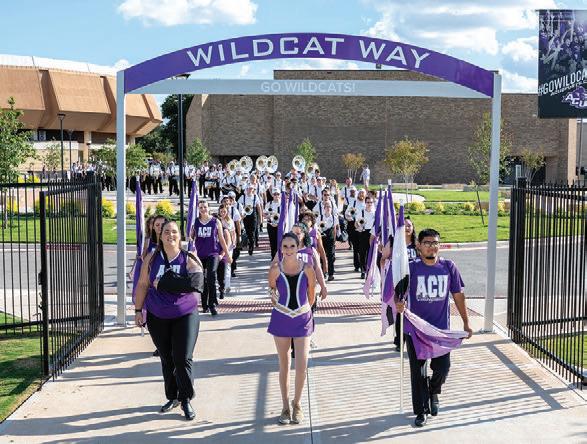


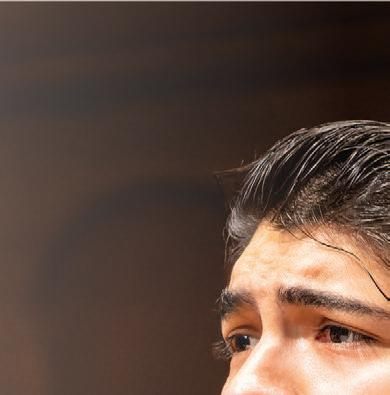






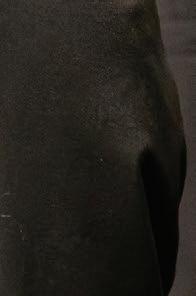
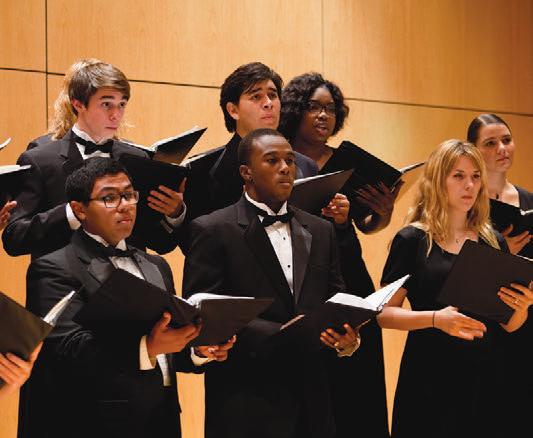





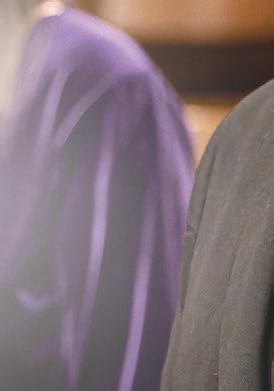









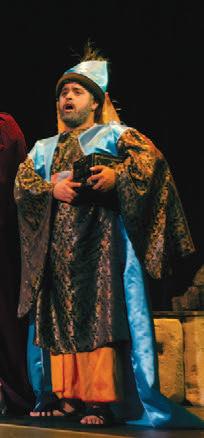
programs from Region and All-State concerts, or going directly to a composer’s website can make it easier for you to find appropriate pieces for your choirs.
From a repertoire standpoint, building a program takes a lot of patience. It requires you to teach works that may not challenge you musically, but they will challenge you pedagogically, and that’s equally important in the long run. Selecting music for our choirs to perform is one of the most important responsibilities we have as teachers. Our repertoire is our curriculum, and without a quality curriculum, our students will not be able to reach their full potential.
Rehearsal
Running a rehearsal effectively is about relationships. As teachers we can get caught up in prescriptive definitions and expected rehearsal techniques, but if we want our students to enjoy being in our classroom, we must first establish genuine relationships with them. These relationships are at the core of every choir program, and we build them by earning each other’s trust. This trust must also be established between
the students in our rooms. Establishing clear expectations about respect and communication between students is vital for effective and enjoyable rehearsals.
That said, under the stress of concert preparation, we sometimes neglect to offer opportunities for students to bond during rehearsals. As a small school director, strategic planning and creative solutions are required to provide social opportunities in class while having time to prepare for each concert.
One of the best ways we can accomplish this is by empowering our students to become classroom leaders. This typically begins by establishing section leaders. Ideally these students have some background in piano and sightreading skills, but often their capacity for leadership is more important than their musical aptitude. It is important that we teach successful sectional skills to all students. This includes how to break down music into smaller chunks, how to isolate tricky intervals, and how to adjust tempo for rhythmic sections. We assume students know these skills because we regularly use them as teachers, but our teaching techniques are often not absorbed by our students, so
JOIN US IN 2023
choirs.music.txstate.edu
demonstration is necessary.
Lastly, giving students demo recordings or practice tracks can highly benefit teachers in small school settings. These tools make it possible to split your classroom into sections while you float in between groups. Whether you have a large or small class, teaching by yourself can feel overwhelming, but if you plan carefully and set limited, achievable goals (ones that students can help you reach), preparation for concerts and trust-building activities are both possible. Concert preparation is important but not to the degree that classroom rehearsals become mundane or overly intense. Students should leave every rehearsal feeling encouraged.
Rapport


Building rapport with your community and school is vital for a successful small school choir program. Make it a priority to connect with your colleagues directing other programs and the students who participate. Attend athletic events, theater productions, and other schoolwide events in which your current and future students are involved.
Continue expanding your visibility on
Opportunities to advance your pedagogy, conducting, and research education
May 30–August 3
Online/Interactive offerings available
Three paths to a master’s: Accelerated (18 Months); Full time (2 years); Summers only (3 years)
June 19–23
Featuring the Texas State choral faculty including Craig Hella Johnson
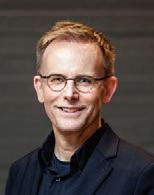
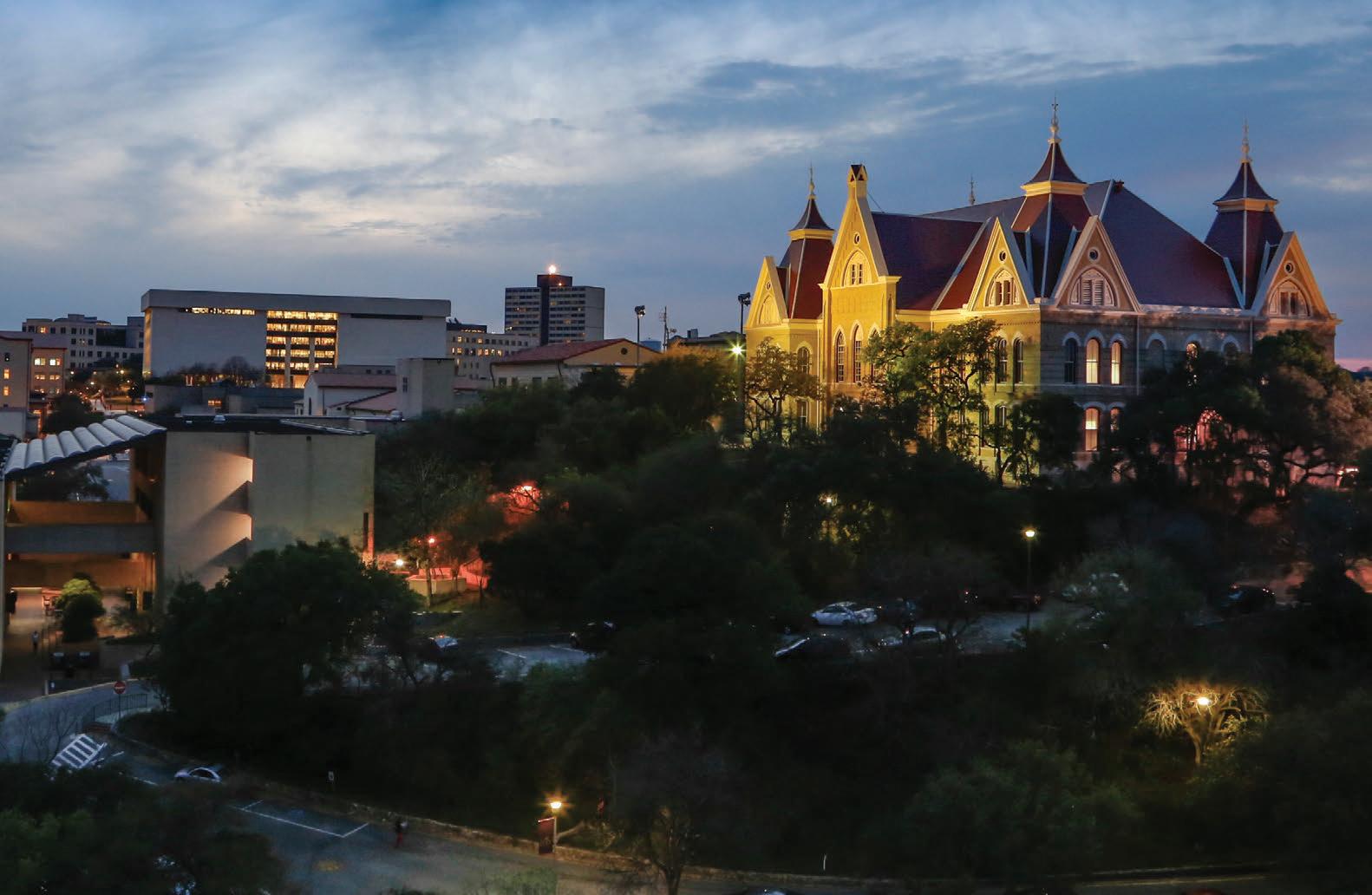
July 5–8
Tuition: Resident ($375), Commuter ($275)
Registration deadline: June 15
Discounts: ‘23 All State Member or school group of 10+ ($50)
TEXAS STATE/CONSPIRARE CHORAL CONDUCTING SYMPOSIUM
Refine
@Texas State Choir Camp @TXSTCHOIRCAMP
Renue &
Texas State
to the extent not in conflict
federal or state law, prohibits discrimination or harassment on the basis of race, color, national origin, age, sex, religion, disability,
status, sexual orientation,gender identity or expression. Texas State University is a tobacco-free campus.
CHORAL
CHORAL
University,
with
veterans’
Master of Music
CONDUCTING
MUSIC ED
48 Southwestern Musician February 2023
ALL-STATE CHOIR CAMP
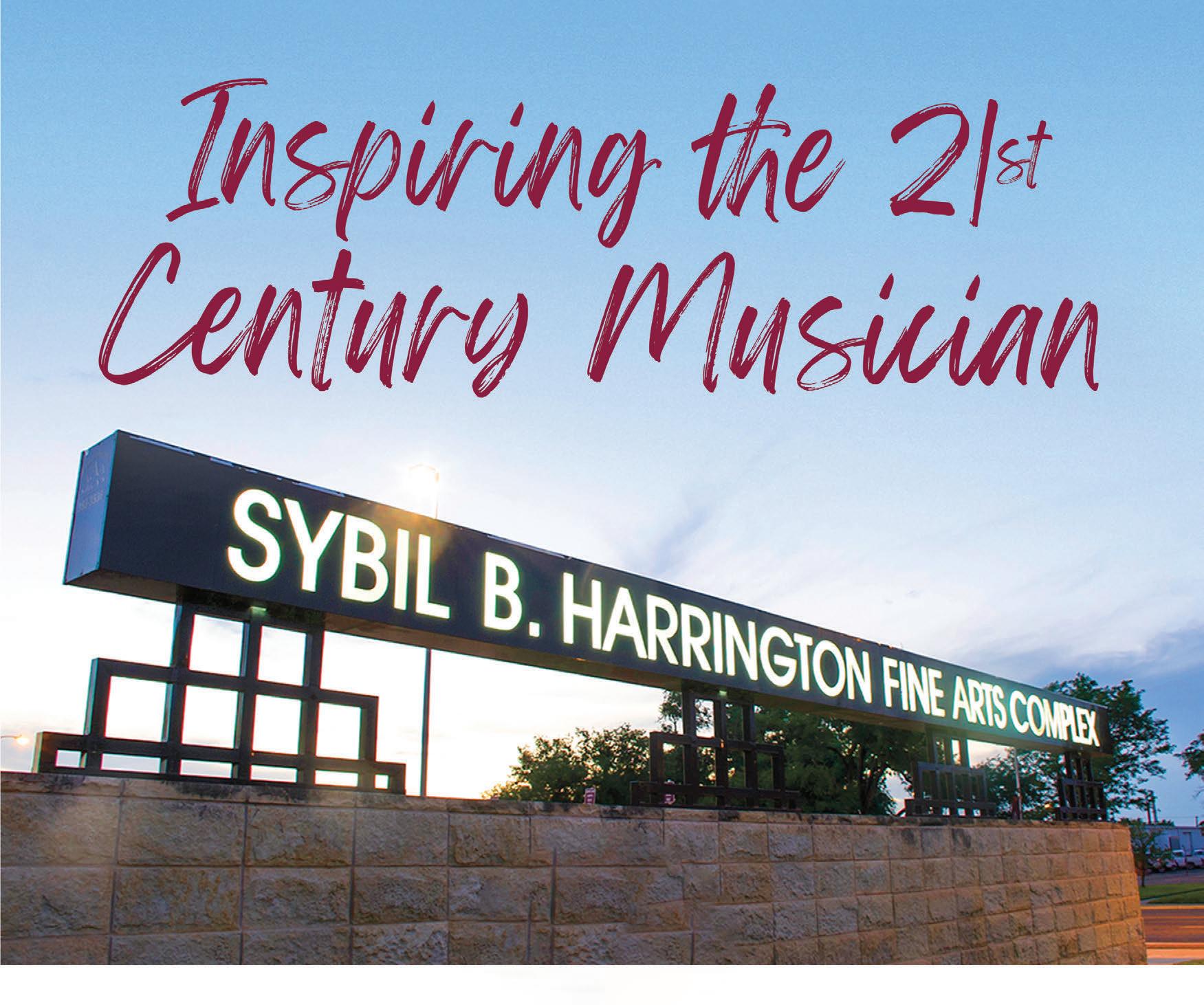
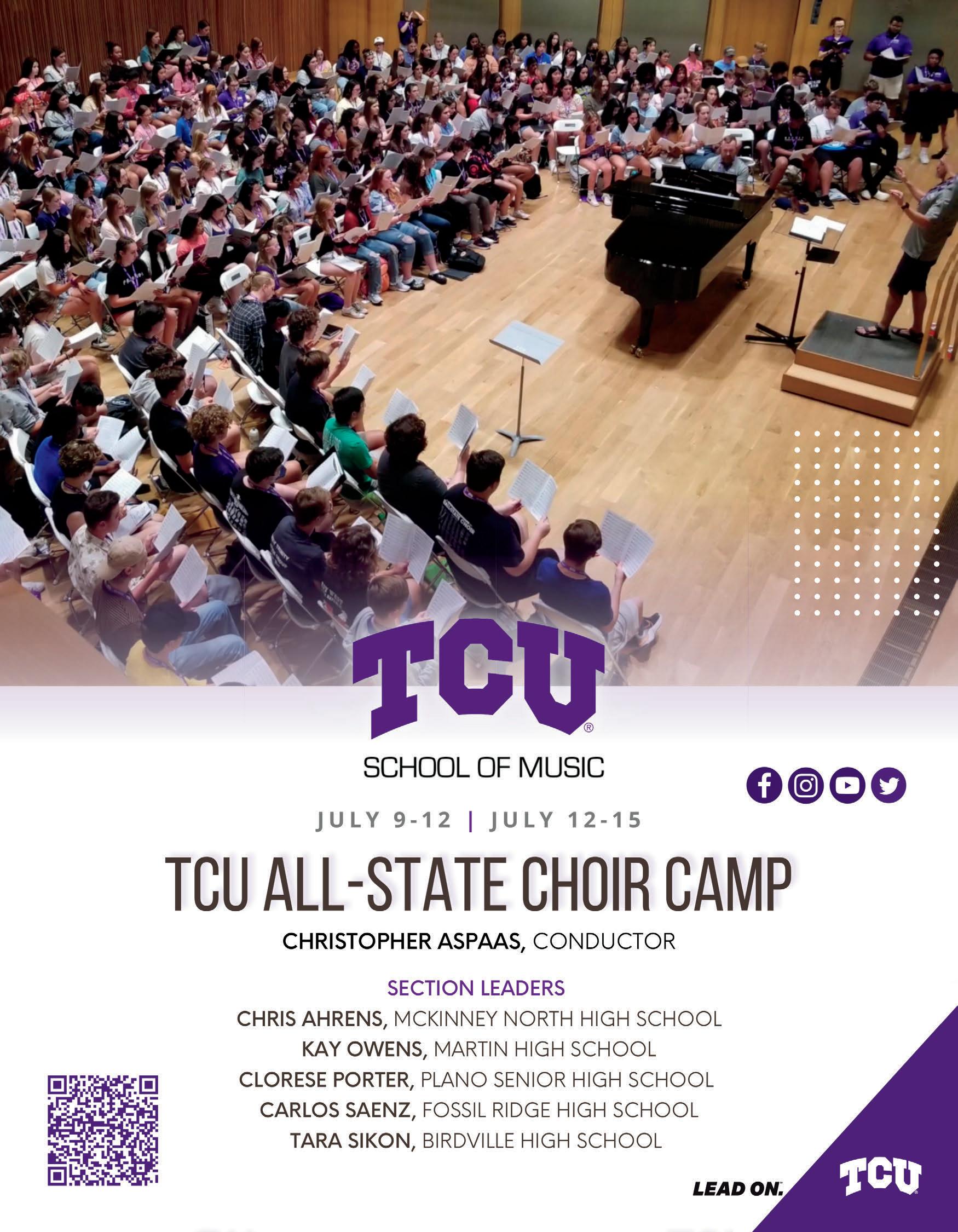
campus by searching for ways your students can participate in school events using their voices. Some examples are performing for incoming freshmen, teaching the alma mater, performing the national anthem at athletic events, serenading front office staff on birthdays, and sharing holiday songs in approved areas of the building. It is important to involve your students in large assembly events such as pep rallies.
Contact your chamber of commerce, or if they contact you, respond promptly. Explore how you and your students can enhance community events and contribute to community culture. Singing throughout the community will also help build your choir concert audience. As members of the community become familiar with your program, they will be motivated to see your students perform and will support your goals.
Work to establish a positive and genuine communication link with your administrators and operational department staff. Your choir program depends on each of these departments to function. Requisitions are your responsibility—you are the advocate! It will be up to you to acquire all approvals; therefore, building and maintaining strong rapport with these colleagues will greatly benefit your choral program.
It is imperative to work to ensure your principal, counselors, and superintendent support your vision. Do your very best to have all paperwork in early and meet your deadlines, and when they ask you to do something that has nothing to do with your program, do it with a smile.
In a small tax-based community, choir typically does not have a healthy budget. Fundraising is inevitable through your student activities or resourcing outside your school by establishing a choir boosters/parent club. This will make a difference in the eyes of your administration.
It is also imperative to have a plan for student and program growth. Establish goals to help your young people find themselves. Once they do, they can create
themselves! Believe in yourself and know your limits, because there is only so much you can accomplish successfully with the time and resources available. Recruitment and retention are essential for growth. All assigned teacher duties are evangelistic opportunities to interact with more students. Students know whether you genuinely care. Put your phone away! Half the battle is gaining students’ trust by showing true interest. In many cases this will lead to their interest in joining choir.
School pride and passion will ignite a yearning for success. Exhibit what a successful choir program looks and sounds like. TMEA, TCDA, and UIL offer excellent opportunities for your program to build success. Provide strong support and instruction needed for students to experience success, and through these events, develop positive relationships with music colleagues in your Region and Area. Lead by example by avoiding toxic conversations about other programs or yours. Poorly chosen words can quickly diminish your ability to advance your program. Ultimately, ratings should not drive our programs. Instilling a quest for excellence
and a fervent desire in each student to grow and learn every day provides a solid foundation for a program that endures and leaves students with memories to cherish for a lifetime.
Selecting high-quality repertoire, running efficient and effective rehearsals, and building genuine rapport with students, staff, and the community, can greatly impact the direction and success of your choral program. It is impossible to improve every aspect of your program at once, but if you are looking for a place to start, focus on these three Rs. You have the potential to set a new course for your program and build a legacy that will last long after you retire. Until then, reach out to your colleagues for advice, offer your assistance to a new director in your area, and become an active member in professional choral music education organizations.
You never know the impact you might have on a director in need and what you might learn by helping someone else. 0
Michelle Christner is the director of choirs for Sinton HS & Smith MS (Sinton ISD) and has taught for 18 years.
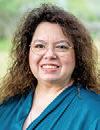
Will Griswold taught music in the DFW Metroplex for six years and is currently a DMA Choral Conducting student at the University of Southern Mississippi.

Give a life-long gift... LOVE of Classical Music Over 1600 schools use Mighty Music materials to teach the UIL Music Memory Program each year. 2023-2024 Find us on www.musicmemory.com Now offering supplemental diverse listening Sets Jazz, Latin, and Classical, featuring under-represented composers. All 2023-2024 teacher and student materials available for pre-order online! 51 Southwestern Musician February 2023
Instilling a quest for excellence and a fervent desire in each student to grow and learn every day provides a solid foundation for a program that endures and leaves students with memories to cherish for a lifetime.
TMEA Elementary Vice-President
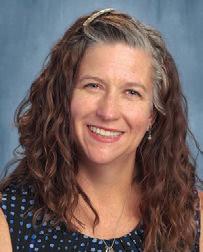 KATHERINE JOHNS
KATHERINE JOHNS
We’re All in This Together
There will always be things we struggle with and things we try to improve in our classrooms. Through it all, we must be present and engaged with our students.
As I write this column, I have two things on my mind. The first is that this month we will be together for the 2023 TMEA Clinic/Convention! This is my second and final convention to organize for the wonderful Elementary Division. I learned a lot from our 2022 convention and have worked to make improvements for this upcoming event. At the end of this column, learn about two of our division’s Invited Ensembles that will perform at the convention. Be sure to include their performances and all others in your schedule!
In the December edition of Southwestern Musician, the schedule for the convention was featured. Many of the topics being presented are common themes that often need to be covered, like classroom management and teaching older elementary students. But there are also some new topics that will be outside the norm, such as bucket drumming and teaching with black lights.
Elementary Division members can also look forward to the door prizes organized by Becky Compton that will be awarded after our brief Elementary Division business meeting on Thursday at 5:15 p.m. in the Grand Hyatt Texas Ballroom. Please attend the meeting so that you can be updated on association business and cast your vote to elect our next TMEA Elementary Vice-President. Note that our clinic schedule runs beyond that meeting on Thursday, with two great movement sessions by Denise Gagne and John Jacobson and a session presented by former Elementary Division Vice-President Michele Hobizal.
Another exciting announcement is that our Elementary Invited Ensemble concerts will be in the convention center Stars at Night Ballroom, closer to the Grand Hyatt than in past years. Simply exit the Grand Hyatt, go right, and enter the convention center. Immediately go up to the third floor and you’ll be there.
MARK YOUR CALENDAR
February—Renew your membership and register for the convention.
February 8–11 —TMEA Clinic/Convention in San Antonio.
February 9, 8:15 a.m.—TMEA General Session in Lila Cockrell Theatre.
February 9, 5:15 p.m.—Elementary Division business meeting at the convention.
February 10, 5:15 p.m.—TMEA Region meetings at the convention.
.org for updates 52 Southwestern Musician February 2023
check www.tmea
Peripole is proud to Sponsor at TMEA 2023: Sessions by Richard Lawton
Providing All Instruments for Lonestar Ballroom, A,B,C
Exclusive Distributors Bergerault Or Instruments
• Best in Quality, Value, and Sound

• The Chosen Brand of leading Or Educators
• Personalized service and school discounted pricing online.
Shop Online: www.peripole.com





(800) 443-3592
Download our catalog today!
When quality matters most, Peripole Music and Bergerault Or excels:














1. Xylophone bars are pure select heartwood rosewood cut wider and longer for the best sound quality.

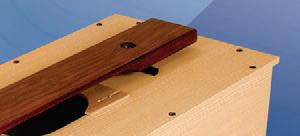

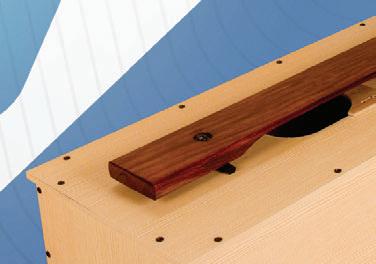
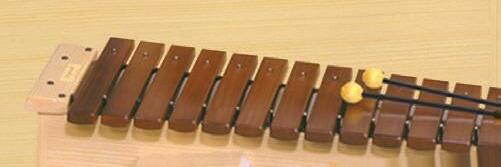
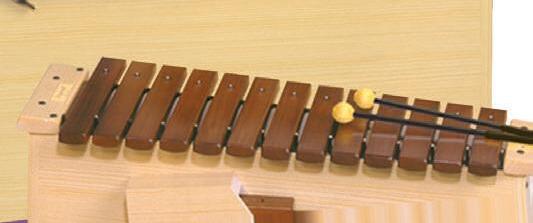


2. Metallophone bars are solid aluminum alloy similar to those use on professional vibraphones, cut wider and longer for best sound quality.
3. Glockenspiel bars are chromed steel, wider and longer for best sound quality.
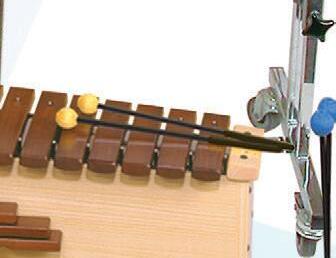

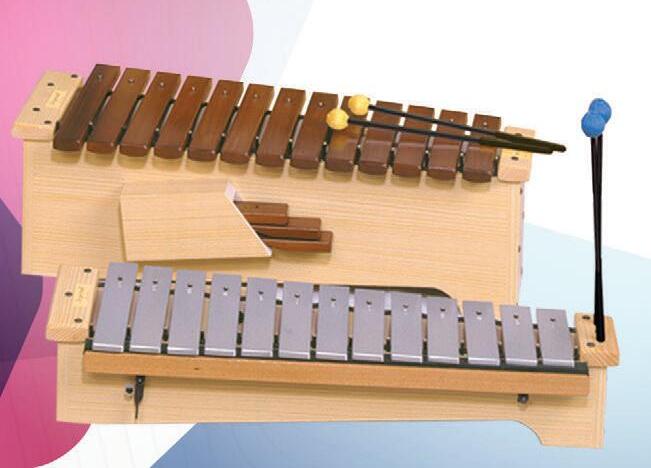
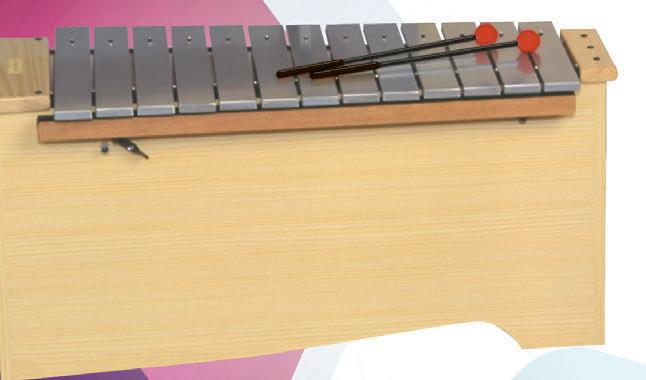
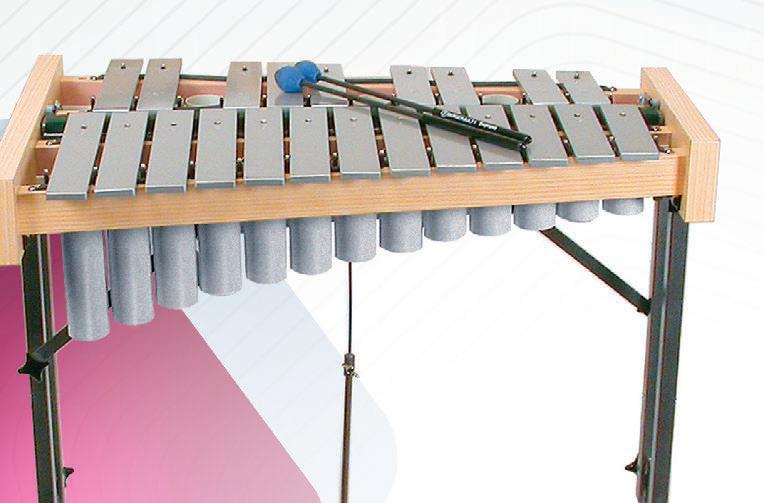
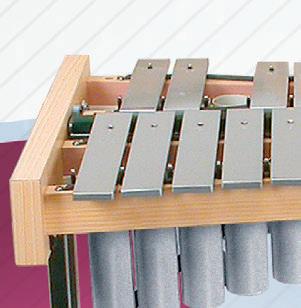

4. Solid wood frame, glued and screwed together in a sturdy design. Steel pegs covered by neoprene sleeves and solid neoprene cord under bars.
5. Overtone tuning, side boxes for sharps and flats, and damper bars on metallophones.
PERIPOLE.COM PARTNERS IN MUSIC EDUCATION Great Quality · Great Price
800.443.3592
My second thought as I write is that this is my final column as Elementary VicePresident. Almost every month, I brainstormed ideas before I sat down to write. I always had a topic in mind before I began, but that wasn’t the case this month. So, I took a trip down memory lane, reviewing the topics I wrote about.
Looking across these two years of content, some themes emerged, like how the most important thing we do is show up for our students and share our joy of music-making, even if we don’t always get everything right. And how in this profession, we’re often expected to do more with less, and how all any of us can do is simply offer our best with the resources we have. Through it all, there will be times when we might feel isolated in our job or have a sense that others don’t fully understand the depth of our impact. Those are the times we must reflect on why we chose this profession and let that carry us through. We love kids. We love music. And we love
helping our students develop the skills they need so that music can be part of their lives forever!
There will always be things we struggle with and things we try to improve in our classrooms. Sometimes I feel like I go on auto pilot and don’t truly see my students. I notice if they are facing forward and not talking, but sometimes I forget to make eye contact and smile. I have been guilty of showing a video of a concert or clip from a ballet as my mind drifted. I might have even checked my email on my phone. Today, however, I observed my students watching a three-minute clip of a scene from a ballet. I looked intently at their faces and reveled in seeing some of them enjoy this experience for the first time.
I hope that the past two years of my columns have given you some thoughts to consider, perhaps helped you in your work, and definitely let you know that you are not alone in your experience as an elementary music educator.
It has been an honor to serve as your 2021–2023 TMEA Elementary VicePresident. Thank you for this opportunity!
Miller’s Point ES Mini-Mojo
Mini-Mojo is ecstatic to represent Miller’s Point Elementary School and Judson ISD with their performance for the TMEA convention! This group of fourth and fifth graders is not auditioned, but rather screened for commitment and determination. They rehearse twice weekly after school and are led by Bonnie Anderson, who has been teaching for 30 years. MiniMojo plays high-energy Hispanic and Zimbabwean-influenced songs as well as cover tunes. The music is taught in a variety of ways that include rote, letters on posters, audio, visual, and hands-on. This allows students to quickly play music that is relevant and fires up their interest. They play on diatonic Zimbabwean-styled marimbas and a drum set.

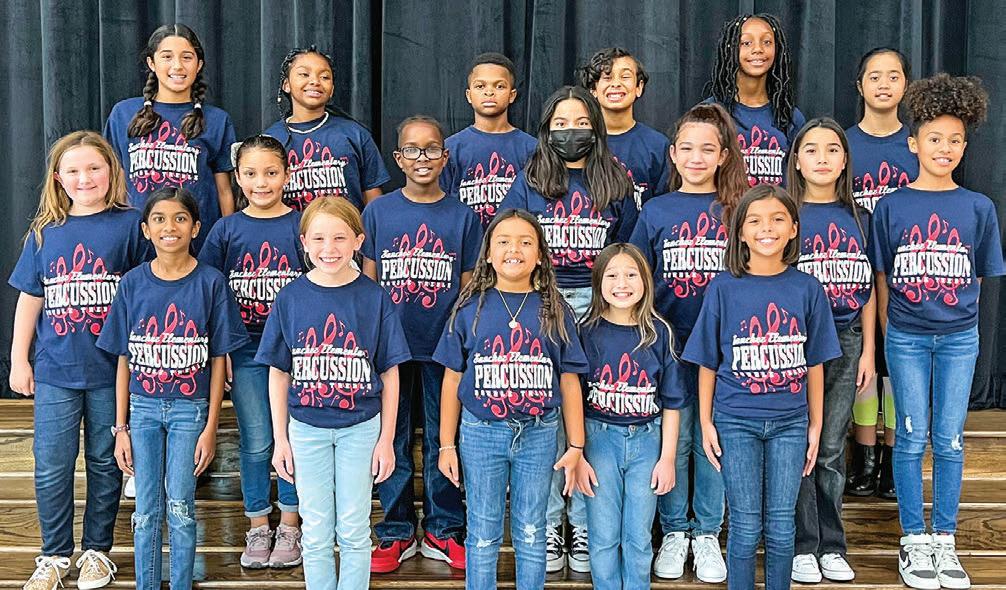
Sanchez ES Double Treble
Under the direction of Jennifer Mendez, Double Treble is an auditioned percussion group of fourth and fifth graders that was established at Sanchez Elementary School in Alvin ISD. This group dedicates time after school to learn a variety of pieces ranging in difficulty. Double Treble has become a staple in the Sanchez Elementary community and its surrounding areas. Their favorite performance venue is the The Galleria ice skating rink during the Christmas season. Double Treble is honored to have been selected to perform for the Texas Orff Chapters Meeting at the TMEA convention. They are determined to shine and excited to show their hard work through their performance. 0
Sanchez ES Double Treble
54 Southwestern Musician February 2023
Miller’s Point ES Mini-Mojo
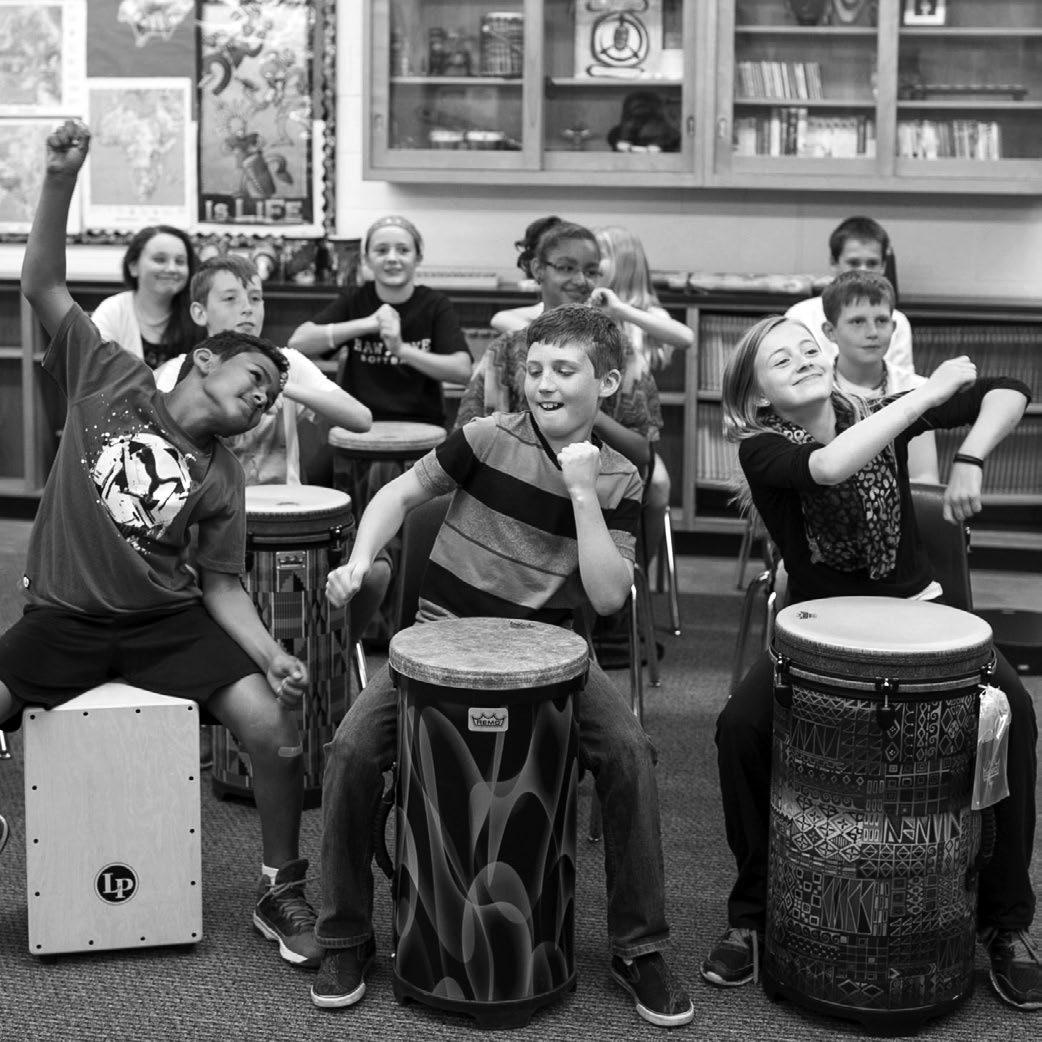
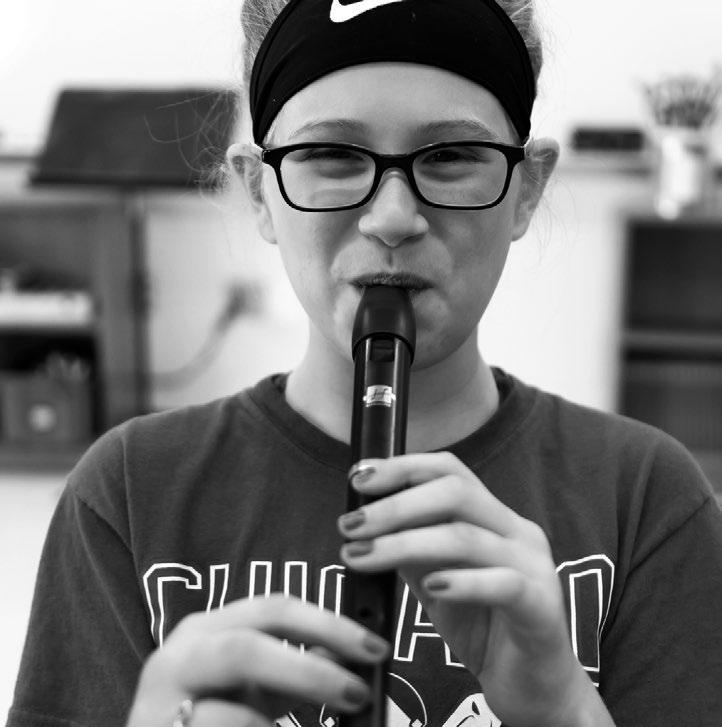

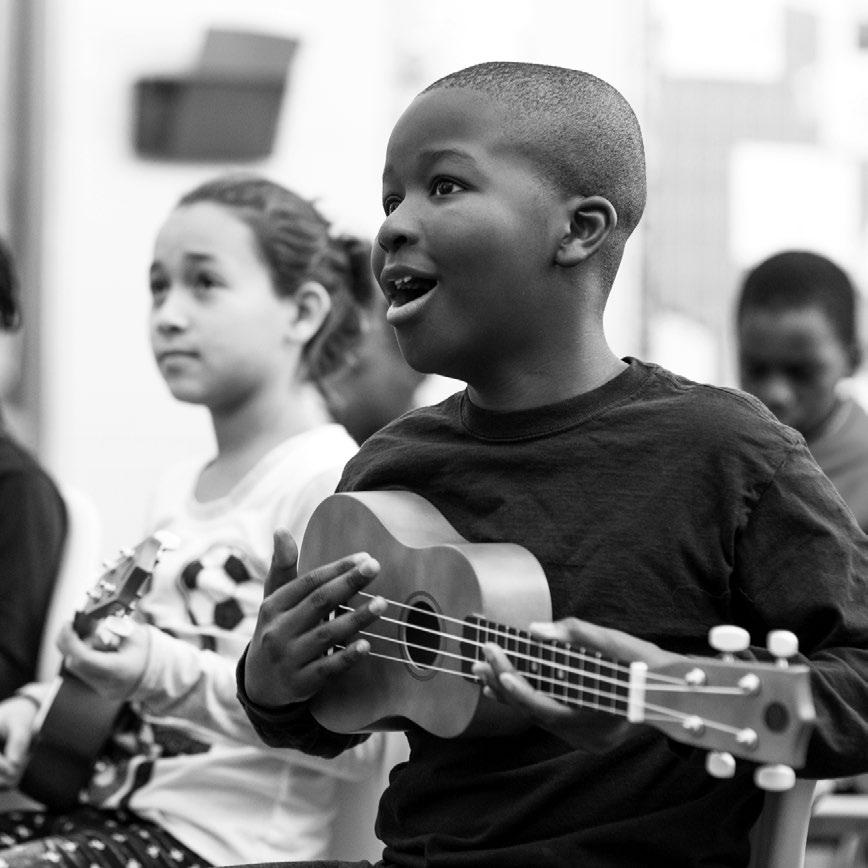
Make Music with West Music Contact us today! Call or email us at 800-397-9378 or educationconsultants@westmusic.com! See you at TMEA, booths #1427 and 1527!
Building Music Extensions with a T-TESS Mindset
BY EMILY LUCAS, ELAINE WAIER & LISA TREWIN
When someone mentions T-TESS , what comes to mind? Do you envision an appraisal process to be muddled through? Do you ever instead think about it being a helpful tool to empower teachers and students to engage with content in meaningful ways? We realize that might be difficult, yet in our experience, we have come to realize it can be true.
Within T-TESS are strategies that help teachers engage students in meaningful ways while empowering students to take ownership of the learning process. In this article, we explore five primary themes of T-TESS and demonstrate various ways to utilize these themes to extend songs and activities. The goal is not a higher appraisal score (although that may happen); the goal is to approach T-TESS from a student engagement standpoint. This can help create better learning opportunities for students and a more joyful experience for teachers.
T-TESS Themes
T-TESS can present a great deal of information to process and apply. To further its perceived complexity, it can often feel like the evaluation tool was designed specifically with foundation academic classrooms in mind. As with any challenging problem, we found the easiest way to tackle T-TESS was to break it down into central themes woven throughout its dimensions. The T-TESS
themes we will focus on here are assessment, student-led learning, differentiation, real-world application, and higher-order thinking skills. Each theme description provides a definition, if necessary, and primary points to keep in mind when applying the themes to your classroom.
Assessment can occur naturally or be intentionally inserted into an activity. It can be teacher-directed or student-driven, individual or in small groups, and should ideally be used to drive instructional practices.
Student-Led Learning allows students to take ownership of their learning process. It gives students opportunities to set goals, reflect, evaluate, and hold each other accountable. Using a model of “I Do” (teacher leads), “We Do” (teacher/students work together), and “You Do” (students take ownership), student-led learning can become a staple learning experience.
Differentiation aligns methods and techniques to various student needs. This theme allows students to show their knowledge of a concept in diverse ways. Differentiation can occur not just in the content but also in the process and final product.
Real-World Application is an effective way for students to make personal connections to the material. By allowing for concrete applications of life skills and cross-curricular connections, the content becomes more relevant to the student.
Higher-Order Thinking Skills aim for students to analyze,
56 Southwestern Musician February 2023
SCHOLARSHIP AUDITIONS
Scholarships are available for both music and non-music majors. These awards are intended to provide recognition for scholarship and talent in the study of music.
SCHOOL OF MUSIC DEPARTMENT HEADS
Douglas R. Boyer Director, School of Music and Director of Choral Activities dboyer@tlu.edu 830-372-6869 or 800-771-8521
Eric Daub Director of Piano Studies edaub@tlu.edu
SCHOLARSHIP AUDITION DATES:
Friday, February 17, 2023 | 1-3 p.m.
Saturday, March 25, 2023 | 1-3 p.m.
Saturday, April 15, 2023 | 1 - 3 p.m.
Individual audition dates may be requested if necessary.
For specific qualifications for each award, visit www.tlu.edu/music-scholarships.
BACHELOR OF MUSIC IN ALL-LEVEL MUSIC EDUCATION
BACHELOR OF MUSIC IN PERFORMANCE
BACHELOR OF ARTS IN MUSIC
Liliana Guerrero Director of Vocal Studies lguerrero@tlu.edu
Richard Herrera Interim Director of Bands riherrera@tlu.edu
Eliza Jeffords Director of Strings ejeffords@tlu.edu
FACULTY
Adam Bedell Instructor, Percussion
Carol Brittin Chambers
Composer in Residence & Composition
William Hayter
Asst. Professor, Clarinet & Music Education

Sean Holmes
Asst. Professor, Horn & Music History
Hilary Janysek Asst. Professor, Flute & Music History
Michael Keplinger
Instructor, Guitar
Elizabeth Lee
Asst. Professor, Cello
Ingram Lee, IV
Instructor, Trombone & Euphonium
Deborah Mayes
Choral Accompanist
Scott McDonald
Instructor, Saxophone, Jazz Band & Music Education
Carla McElhaney
Asst. Professor, General Music
David Milburn
Instructor, Double Bass
Angela Moretti
Instructor, Bassoon
Nicole Narboni
Asst. Professor, Piano
Daniel Orban
Instructor, Trumpet
Sung-Eun Park
Asst. Professor, Collaborative

Pianist
Keith Robinson
Instructor, Tuba & Music Education
Jill Rodriguez
Instructor, General Music
Eric Siu
Asst. Professor, Violin
Yu-Hsin Teng
Asst. Professor, Collaborative Pianist
Shareen Vader
Instructor, Piano & Music Education
Mika Valenzuela
Instructor, Oboe
Yvonne Vasquez
Instructor, Mariachi
TEXAS LUTHERAN UNIVERSITY SCHOOL OF MUSIC
www.tlu.edu/music
evaluate, and create. When analyzing, the learner will distinguish between different parts, not just between instruments or voice types, but also possibly different sections, themes, or rhythms. As the learner evaluates, they work to form an opinion and justify it (the what and the why). Ultimately, the gold standard is to get our students to create a new product or opinion.
Why Apply These Themes?
We know you are busy, and the last thing you want is yet another to-do list item. If the main goal is not a higher appraisal score, then why take extra time to apply these themes? At its core, T-TESS is about student-centered learning, and these themes help create a more studentfocused classroom. This kind of learning environment can generate higher levels of student engagement. This can translate to fewer behavior issues, better results, more enjoyment, and greater confidence from your students and you.
When you begin looking at activities through a T-TESS mindset, you may find that extensions naturally occur, or some may be more challenging to identify. As you become more familiar with them, you will start recognizing when those extensions are already taking place. For example, you might have varying ways for students to adapt a musical concept to their level, but you simply haven’t labeled it differentiation
An added benefit of applying these themes is a deeper exploration of a concept or activity. Consequently, students have a greater likelihood of mastering an objective, and there is a higher chance of reaching their diverse learning needs.
Let’s Build Extensions
There are two main ways to approach extensions. You could start with a theme and apply it to an activity you are already familiar with or are teaching. Instead, you might start with a specific activity and find a theme that best fits within the context of the activity.
To start with a theme and extend, identify an area you want to incorporate into your lesson. Let’s use assessment as an example. You may find that certain activities already have assessment embedded (e.g., a singing game with a solo), or you might consider adding assessment into an activity (e.g., in between each refrain, add a small section to assess a few students on a skill).
Conversely, you could start with an activity and find a theme that fits. The music may include natural connections to a T-TESS theme (e.g., real-world application of money in the song), or you may have to modify the activity to fit themes (e.g., adding an ostinato for differentiation). Be creative in your approach and remember that not every activity will tie into every T-TESS theme.
1849 University Ave. Berkeley, Ca 94703 800-322-6263 510-845-7178
www.forrestsmusic.com
Instruments Accessories
Rental Repair
Extensions in Activities
Rhythm work is crucial in every group or ensemble, from elementary to secondary, and it can involve more than just flashcard drills. You can start moving toward a student-led model by first having students read given rhythms (I do). Have the students modify the given rhythms as a class (we do). Finally, have students create or alter a short phrase on a notecard (you do). Add a kid-appropriate pop song as a backing track for a little extra joy.
While moving toward the student-led model, take advantage of moments that lend themselves to assessment. Using these notecards in a transition or as a part of an activity, have a small group or individual read the rhythms. The teacher can then assess the students or have the students self-assess their learning using an established rating tool.
Students can create or modify rhythm cards to use higher-order thinking skills. The activity can be differentiated by having students choose a card based on their readiness with the various patterns. You can also have students transfer the rhythm patterns to instruments within a specific range (e.g., pentatonic), allowing the students to experience the highest levels of thinking skills. By slowly scaffolding elements throughout the year, you can tailor the activity to the needs of your ensembles while incorporating consistent creation and sightreading practice.
In elementary education, a core practice is utilizing singing games. For many, the phrase “We’ve sung the song, we’ve played the game, now what?” might resonate. By using T-TESS themes, we can elevate a singing game to a new level of learning.
Let’s look at “Charlie Over the Ocean,” often a focus in second and third grades. This singing game naturally lends itself to teacher assessment. As students grow familiar with the song, they become the song leader or “Charlie” and the class echoes. The teacher can assess the singing skills of each student song leader. Add a fun twist to the game and create additional assessment opportunities by changing the song’s last line from “Can’t catch me!” to “Can you copy me?” Then students could read and copy rhythm or solfège cards or perform aural echoes.
Create a fishing game with a money menu for a real-world application twist. The student who is it gets to fish from a pool in the middle of the circle. The fish is
Your one stop shop for all things double reed since 1944 58 Southwestern Musician February 2023
JOIN OUR
The University of Central Arkansas Department of Music is an artistic community of approximately 220 music majors who participate in over 25 music ensembles, including the spirited Bear Marching Band, the electrifying Conway Symphony Orchestra, the award-winning Concert Choir, and numerous other large and small ensembles. Music ensembles have traveled to Spain, Japan, England, Italy, China, Austria and New York City.

• Graduate assistanceships available
• Out-of-state tuition fees waived
• Music scholarships available
UNDERGRADUATE DEGREES
• Bachelor of Arts in Music
• Bachelor of Music in Composition
• Bachelor of Music in Jazz and Studio Music
• Bachelor of Music in Performance – Instrumental Studies
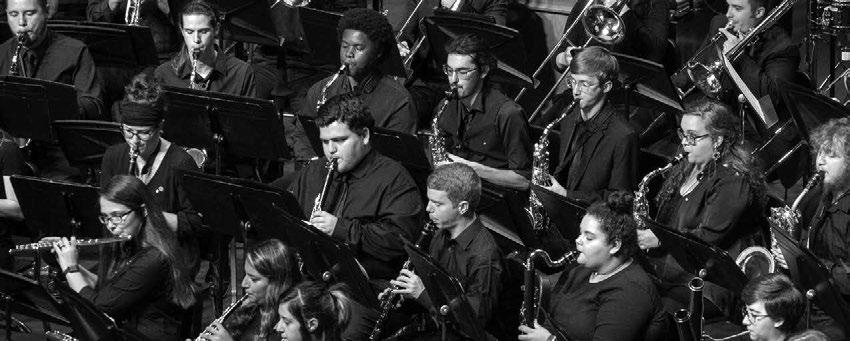
• Bachelor of Music in Performance – Piano Studies
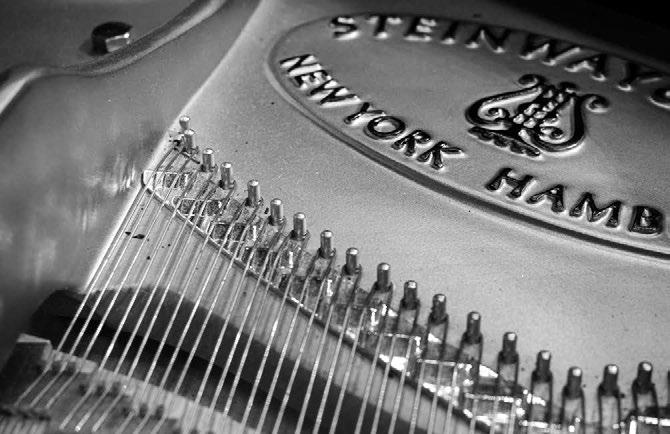

• Bachelor of Music in Performance – Vocal Studies
• Bachelor of Music in Piano Pedagogy
• Bachelor of Music Education – Instrumental Studies
• Bachelor of Music Education – Piano Studies
• Bachelor of Music Education – Vocal Studies
• Minor in Music
GRADUATE DEGREES
• Master of Music in Music Education
• Master of Music in Instrumental Performance
• Master of Music in Piano Performance
• Master of Music in Vocal Performance
• Master of Music in Instrumental Conducting
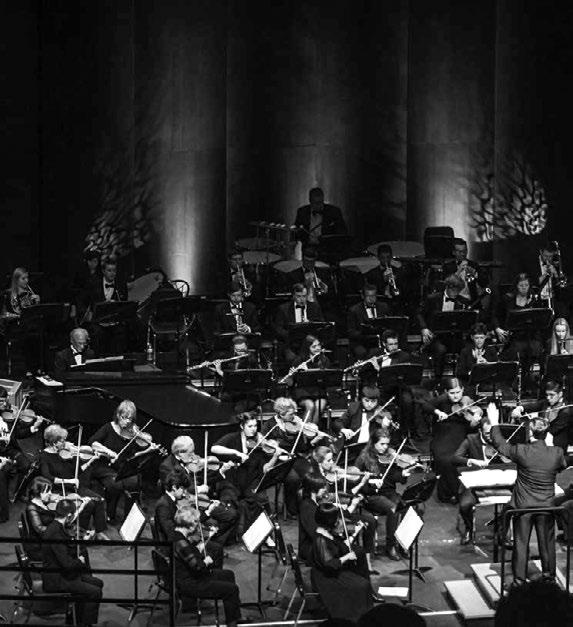
• Master of Music in Choral Conducting
• Master of Music in Music Theory
• Graduate Certificate in Music (Professional Studies)
vibrant community of award-winning ensembles.
MORE
LEARN
UCA.edu/MUSIC
worth a certain amount of money. To buy it, the student must create change from a money bank and give it to the teacher.
Another real-world extension would be to challenge your students to change the habitat. They must then catch an animal found in that habitat. Charlie could be in a forest catching a fox or in the arctic catching a polar bear.
At the secondary level, ensemble rehearsals are typically the focus. T-TESS themes can be a benefit to these whole group instructional moments as well. You may even find that your group becomes better prepared and creates a better product when the students have more ownership and engagement in the process. So, let’s label things you might already be doing in your classroom.
Differentiation can occur in many ways, not just in the product. Consider differentiating the feedback you give students depending on their instrument or voice type. You might also differentiate the content by adapting passages to meet individual needs (e.g., simplifying technical passages).
Assessment practices in secondary ensembles are typically teacher-driven. You might consider adding moments of student self-assessment where the student uses a rating scale to demonstrate their understanding or comfort level with the material. This self-assessment feedback can then be used to inform future instruction.
Adding in a real-world connection may seem challenging on the surface. However, look for ways to connect your ensemble’s music to your students’ frames of reference. Discuss what may have driven the composer to write the piece. Use kid descriptions or language to decode the emotion or concept in the piece. Creating context and finding moments of personal connection can increase the emotional connection to the piece, composer, or final product.
Now, let’s look at moving from a conductor-led rehearsal (affectionately known as the sit-and-get) to one in which students are allowed to take the lead in their learning. Ownership can happen by giving students opportunities to lead their peers. Student leadership opportunities can include leading sectional rehearsals, permitting a player to lead a short passage with a sectional or the full ensemble, or allowing students to decide which areas
of music need to be the focus of rehearsal time. Ultimately, ask yourself how often you allow students to have a voice in their musical experience.
Have your students engage in higherorder thinking strategies by analyzing and evaluating passages, daily rehearsals, or performances. Students can compare themselves to another group, section, or the full ensemble. Encourage your students to listen critically and give themselves and others constructive feedback. Ask them how a piece makes them feel as they play it or as an audience member listening to it. Further extend by having them justify their stance. Students can also diagnose section or ensemble problems and present suggestions for improvement.
The Takeaway
Understanding and applying these T-TESS themes takes time and practice. Perhaps select a theme and try to incor-
porate it throughout the year. You could decide to update an oldie but a goodie by using multiple themes to extend your favorite activities. Don’t be afraid to start small. Just start.
By slowly changing your mindset to see T-TESS as a positive teaching tool, you can create a more effective and engaging classroom for you and your learners. 0
Emily Lucas teaches music at Wolman Elementary in Katy ISD.
Elaine Waier is Curriculum Coordinator for Elementary Music and P.E. at CypressFairbanks ISD.


Lisa Trewin teaches music at McGown Elementary in Cypress-Fairbanks ISD.

We Are Excited to See All Our Friends at TMEA 2023
Start where you are. Use what you have. Do what you can. —Arthur Ashe
61 Southwestern Musician February 2023
TMEA College Vice-President
MATTHEW MCINTURF
Supporting Our Future Educators
Working selflessly with our students sets an invaluable example for future generations and distinguishes our profession from many pursuits competing for public attention.
For most of us, the semester break was a wonderful time to rest and a welcome pause before resuming our busy schedules. It was also important for our students, who needed to collect themselves from the work of the fall term. As we continue to navigate the pandemic, I know we all sense the additional pressure and stress our students feel in the academic environment.
Many of our students will embark on their internship semester as student teachers. As we continue to engage with regulatory agencies about certification and testing, we need to remember and communicate how successful our partnerships with public schools have been in preparing the next generation of music teachers. Throughout Texas, thousands of practicing educators agree to mentor students in this critical process. They invest countless hours, complete arduous paperwork, and entrust their students to prospective teachers. For most young people, this is a seminal experience in their path to becoming accomplished teachers.
Student teaching was a life-changing experience for me. I was fortunate to be placed in Richardson ISD with Bob Brandenberger and Malcolm Helm, each of whom became friends and mentors for my subsequent career. Their interest in me, and the experience and counsel they provided, gave me an extraordinary perspective on the possibilities of a career in music education. Now, after more than 40 years as an educator, I am more grateful than I knew how to be at the time for their investment and guidance. It is inconceivable to me that I could have been a successful educator without their work, dedication, and concern for the future of our profession. Their encouragement and advice sustained me during difficult times and opened professional doors I didn’t know existed.
Mentoring a student teacher may have a significant benefit for the
MARK
YOUR CALENDAR
February—Renew your membership and register for the convention.
February 8–11 —TMEA Clinic/Convention in San Antonio.
February 9, 8:15 a.m.—TMEA General Session in Lila Cockrell Theatre.
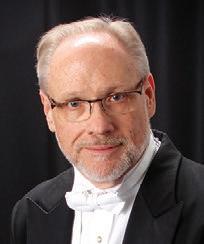
February 9, 3:30 p.m.—College Division Research Poster Session.
February 9, 5:15 p.m.—College Division business meeting at the convention.
February 10, 5:15 p.m.—TMEA Region meetings at the convention. check www.tmea .org for updates 62 Southwestern Musician February 2023
School of Music
TCU is your school.
is now open!
Scholarship Opportunities Available For You
NORDAN Scholarship
instrumentalists, and composers of superior talent , who have chosen to major in music.
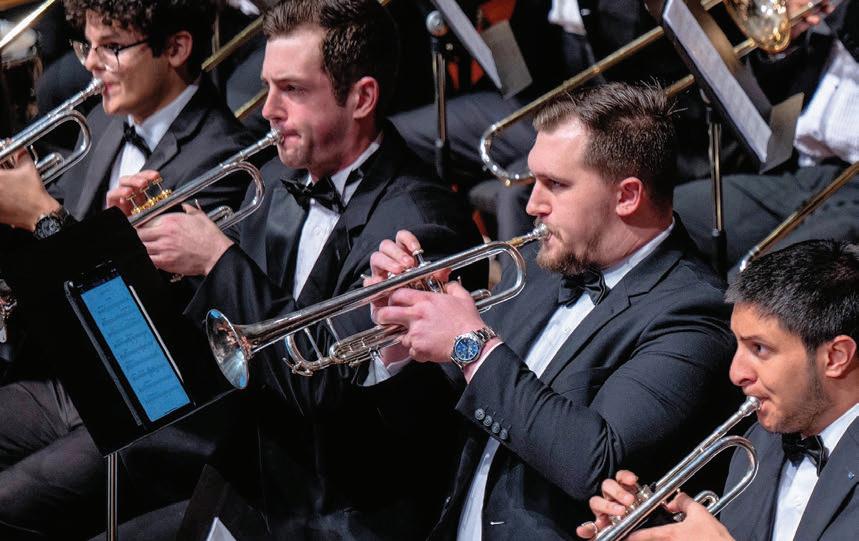
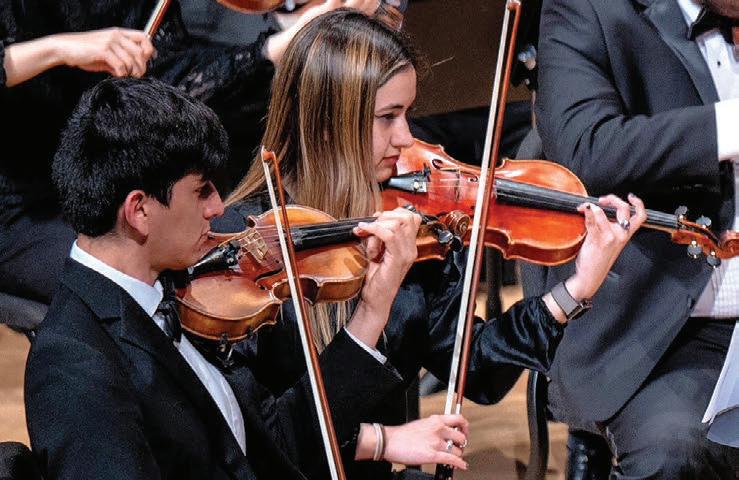
NORDAN winners receive a four-year, FULL-TUITION AWARD.
NORDAN Auditions are by special invitation.
January 14, 2023 - Nordan Scholarship*
More information is available online at ww w.music.tcu.edu.
*Pre-screening Video Audition Required
AUDITION DATES FOR SPRING 2023
January 21 // February 4 // February 18
February 1, 2023 - General Application Deadline (final deadline).
Graduate Programs Available For You
disciplines. Graduate Assistantships are available.
MUSIC.TCU.EDU/ADMISSIONS
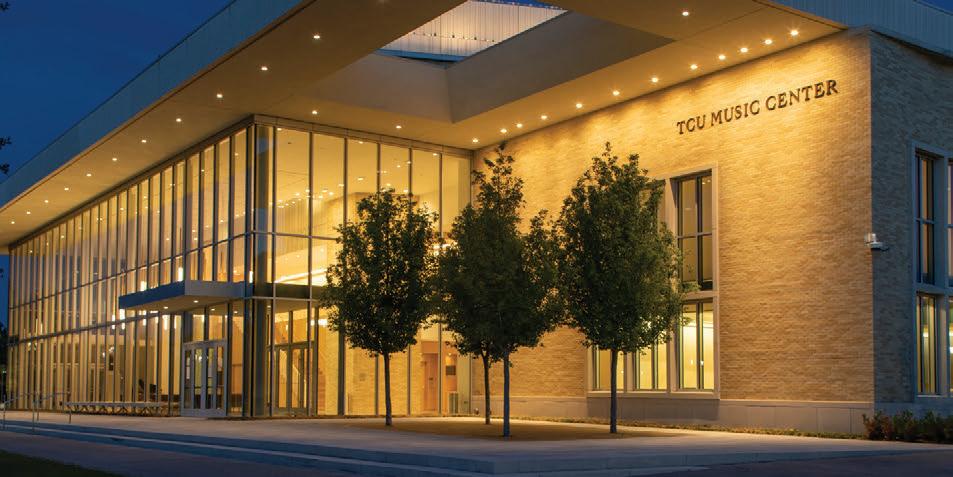
Watch all of our events on YouTube!

If music is your passion,
The Van Cliburn Concert Hall at TCU
cooperating teacher. As a high school teacher, I invested in many student teachers who had a significant impact on my work. Several excellent student teachers have continued to have successful careers in our profession. They are now among those I regard as mentors and important colleagues. One of the reasons I decided to pursue a university position is that I discovered I loved mentoring young teachers. I see the same kinds of friendships and relationships developing between our students and their public school mentors, and I believe it speaks to the health of our profession, even in a very difficult time.
As difficult as the pandemic has been, I continue to be deeply impressed by our public school partners who remain committed to helping the next generation of teachers. While struggling to adapt to remote learning and extraordinary time demands, they still engaged deeply with our student teachers. Working selflessly with our students sets an invaluable example for future generations and distinguishes our profession from many pursuits competing for public attention.
A significant concern in the ongoing certification and testing discussion is that a new testing method could negatively impact the observation and student teaching component. I worry that the extraordinary value of the process we have developed is not fully appreciated by those advocating for different assessment tools. Teaching requires human interaction and time on task. Our students must interact meaningfully with professionals who understand education and are committed to the process and the future. I’m grateful
that TMEA is committed to communicating this work’s importance and success to those shaping this discussion.
TMEA Clinic/Convention Update

I’m looking forward to our convention, which will begin in just a few days. If you have not made plans to attend, please consider joining us in San Antonio on February 8–11. I’m confident this will be an excellent meeting that is valuable for university faculty and students. TMEA brings together people involved in music education from every discipline and point of view. There will be growth opportunities and more than a little good fellowship for us all. The College Division will be well represented.
I hope you have read the articles by our featured clinicians, Karin Hendricks and Rachel L. Dirks, published in previous editions of Southwestern Musician These wonderful presenters will bring to our convention many ideas specific to this very unusual time, while reflecting timeless principles of teaching and humanity. I know many of you are familiar with their work and share my enthusiasm for the opportunity to engage with them at our meeting. Please encourage your students to attend these sessions as well.
Our College Division sessions will cover a wide variety of topics and bring tremendous resources to our membership. I’m grateful to all who applied to present and to those who contributed to the Clinic Review Committee. They recommended an interesting and diverse program. Looking to the future, I want to encourage all the members of our division to consider
applying to present a session. If you submitted a proposal that was not accepted this year, don’t be discouraged. Often worthy proposals are not accepted to ensure a variety of offerings—an essential element of every convention. Each year’s review cycle begins anew, and there is always a need for strong presentations from an interesting and thoughtful perspective.
A look at this year’s program will reveal that the College Division is represented well throughout the convention. Many of our members are presenting in the other divisions, and many of our College Division sessions have been cross-listed as applicable for multiple divisions. Sharing thoughts and ideas across the greater membership is an essential strength of our organization. The TMEA convention offerings address more topics and reach more people than any comparable meeting.
Of course, there will be much more to the convention than presentations. Outstanding ensembles from every division will perform and many of our College Division colleagues will offer music showcase presentations. I always recommend that my students attend rehearsals of the All-State ensembles. I believe it is important for them, including the ones who participated as secondary students, to see the process from an educator’s point of view.
We will certainly not neglect the opportunity to connect with our colleagues across the state and to share a meal in San Antonio. I always enjoy our Friday night alumni reunion. It is a great pleasure to talk with our students who have become our professional colleagues and to celebrate their successes.
Please also plan to attend the College Division business meeting on Thursday, February 9, at 5:15 p.m. Our meeting will be held in CC 206—a new location from the past few years. We will discuss new initiatives, the state of our division, and receive an update on the legislative and regulatory concerns in the current session of the legislature.
If you arrive Wednesday, be sure to attend the free TMEA President’s Concert featuring the Singing Sergeants of the U.S. Air Force Band. This concert is in Lila Cockrell Theatre at 8 p.m. and there are no tickets to enter (general admission seating).
I look forward to seeing you in San Antonio! 0
Pedagogical Clinics • Research Poster Session College Meeting • Extraordinary Concerts Networking Opportunities • Huge Exhibit Hall Attend the TMEA Clinic/ Convention! 64 Southwestern Musician February 2023
Texas Tech University School of Music TMEA 23
WEDNESDAY, FEB 8
TMEA ALL-STATE BAND SECTIONALS
Featured Faculty:
James T. Decker, Associate Professor of Trombone
Richard Meek, Professor of Bassoon
David Shea, Professor of Clarinet
Christopher M. Smith, Professor of Horn
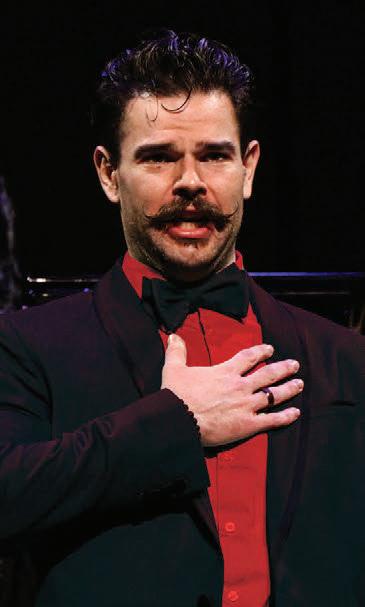
Kevin Wass, Professor of Tuba and Euphonium
3-4 pm
MAKE YOUR SOFTWARE SING! BEST TECHNOLOGY FOR CHOIR Location: CC 214D
Clinician: Keith Dye, Professor of Music Education
THURSDAY, FEB 9
10-11 am
12 COMMON ERRORS MUSIC STUDENTS MAKE Location: CC 225
Clinician: Mark Morton, Professor of Double Bass
11:30 am-12:30 pm
MUSICING, TEACHING, AND THRIVING THROUGH A PANDEMIC Location: CC 207
Clinician: Jacqueline Henninger, Associate Professor of Music Education
11:30 am-12:30 pm
HOW TECHNOLOGY CAN ENHANCE YOUR PROGRAM: LESSONS FROM THE PANDEMIC Location: CC 216
Clinician: Keith Dye, Professor of Music Education
5-7 pm
(Subject to Change)
TTU PERCUSSION CELEBRATION RECEPTION; TRIBUTE TO ALAN SHINN Location: Marriott Rivercenter
Host: TTU School of Music
6:30-7:30 pm
NAVIGATING THE BERMUDA TRIANGLE OF CLARINET FUNDAMENTALS Location: CC Hemisfair Ballroom 3
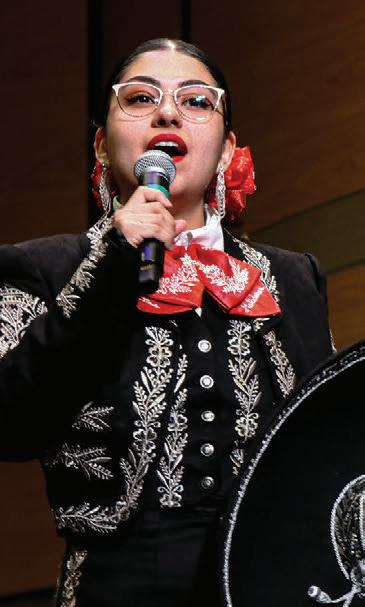
Clinician: David Shea, Professor of Clarinet
FRIDAY, FEB 10 10-11 am
COME AND SING! SONGS AND GAMES TO BRING US BACK TOGETHER Location: Grand Hyatt 4th Fl
9:30-11:30 pm
SCHOOL OF MUSIC ALUMNI REUNION
Location: Marriott Rivercenter, Salon AB
Host: Texas Tech University School of Music

SATURDAY, FEB 11
8-9 am
THE INCLUSIVE MUSIC STUDIO Location: CC 206
Clinician: Lisa Garner Santa, Professor of Flute
In Collaboration: Breanna Engelhardt, PresiderFirst Colony MS
9-10 am
Clinicians: Lisa Rogers, Professor of Percussion
Studies, Michael Mixtacki, Lecturer of Percussion
Guest Soloist: Stephen Jones, Associate Professor of Jazz Studies
TTU STEEL DRUM BAND AND AFRO-SAMBA ENSEMBLE Location: CC Bridge Hall Music Showcase 11 am-12 pm
NAFME-TEXAS ANNUAL MEMBERSHIP MEETING Location: TBA
Co-Clinician and Past President: Jacqueline Henninger, Associate Professor of Music Education
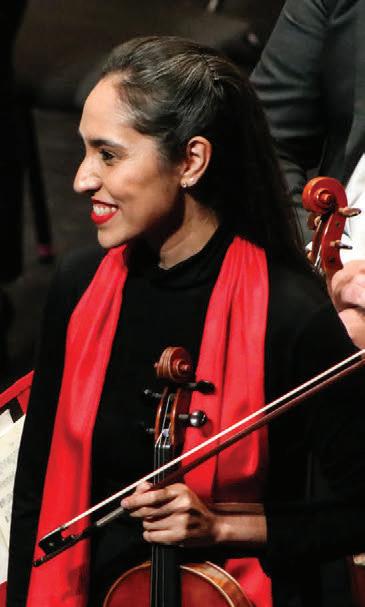
3:30-4:00 pm
TETRAUQ SAXOPHONE QUARTET Location: CC North Lobby Music Showcase
Clinician: Music Education Clinician: David Dees, Professor of Saxophone
Guest: Deb Confredo (President-Elect, NAfME)
AUDITION DATES
Saturday, Feb. 18, 2023
Saturday, Mar. 4, 2023
Recorded and remote auditions are available for select instruments.
ttu.edu/Music | schoolofmusic@ttu.edu | 806.742.2270
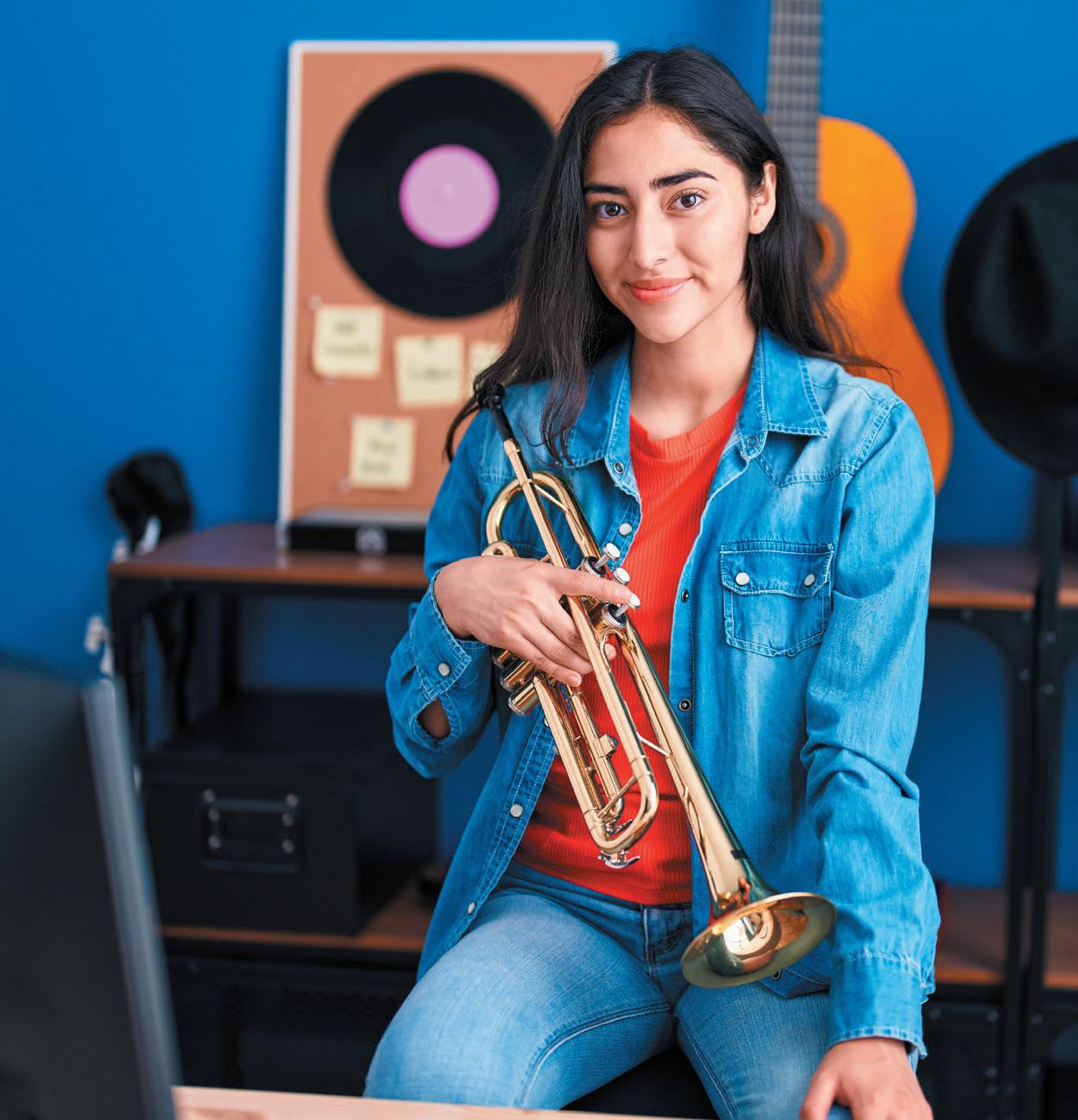

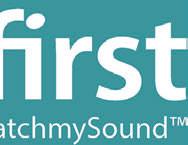
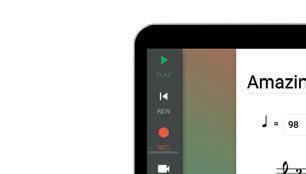
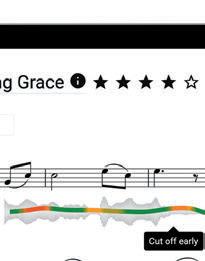
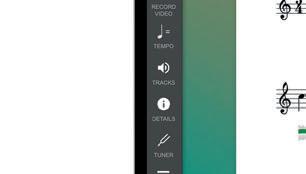
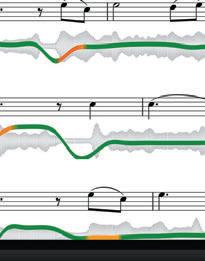

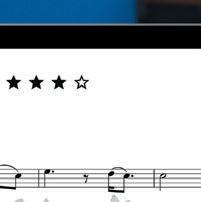
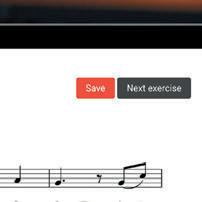


















Bandworks Publications • Boosey & Hawkes • C.L. Barnhouse Company • Excelcia Music Publishing G. Schirmer, Inc. • GIA Publications, Inc. • Grand Mesa Music Publishers • Grand Mesa Strings • John McAllister Music • Kendor Music Publishing • Neil A Kjos Music Company • PDF Band Music • Piquant Press • Queenwood Publications • RBC Publications • Randall • Standridge Music Publications • Ed Music Publications • Tempo Press • Wingert-Jones Publications • YourScore • Bandworks Publications •Boosey & Hawkes • C.L. Barnhouse Company • Excelcia Music Publishing • G. Schirmer, Inc. • GIA Publications, Inc. • Grand Mesa Music Publishers • Grand Mesa Strings • John McAllister Music Kendor Music Publishing • Neil A Kjos Music Company • PDF Band Music • Piquant Press • Queenwood Publications • RBC Publications • Randall • Standridge Music Publications • Ed Sueta Music Publications Barnhouse Company • Excelcia Music Publishing • G. Schirmer, Inc. • GIA Publications, Inc. • Grand Mesa Music Publishers • Grand Mesa Strings • John McAllister Music • Kendor Music Publishing • Neil Kjos Music Company • PDF Band Music • Piquant Press • Queenwood Publications • RBC Publications Randall • Standridge Music Publications • Ed Sueta Music Publications • Tempo Press • Wingert-Jones Publications • YourScore • Bandworks Publications • Boosey & Hawkes • C.L. Barnhouse Company Excelcia Music Publishing • G. Schirmer, Inc. • GIA Publications, Inc. • Grand Mesa Music Publishers Grand Mesa Strings • Kendor Music Publishing • Neil A Kjos Music Company • PDF Band Music • Piquant Press • Queenwood Publications • RBC Publications • Randall • Standridge Music Publications • Ed usic Publications • Tempo Press • Wingert-Jones Publications • YourScore • Bandworks Publications Strings • GIA Publications, Inc. • Kendor Music Publishing • Neil A Kjos Music Company • PDF Band Music • Piquant Press • Queenwood Publications • RBC Publications • Randall • Standridge Music Publications • Ed Sueta Music Publications • Tempo Press • Wingert-Jones Publications • YourScore• Bandworks Publications • Boosey & Hawkes • C.L. Barnhouse Company • Excelcia Music Publishing G. Schirmer, Inc. • GIA Publications, Inc. • Grand Mesa Music Publishers • Grand Mesa Strings • John McAllister Music • Kendor Music Publishing • Neil A Kjos Music Company • PDF Band Music • Piquant Press • Queenwood Publications • RBC Publications • Randall • Standridge Music Publications • Sueta Music Publications • Tempo Press • Wingert-Jones Publications • YourScore • C.L. Barnhouse Company • Excelcia Music Publishing • G. Schirmer, Inc. • GIA Publications, Inc. • Grand Mesa Music Publishers • Grand Mesa Strings • John McAllister Music • Kendor Music Publishing • Neil A Kjos Music Company • PDF Band Music • Piquant Press • Queenwood Publications • RBC Publications • Randall Practice made perfect. Standridge Music Publications • Ed Sueta Music Publications • Tempo Press • Wingert-Jones Publications Try PracticeFirst FREE for 30 days Available exclusively from Find your favorite method books and repertoire in the newly-expanded Prac ticeFirst library.


 by michelle christner and
griswold
by emily lucas , elaine waier , and lisa trewin
by michelle christner and
griswold
by emily lucas , elaine waier , and lisa trewin



 MICHAEL STRINGER
MICHAEL STRINGER
















































































 Argyle HS Wind Ensemble
Hornedo MS Jazz Ensemble
Argyle HS Wind Ensemble
Hornedo MS Jazz Ensemble




























































































 KATHERINE JOHNS
KATHERINE JOHNS





















































































